 Abengoa
Abengoa
Annual Report 2013
- Legal and Economic-Financial Information
- Consolidated financial statements
- Notes to the consolidated financial statements
Notes to the consolidated financial statements
Note 1.- General information
Abengoa, S.A. is the parent company of the Abengoa Group (referred to hereinafter as ‘Abengoa’, ‘the Group’ or ‘the Company’), which at the end of 2013, was made up of 578 companies: the parent company itself, 534 subsidiaries, 19 associates and 24 joint ventures. Additionally, as of the end of 2013, certain subsidiaries were participating in 227 temporary joint operations (UTE) and, furthermore, the Group held a number of interests, of less than 20%, in several other entities.
Abengoa, S.A. was incorporated in Seville, Spain on January 4, 1941 as a Limited Liability Company and was subsequently transformed into a Limited Liability Corporation (‘S.A.’ in Spain) on March 20, 1952. Its registered office is Campus Palmas Altas, C/ Energía Solar nº 1, 41014 Seville.
The Group’s corporate purpose is set out in Article 3 of its Bylaws. It covers a wide range of activities, although Abengoa is principally an applied engineering and equipment manufacturer, providing integrated project solutions to customers in the following sectors: energy, telecommunications, transport, water utilities, environmental, industrial and service.
On October 17, 2013 Abengoa carried out a capital increase of 250,000,000 class B shares and on October 29, 2013 the Company issued, as a result of the exercise of the option to purchase additional shares to cover over-allotment by the underwriters of the capital increase, 37,500,000 additional Class B shares (‘greenshoe’ option).
Abengoa’s shares are represented by class A and B shares which are listed on the Madrid and Barcelona Stock Exchanges and on the Spanish Stock Exchange Electronic Trading System (Electronic Market). Class A shares have been listed since November 29, 1996 and class B shares since October 25, 2012. Additionally, Class B shares are also listed on the NASDAQ Global Select Market in the form of American Depositary Shares from October 29, 2013 as mentioned above (see Note 18) The Company presents mandatory financial information quarterly and semiannually.
Abengoa is an international company that applies innovative technology solutions for sustainability in the energy and environment sectors, generating electricity from renewable resources, converting biomass into biofuels and producing drinking water from sea water. The Company supplies engineering projects under the ‘turnkey’ contract modality and operates assets that generate renewable energy, produce biofuel, manage water resources, desalinate sea water and treat sewage.
Abengoa`s activity and the internal and external management information are organized under the following three activities:
- Engineering and construction: includes our traditional engineering activities in the energy and water sectors, with more than 70 years of experience in the market and the development of thermo-solar technology. Abengoa is specialized in carrying out complex turn-key projects for thermo-solar plants, solar-gas hybrid plants, conventional generation plants, biofuels plants and water infrastructures, as well as large-scale desalination plants and transmission lines, among others.
- Concession-type infrastructures: groups together the company’s extensive portfolio of proprietary concession assets that generate revenues governed by long term sales agreements, such as take-or-pay contracts, tariff contracts or power purchase agreements. This activity includes the operation of electric (solar, cogeneration or wind) energy generation plants and transmission lines. These assets generate low demand risk and the Company focuses on operating them as efficiently as possible.
- Industrial production: covers Abengoa’s businesses with a commodity component, such as biofuels and industrial waste recycling (until the sale of shareholding in Befesa Medio Ambiente, S.L.U. (Befesa), see Note 7.1). The Company holds an important leadership position in these activities in the geographical markets in which it operates.
These Consolidated Financial Statements were approved by the Board of Directors on February 20, 2014.
All public documents on Abengoa may be viewed at www.abengoa.com.
Note 2.- Significant accounting policies
The significant accounting policies adopted in the preparation of the accompanying Consolidated Financial Statements are set forth below:
2.1. Basis of presentation
The Consolidated Financial Statements as of December 31, 2013 have been prepared in accordance with International Financial Reporting Standards adopted by de European Union (IFRS-EU) and they present the Group’s equity and financial position as of December 31, 2013 and the consolidated results of its operations, the changes in the consolidated net equity and the consolidated cash flows for the financial year ending on that date.
Unless otherwise stated, the accounting policies set out below have been applied consistently throughout all periods presented within these Consolidated Financial Statements.
The Consolidated Financial Statements have been prepared under the historical cost convention, modified by the revaluation of certain available-for-sale non-current financial assets under IFRS 1 and with the exception of those situations where IFRS-EU requires that financial assets and financial liabilities are valued at fair value.
The preparation of the Consolidated Financial Statements under IFRS-EU requires the use of certain critical accounting estimates. It also requires that Management exercises its judgment in the process of applying Abengoa’s accounting policies. Note 3 provides further information on those areas which involve a higher degree of judgment or areas of complexity for which the assumptions or estimates made are significant to the financial statements.
The amounts included within the documents comprising the Consolidated Financial Statements (Consolidated Statement of Financial Position, Consolidated Income Statement, Consolidated Statement of Comprehensive Income, Consolidated Statement of Changes in Equity, Consolidated Cash Flow Statement and notes herein) are, unless otherwise stated, all expressed in thousands of Euros (€).
Unless otherwise stated, any presented percentage of interest in subsidiaries, joint ventures (including temporary joint operations) and associates includes both direct and indirect ownership.
2.1.1. Application of new accounting standards
a) Standards, interpretations and amendments effective from January 1, 2013 under IFRS-EU, applied by the Group:
- IFRS 13 ‘Fair value measurement’. IFRS 13 defines fair value, sets out a framework for measuring fair value in a single IFRS and requires disclosures about fair value measurements.
According to IFRS 13, this standard has been applied prospectively from the beginning of the annual period in which it is initially applied. The disclosure requirements of this IFRS do not need to be applied to compare information provided for periods prior to the initial application of this IFRS.
The main impact relates to the measurement of the financial derivatives that the Group has, including call options on Abengoa’s own shares that were signed to hedge the convertible notes as well as the embedded derivative in the convertible notes (see Note 14). This impact is not significant on the Consolidated Financial Statements. - International Accounting Standard (IAS) 1 (amendment) ‘Financial statements presentation’. The main change resulting from this amendment is a requirement to group items presented in ‘other comprehensive income’ (OCI) into two categories on the basis of whether or not they will be subsequently reclassified to profit or loss (reclassification adjustments).
b) In preparing these Consolidated Financial Statements as of December 31, 2013, the Group has applied the following new standards and amendments that came into effect on January 1, 2013 under the IFRS approved by the International Accounting Standards Board, hereinafter
- IFRS-IASB (January 1, 2014 under IFRS-EU), and which have been early applied under IFRS-EU:
- IFRS 10, ‘Consolidated Financial Statements’. IFRS 10 supersedes current consolidation requirements of IAS 27 and establishes principles for the presentation and preparation of Consolidated Financial Statements when an entity controls one or more other entities. IFRS 10 modifies the former definition of control. The new definition of control sets out the following three elements: power over the investee; exposure, or rights, to variable returns from involvement with the investee; and the ability to use power over the investee to affect the amount of the investor’s returns.
- IFRS 11 ‘Joint Arrangements’. IFRS 11, supersedes the current IAS 31 about joint ventures, and under this standard investments in joint arrangements are classified either as joint operations or joint ventures, depending on the contractual rights and obligations each investor has rather than just the legal structure of the joint arrangement. Joint operations arise where a joint operator has rights to the assets and obligations relating to the arrangement and hence accounts for its interest in assets, liabilities, revenue and expenses. Joint ventures arise where the joint operator has rights to the net assets of the arrangement and accounts for its interest under the equity method. Proportional consolidation of joint ventures is no longer allowed.
- IFRS 12 ‘Disclosures of Interests in Other Entities’. IFRS 12 defines the required disclosures of interests in subsidiaries, associates, joint ventures and non-controlling interests.
- IAS 27 (amendment) ‘Separated Financial Statements’. After the publication of IFRS 10 has been published, IAS 27 covers only separate financial statements.
- IAS 28 (amendment) ‘Associates and Joint Ventures’. IAS 28 has been amended to include the requirements for joint ventures to be accounted for under the equity method following the issuance of IFRS 11.
- IFRS 10, IFRS 11 and IFRS 12 (amendments) ‘Transition guidance’.
The main impacts of the application of the new standards IFRS 10 and 11, as well as the amendments to IAS 27 and 28, in relation to what was applied previously, relate to:
- The de-consolidation of companies that do not fulfill the conditions of effective control of the interest in terms of decision making and leading to their integration in the consolidated financial statements according to the equity method. It is expected that some of these projects have been de-consolidated in the construction phase because they do not fulfill the control requirements and will be fully consolidated again once they enter into operation and control over them is gained.
- The elimination of the proportional consolidation for the joint ventures, with the equity method being applied instead.
According to the terms and requirements established in IAS 8 ‘Accounting policies, changes in accounting estimates and errors’, the above standards and amendments have been retrospectively applied, recasting the comparison information presented for the year 2012, to which these standards and amendments had not been applied, in order to make it comparable with the information at December 31, 2013. Additionally, according to IAS 1 (40A), the Consolidated Statement of Financial Position has been presented early in the first period (January 1, 2012). According to IAS 1 (40c), it has not been necessary to present the notes relating to the Consolidated “Financial Statement of Position opening at the beginning of the period indicated above.
The effect of the de-consolidation of the affected companies and their integration according to the equity method on the Consolidated Statements of Financial Position as of December 31, 2012 and January 1, 2012 is shown below:
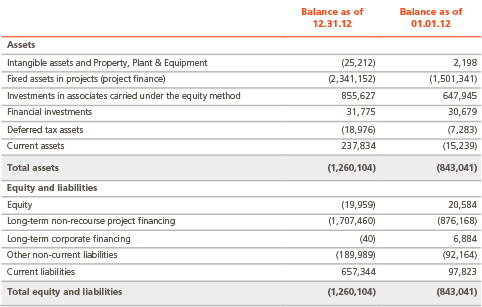
In addition, the effect of this de-consolidation on the consolidated income statement for the year 2012 is shown below:
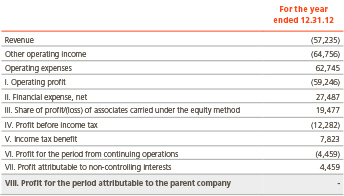
Subsidiary companies included in the consolidation perimeter using the equity method, due to the application of new accounting standards, are disclosed in Appendix XVII.
c) Standards, interpretations and amendments published by the IASB that will be effective for periods beginning on or after January 1, 2014:
- IAS 32 (amendment) ’Offsetting of financial assets and financial liabilities’. The IAS 32 amendment is mandatory for periods beginning on or after January 1, 2014 under IFRS-EU and IFRS-IASB and is to be applied retroactively.
- IAS 36 (Amendment) ‘Recoverable Amount Disclosures for Non-Financial Assets’. The IAS 36 amendment is mandatory for periods beginning on or after January 1, 2014 under IFRS-EU and IFRS-IASB.
- IAS 39 (Amendment) ‘Novation of Derivatives and Continuation of Hedge Accounting’.The IAS 39 amendment is mandatory for periods beginning on or after January 1, 2014 under IFRS-EU and IFRS-IASB.
- IFRS 9 ’Financial Instruments’. This Standard will be effective from January 1, 2017 under IFRS-IASB and has not yet been adopted by the EU.
The Group is currently in the process of evaluating the impact on the Consolidated Financial Statement derived from the application of these new standards.
2.1.2. IFRIC 12 – Service concession arrangements
As stated in the consolidated financial statements for 2011 and as a result of IFRIC 12 ‘Service Concession Arrangements’ that came into effect in 2010, the Company carried out an analysis of other agreements in the Group and identified further infrastructures, specifically thermosolar plants in Spain included under the special arrangements of RD 661/2007 and recorded in the pre-assignment register in November 2009, which could potentially be classified as service concession arrangements.
Nevertheless, at the end of 2010, the company decided that it needed to carry out a more in-depth analysis of the issue since the reasons that justified the accounting application of the interpretation had not been sufficiently proven based on the information available at that date.
During 2010 and 2011, the Spanish government issued several laws and resolutions that regulate the market for renewable energy in Spain in general, and thermo-solar activities in particular. In early 2011, when Abengoa received a set of individual rulings from the Spanish Ministry of Industry for each of its thermosolar assets,the Company returned to work on the analysis of applying IFRIC 12 to its thermosolar plants in Spain. In September 2011 the Company concluded that it was required to start applying IFRIC 12 to its thermosolar plants in Spain included under the special scheme of Royal Decree 661/2007 and recorded in the pre-assignment register in November 2009, just as it was doing for its other concession assets, based on all available information and the newly acquired knowledge from the analysis performed.
As explained in the preceding paragraphs, it was not possible to allow application on January 1, 2010 of IFRIC 12 to those thermosolar plants and, as indicated in Paragraph 52 of IAS 8 on Accounting Policy and Changes to Accounting Estimates, the application became prospective as from September 1, 2011.
At the time of application of IFRIC 12, the Company reclassified all capitalized costs under the heading of ‘other assets in projects’ relating to thermosolar plants into ‘concession assets in projects’ for an amount of €1.6 billion. Similarly, from September 1, 2011, all revenues and costs related to the construction of these plants were recorded based on the percentage of completion method in accordance with IAS 11, from the date of the prospective application of IFRIC 12 to the end of the construction of these assets which were estimated for completion in 2013. This treatment deferred recognition of the costs, margins and revenues generated up to that date and previously eliminated in consolidation prospectively, pro rata, over the term of the remaining construction period.
During 2013, the Company re-evaluated the assumptions made in 2011 that justified the application of IFRIC 12 to thermosolar plants in Spain as described above. On June 30, 2013 and based on the provisions of IAS 8.14, the Directors deemed it necessary to change the accounting policy applied to these plants. It is believed that financial statements will provide more reliable and comparable information about the application of IFRIC 12 to thermosolar plants in Spain. The accounting change modifies the method in which we initially applied IFRIC 12, as well as the date on which IFRIC 12 was applied (January 1, 2011 instead of September 1, 2011).
The revised accounting treatment has consisted in applying IFRIC 12 prospectively from January 1, 2011 by derecognizing, our thermo-solar plant assets previously recognized at cost as ‘‘Property, Plant and Equipment in Projects’’ and recognizing those thermo-solar plant assets at fair value as ‘‘Concession Assets in Projects’’. The difference of €165 million was recorded in that moment in ‘‘Other Operating Income’’ on the consolidated income statement. From January 1, 2011, only the remaining contract revenue, costs and margins generated after such date for the ongoing construction of the plants began to be recognized based on the ‘‘percentage of completion’’ accounting method in accordance with IAS 11. In addition, the revenue and operating profit that was previously deferred upon original adoption of IFRIC 12 and recognized prospectively during fiscal years 2011 and 2012 has been eliminated. The change in application date resulted in the recognition of revenues and costs associated with the construction activities that occurred between January 1, 2011 and September 1, 2011,that were previously eliminated.
This change in accounting policy for the application of IFRIC 12 to the thermosolar plants in Spain, reflects the spirit of Paragraph 45 of IAS 1 which justifies changes in the presentation (in addition to the classification) of annual accounts. As a result of the change, there is an improved presentation of the financial statements. They better reflect the plant construction operations underway in each financial year, without altering the trend of the group's earnings. They also facilitate comparisons between periods.
In accordance with the terms and requirements of IAS 8 for ‘Accounting policies, changes in acccounting estimates and errors’, the above standard has been applied by recasting the comparative information presented, to make it comparable with the information for the year ended December 31, 2013. Consequently, and in accordance with IAS 1, a third Consolidated Statement of Financial Position as of January 1, 2012 has been included corresponding to the beginning of the earliest comparative period. The consolidated income statement and statement of financial position within our Annual Consolidated Financial Statements have not been recasted to retrospectively apply IFRIC 12 to thermo-solar electricity generation plants in Spain for any period prior to January 1, 2011.
The following table shows the impact of this change on the consolidated statements of financial position as of December 31, 2012 and January 1, 2012:
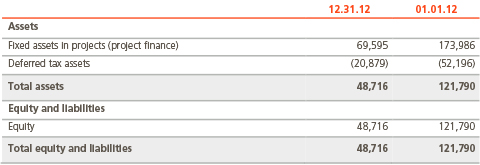
In addition, the following table shows the impact of this change on the consolidated income statement for the year 2012:
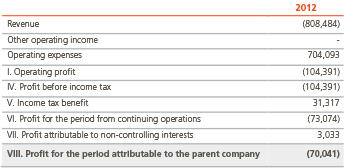
The impact of this change in accounting policy on the basic and diluted earnings per share for the year ended December 31, 2012 was €0.13 per share.
2.2. Principles of consolidation
In order to provide information on a consistent basis, the same principles and standards applied to the parent company have been applied to all other consolidated entities.
All subsidiaries, associates and joint ventures included in the consolidated group for the years 2013 and 2012 that form the basis of these Consolidated Financial Statements are set out in Appendices I (XII), II (XIII) and III (XIV), respectively.
Note 6 of these Consolidated Financial Statements reflects the information on the changes in the composition of the Group.
a) Subsidiaries
Subsidiaries are those entities over which Abengoa has control.
Control is achieved when the Company:
- has power over the investee;
- is exposed, or has rights, to variable returns from its involvement with the investee; and
- has the ability to use its power to affect its returns.
The Company reassesses whether or not it controls an investee when facts and circumstances indicate that there are changes to one or more of the three elements of control listed above.
The Company operates an integrated business model in which it provides complete services form initial design, construction and engineering to operation and maintenance of infrastructure assets. In order to evaluate the existence of control, we need to distinguish two independent stages in these projects in terms of decision making process: the construction phase and the operation phase. In some of these projects (such as Solana and Mojave thermo-solar plants in the United States, Hugoton second generation biofuels plant in the United States and solar plants currently under construction in South Africa), all the relevant decisions during the construction phase are subject to the approval and control of a third party. As a result, Abengoa does not have control over these assets during this period and records these companies as associates under the equity method. Once the project is in operation, Abengoa gains control over these companies which are then fully consolidated.
When the Company has less than a majority of the voting rights of an investee, it has power over the investee when the voting rights are sufficient to give it the practical ability to direct the relevant activities of the investee unilaterally. The Company considers all relevant facts and circumstances in assessing whether or not the Company’s voting rights in an investee are sufficient to give it power, including:
- the size of the Company’s holding of voting rights relative to the size and dispersion of holdings of the other vote holders;
- potential voting rights held by the Company, other vote holders or other parties;
- rights arising from other contractual arrangements; and
- any additional facts and circumstances that indicate that the Company has, or does not have, the current ability to direct the relevant activities at the time that decisions need to be made, including voting patterns at previous shareholders’ meetings.
Consolidation of a subsidiary begins when the Company obtains control over the subsidiary and ceases when the Company loses control of the subsidiary.
The Group uses the acquisition method to account for business combinations. According to this method, the consideration transferred for the acquisition of a subsidiary corresponds to the fair value of the assets transferred, the liabilities incurred and the equity interests issued by the Group and includes the fair value of any asset or liability resulting from a contingent consideration arrangement. Any contingent consideration is recognized at fair value at the acquisition date and subsequent changes in its fair value are recognized in accordance with IAS 39 either in profit or loss or as a change to other comprehensive income. Acquisition related costs are expensed as incurred. Identifiable assets acquired, liabilities and contingent liabilities assumed in a business combination are measured initially at their fair values at the acquisition date. The Group recognizes any non controlling interest in the acquiree either at fair value or at the non controlling interest’s proportionate share of the acquirer’s net assets on an acquisition basis.
The value of non controlling interest in equity and the consolidated results are shown, respectively, under ‘Non controlling interest’ of the Consolidated Statements of Financial Position and ‘Profit attributable to non controlling interest’ in the Consolidated Income Statements.
Profit for the period and each component of other comprehensive income are attributed to the owners of the Company and to the non controlling interests. Total comprehensive income of subsidiaries is attributed to the owners of the Company and to the non controlling interests even if this results in the non controlling interests having a total negative balance.
When necessary, adjustments are made to the financial statements of subsidiaries to bring their accounting policies in line with the Group’s accounting policies.
All intragroup assets and liabilities, equity, income, expenses and cash flows relating to transactions between members of the Group are eliminated in full on consolidation.
In compliance with Article 155 of Spanish Corporate Law (Ley de Sociedades de Capital), the parent company has notified all these companies that, either by itself or through another subsidiary, it owns more than 10 per 100 shares of their capital. Appendix IX lists the Companies external to the Group which have a share equal to or greater than 10% of a subsidiary of the parent company under consolidation.
b) Associates and joint ventures
An associate is an entity over which the Group has significant influence. Significant influence is the power to participate in the financial and operating policy decisions of the investee but is not control or joint control over those policies.
A joint venture (as opposed to a joint operation described in section c) below) is a joint arrangement whereby the parties that have joint control of the arrangement have rights to the net assets of the joint arrangement. Joint control is the contractually agreed sharing of control of an arrangement, which exists only when decisions about the relevant activities require unanimous consent of the parties sharing control.
The results and assets and liabilities of associates or joint ventures are incorporated in these Consolidated Financial Statements using the equity method of accounting. Under the equity method, an investment in an associate or a joint venture is initially recognized in the consolidated statement of financial position at cost and adjusted thereafter to recognize the Group’s share of the profit or loss and other comprehensive income of the associate or joint venture. When the Group’s share of losses of an associate or a joint venture exceeds the Group’s interest in that associate or joint venture, the Group discontinues recognizing its share of further losses. Additional losses are recognized only to the extent that the Group has incurred legal or constructive obligations or made payments on behalf of the associate or joint venture.
An investment in an associate or a joint venture is accounted for using the equity method from the date on which the investee becomes an associate or a joint venture.
Profits and losses resulting from the transactions of the Company with the associate or joint venture are recognized in the Group’s Consolidated Financial Statements only to the extent of interests in the associate or joint venture that are not related to the Group.
In compliance with Article 155 of Spanish Corporate Law (Ley de Sociedades de Capital), the parent company has notified all these companies that, either by itself or through another subsidiary, it owns more than 10 per 100 shares of their capital.
As of December 31, 2013 and 2012 there are no significant contingent liabilities in the Group’s interests in joint ventures.
c) Interest in joint operations and temporary joint operations (UTE)
A joint operation is a joint arrangement whereby the parties that have joint control of the arrangement have rights to the assets, and obligations for the liabilities, relating to the arrangement. Joint control is the contractually agreed sharing of control of an arrangement, which exists only when decisions about the relevant activities require unanimous consent of the parties sharing control.
When a group entity undertakes its activities under joint operations, the Group as a joint operator recognises in relation to its interest in a joint operation:
- Its assets, including its share of any assets held jointly.
- Its liabilities, including its share of any liabilities incurred jointly.
- Its share of the revenue from the sale of the output by the joint operation.
- Its expenses, including its share of any expenses incurred jointly.
When a group entity transacts with a joint operation in which a group entity is a joint operator (such as a purchase of assets), the Group does not recognize its share of the gains and losses until it resells those assets to a third party.
‘Unión Temporal de Empresas’ (UTE) are temporary joint operations generally formed to execute specific commercial and/or industrial projects in a wide variety of areas and particularly in the fields of engineering and construction and infrastructure projects. They are normally used to combine the characteristics and qualifications of the UTE’s partners into a single proposal in order to obtain the most favorable technical assessment possible. UTE are normally limited as standalone entities with limited action, since, although they may enter into commitments in their own name, such commitments are generally undertaken by their partners, in proportion to each investor’s share in the UTE.
The partners’ shares in the UTE normally depend on their contributions (quantitative or qualitative) to the project, are limited to their own tasks and are intended solely to generate their own specific results. Each partner is responsible for executing its own tasks and does so in its own interests.
The fact that one of the UTE’s partners acts as project manager does not affect its position or share in the UTE. The UTE’s partners are collectively responsible for technical issues, although there are strict pari passu clauses that assign the specific consequences of each investor’s correct or incorrect actions.
UTE are not variable interest or special purpose entities. UTE do not usually own assets or liabilities on a standalone basis. Their activity is conducted for a specific period of time that is normally limited to the execution of the project. The UTE may own certain fixed assets used in carrying out its activity, although in this case they are generally acquired and used jointly by all the UTE’s investors, for a period similar to the project’s duration, or prior agreements are signed by the partners on the assignment or disposal of the UTE’s assets upon completion of the project.
UTE in which the Company participates are operated through a management committee comprised of equal representation from each of the temporary joint operation partners, and such committee makes all the decisions about the temporary joint operation’s activities that have a significant effect on its success. All the decisions require consent of each of the parties sharing power, so that all the parties together have the power to direct the activities of the UTE. Each partner has rights to the assets and obligations relating to the arrangement. As a result, these temporary joint operations are consolidated proportionally.
The proportional part of the UTE’s Consolidated Statement of Financial Position and Consolidated Income Statement is integrated into the Consolidated Statement of Financial Position and the Consolidated Income Statement of the Company in proportion to its interest in the UTE on a line by line basis.
As of December 31, 2013 and 2012 there are no significant material contingent liabilities in relation to the Group’s shareholdings in the UTE.
d) Transactions with non-controlling interests
Transactions with non-controlling interests are accounted for as transactions with equity owners of the group. When the Group acquires non-controlling interests, the difference between any consideration paid and the carrying value of the proportionate share of net assets acquired is recorded in equity. Gains or losses on disposals of non-controlling interests are also recorded in equity.
When the group ceases to have control or significant influence, any retained interest in the entity is remeasured to its fair value, and any difference between fair value and its carrying amount is recognized in profit or loss. In addition, any amount previously recognized in other comprehensive income in respect of that entity is accounted for as if the group had directly disposed of the related assets or liabilities.
Companies and entities which are third parties the Group and which hold a share equal to or larger than 10% in the share capital of any company included in the consolidation group are disclosed in Appendix VIII.
2.3. Intangible assets
a) Goodwill
Goodwill is recognized as the excess between (A) and (B), where (A) is the sum of the considerations transferred, the amount of any non-controlling interest in the acquiree and in the case of a business combination achieved in stages, the fair value on the acquisition date of the previously held interest in the acquiree and (B) the net value, at the acquisition date, of the identifiable assets acquired, the liabilities and contingent liabilities assumed, measured at fair value. If the resulting amount is negative, in the case of a bargain purchase, the difference is recognized as income directly in the Consolidated Income Statement.
Goodwill relating to the acquisition of subsidiaries is included in intangible assets, while goodwill relating to associates is included in investments in associates.
Goodwill is carried at initial value less accumulated impairment losses (see Note 2.8). Goodwill is allocated to Cash Generating Units (CGU) for the purposes of impairment testing, these CGU’s being the units which are expected to benefit from the business combination that generated the goodwill.
b) Computer programs
Costs paid for licenses for computer programs are capitalized, including preparation and installation costs directly associated with the software. Such costs are amortized over their estimated useful life. Maintenance costs are expensed in the period in which they are incurred.
Costs directly related with the production of identifiable computer programs are recognized as intangible assets when they are likely to generate future economic benefit for a period of one or more years and they fulfill the following conditions:
- it is technically possible to complete the production of the intangible asset;
- management intends to complete the intangible asset;
- the Company is able to use or sell the intangible asset;
- there are technical, financial and other resources available to complete the development of the intangible asset; and
- disbursements attributed to the intangible asset during its development may be reliably measured.
Costs directly related to the production of computer programs recognized as intangible assets are amortized over their estimated useful lives which do not exceed 10 years.
Costs that do not meet the criteria above are recognized as expenses in the Consolidated Income Statement when incurred.
c) Research and development cost
Research costs are recognized as an expense when they are incurred.
Development costs (relating to the design and testing of new and improved products) are recognized as an intangible asset when all the following criteria are met:
- it is probable that the project will be successful, taking into account its technical and commercial feasibility, so that the project will be available for its use or sale;
- it is probable that the project will generate future economic benefits;
- management intends to complete the project;
- the Company is able to use or sell the intangible asset;
- there are appropriate technical, financial or other resources available to complete the development of the intangible asset; and
- the costs of the project/product can be measured reliably.
Once the product is in the market, capitalized costs are amortized on a straight-line basis over the period for which the product is expected to generate economic benefits, which is normally 5 years, except for development assets related to the thermo-solar plant using tower technology which are amortized over 25 years and the second-generation biofuels plant which is amortized according to its useful life.
Development costs that do not meet the criteria above are recognized as expenses in the Consolidated Income Statement when incurred.
Grants or subsidized loans obtained to finance research and development projects are recognized as income in the Consolidated Income Statement consistently with the expenses they are financing (following the rules described above).
2.4. Property, plant and equipment
Property, plant and equipment includes property, plant and equipment of companies or project companies which have been self-financed or financed through external financing with recourse facilities or through non-recourse project finance.
In general, property, plant and equipment is measured at historical cost, including all expenses directly attributable to the acquisition, less depreciation and impairment losses, with the exception of land, which is presented net of any impairment losses.
Subsequent costs are capitalized when it is probable that future economic benefits associated with that asset can be separately and reliably identified.
Work carried out by a company on its own property, plant and equipment is valued at production cost. In construction projects of the Company’s owned assets carried out by its Engineering and Construction segment which are not under the scope of IFRIC 12 on Service Concession Arrangements (see Note 2.5), internal margins are eliminated. The corresponding costs are recognized in the individual expense line item in the accompanying income statements. The recognition of an income for the sum of such costs through the line item ‘Other income- Work performed by the entity and capitalized and other’ results in these costs having no impact in net operating profit. The corresponding assets are capitalized and included in property, plant and equipment in the accompanying balance sheets.
All other repair and maintenance costs are charged to the Consolidated Income Statement in the period in which they are incurred.
Costs incurred during the construction period may also include gains or losses from foreign-currency cash-flow hedging instruments for the acquisition of property, plant and equipment in foreign currency, transferred from equity.
With regard to investments in property, plant and equipment located on land belonging to third parties, an initial estimate of the costs of dismantling the asset and restoring the site to its original condition is also included in the carrying amount of the asset. Such costs are recorded at their net present value in accordance with IAS 37.
The annual depreciation rates of property, plant and equipment (including property, plant and equipment in projects) are as follows:

The assets’ residual values and useful economic lives are reviewed, and adjusted if necessary, at the end of the accounting period of the company which owns the asset.
When the carrying amount of an asset is higher than its recoverable amount, the carrying amount is reduced immediately to reflect the lower recoverable amount.
2.5. Fixed assets in projects (project finance)
This category includes property, plant and equipment, intangible assets and financial assets of consolidated companies which are financed through Non-recourse Project Finance, that are raised specifically and solely to finance individual projects as detailed in the terms of the loan agreement.
These non-recourse Project Finance assets are generally the result of projects which consist of the design, construction, financing, application and maintenance of large-scale complex operational assets or infrastructures, which are owned by the company or are held under a concession agreement for a period of time. The projects are initially financed through non-recourse medium-term bridge loans and later by Non-recourse Project Finance.
In this respect, the basis of the financing agreement between the Company and the bank lies in the allocation of the cash flows generated by the project to the repayment of the principal amount and interest expenses, excluding or limiting the amount secured by other assets, in such a way that the bank recovers the investment solely through the cash flows generated by the project financed, any other debt being subordinated to the debt arising from the non-recourse financing applied to projects until the non-recourse debt has been fully repaid. For this reason, fixed assets in projects are separately reported on the face of the Consolidated Statement of Financial Position, as is the related non-recourse debt in the liability section of the same statement.
Assets in the ‘fixed assets in projects’ line item of the Consolidated Statement of Financial Position are sub-classified under the following two headings, depending upon their nature and their accounting treatment:
2.5.1. Concession assets in projects
This heading includes fixed assets financed through non-recourse loans related to Service Concession Arrangements recorded in accordance with IFRIC 12. IFRIC 12 states that service concession arrangements are public-to-private arrangements in which the public sector controls or regulates the services to be provided using the infrastructure and their prices, and is contractually guaranteed to gain, at a future time, ownership of the infrastructure through which the service is provided. The infrastructures accounted for by the Group as concessions are mainly related to the activities concerning power transmission lines, desalination plants, cogeneration plants and thermo-solar electricity generation plants. The infrastructure used in a concession can be classified as an intangible asset or a financial asset, depending on the nature of the payment entitlements established in the agreement (see Note 2.1.2).
- a) Intangible asset
The Group recognizes an intangible asset when the demand risk to the extent that it has a right to charge final customers for the use of the infrastructure. This intangible asset is subject to the provisions of IAS 38 and is amortized linearly, taking into account the estimated period of commercial operation of infrastructure which generally coincides with the concession period.
The Group recognizes and measures revenue, costs and margin for providing construction services during the period of construction of the infrastructure in accordance with IAS 11 ‘Construction Contracts’ and revenue for other services in accordance with IAS 18 ‘Revenue’. As indicated in Note 2.7, the interest costs derived from financing the project incurred during construction are capitalized during the period of time required to complete and prepare the asset for its predetermined used.
Once the infrastructure is in operation, the treatment of income and expenses is as follows:
Revenues from the updated annual royalty for the concession, as well as operations and maintenance services are recognized in each period according to IAS 18 ‘Ordinary income’.
Operating and maintenance costs and general overheads and administrative costs are charged to the Consolidated Income Statement in accordance with the nature of the cost incurred (amount due) in each period.
Financing costs are classified within heading finance expenses in the Consolidated Income Statement. - b) Financial asset
The Group recognizes a financial asset when demand risk is assumed by the grantor to the extent that the concession holder has an unconditional right to receive payments for construction or improvement services. This asset is recognized at the fair value of the construction or improvement services provided.
The valuation of the receivable account is performed according to the amortized cost method, the corresponding income from updating the flows of collections is recognized as revenue in the Consolidated Income Statement according to the effective interest rate.
The finance expenses of financing these assets are classified under the financial expenses heading of the Consolidated Income Statement.
As indicated above for intangible assets, income from operations and maintenance services is recognized in each period according to IAS 18 ‘Ordinary income’.
2.5.2. Other assets in projects
This heading includes tangible fixed and intagible assets which are financed through a non-recourse loan and are not subject to a concession agreement as described below. Their accounting treatment is described in Notes 2.3 y 2.4.
Non-recourse project finance typically includes the following guarantees:
- Shares of the project developers are pledged.
- Assignment of collection rights.
- Limitations on the availability of assets relating to the project.
- Compliance with debt coverage ratios.
- Subordination of the payment of interest and dividends to meet loan financial ratios.
Once the project finance has been repaid and the non-recourse debt and related guarantees fully extinguished, any remaining net book value reported under this category is reclassified to the Property, Plant and Equipment or Intangible Assets line items, as applicable, in the Consolidated Statement of Financial Position.
2.6. Current and non-current classification
Assets are classified as current assets if they are expected to be realized in less than 12 months after the date of the Consolidated Statements of Financial Position. Otherwise, they are classified as non-current assets.
Liabilities are classified as current liabilities unless an unconditional right exists to defer their repayment by at least 12 months following the date of the Consolidated Statement of Financial Position.
2.7. Borrowing costs
Interest costs incurred in the construction of any qualifying asset are capitalized over the period required to complete and prepare the asset for its intended use. A qualifying asset is an asset that necessarily takes a substantial period of time to get ready for its internal use or sale, which in Abengoa is considered to be more than one year.
Costs incurred relating to non-recourse factoring are expensed when the factoring transaction is completed with the financial institution.
Remaining borrowing costs are expensed in the period in which they are incurred.
2.8. Impairment of non-financial assets
Abengoa reviews its property, plant and equipment, intangible assets with finite and indefinite useful life and goodwill to identify any indicators of impairment annually.
The recoverable amount of an asset is the higher of its fair value less costs to sell and its value in use, defined as the present value of the estimated future cash flows to be generated by the asset. In the event that the asset does not generate cash flows independently of other assets, Abengoa calculates the recoverable amount of the Cash-Generating Unit to which the asset belongs.
When the carrying amount of the Cash Generating Unit to which these assets belong is lower than its recoverable amount assets are impaired.
Assumptions used to calculate value in use include a discount rate, growth rates and projected changes in both selling prices and costs. The discount rate is estimated by Management, to reflect both changes in the value of money over time and the risks associated with the specific Cash-Generating Unit. Growth rates and changes in prices and costs are projected based upon internal and industry projections and management experience respectively. Financial projections range between 5 and 10 years depending on the growth potential of each Cash Generating Unit.
To calculate the value in use of the major goodwill balances, the following assumptions were made:
- 10-year financial projections were used for those Cash-Generating Units (CGUs) that have high growth potential based on cash flows taken into account in the strategic plans for each business unit, considering a residual value based on the flow in the final year of the projection.
The use of these 10-year financial projections was based on the assumption that it is the minimum period necessary for the discounted cash flow model to reflect all potential growth in the CGUs in each business segment showing significant investments.
The aforementioned estimated cash flows were considered to be reliable due to their capacity to adapt to the real market and/or business situation faced by the CGU in accordance with the business's margin and cash-flow experience and future expectations.
These cash flows are reviewed and approved every six months by Senior Management so that the estimates are continually updated to ensure consistency with the actual results obtained.
In these cases, given that the period used is reasonably long, the Group then applies a zero growth rate for the cash flows subsequent to the period covered by the strategic plan. - For concession assets with a defined useful life and with a specific financial structure, cash flow projections until the end of the project are considered and no terminal value is assumed.
Concession assets have a contractual structure that permit the Company to estimate quite accurately the costs of the project (both in the construction and in the operations periods) and revenue during the life of the project.
Projections take into account real data based on the contract terms and fundamental assumptions based on specific reports prepared by experts, assumptions on demand and assumptions on production. Additionally, assumptions on macro-economic conditions are taken into account, such as inflation rates, future interest rates, etc. and sensitivity analyses are performed over all major assumptions which can have a significant impact in the value of the asset. - 5-year cash flow projections are used for all other CGUs, considering the residual value to be the cash flow in the final year projected.
- Cash flow projections of CGUs located in other countries are calculated in the functional currency of those CGUs and are discounted using rates that take into consideration the risk corresponding to each specific country and currency. Present values obtained with this method are then converted to euros at the year-end exchange rate of each currency.
- Taking into account that in most CGUs the specific financial structure is linked to the financial structure of the projects that are part of those CGUs, the discount rate used to calculate the present value of cash-flow projections is based on the weighted average cost of capital (WACC) for the type of asset, adjusted, if necessary, in accordance with the business of the specific activity and with the risk associated with the country where the project is performed.
- In any case, sensitivity analyses are performed, especially in relation with the discount rate used, residual value and fair value changes in the main business variables, in order to ensure that possible changes in the estimates of these items do not impact the possible recovery of recognized assets.
- Accordingly, the following table provides a summary of the discount rates used (WACC) and growth rates to calculate the recoverable amount for Cash-Generating Units with the operating segment to which it pertains:

In the event that the recoverable amount of an asset is lower than its carrying amount, an impairment charge for the difference is recorded in the Consolidated Income Statement under the item ‘Depreciation, amortization and impairment charges’. With the exception of goodwill, impairment losses recognized in prior periods which are later deemed to have been recovered are credited to the same income statement heading.
2.9. Financial Investments (current and non-current)
Financial investments are classified into the following categories, based primarily on the purpose for which they were acquired:
- financial assets at fair value through profit and loss;
- loans and accounts receivable;
- financial assets held to maturity; and
- available for sale financial assets.
Classification of each financial asset is determinated by management upon initial recognition, and is reviewed at each year end.
a) Financial assets at fair value through profit and loss
This category includes the financial assets acquired for trading and those initially designated at fair value through profit and loss. A financial asset is classified in this category if it is acquired mainly for the purpose of sale in the short term or if it is so designated by Management. Financial derivatives are also classified at fair value through profit and loss when they do not meet the accounting requirements to be designated as hedging instruments.
These financial assets are recognized initially at fair value, without including transaction costs. Subsequent changes in fair value are recognized under ‘Gains or losses from financial assets at fair value’ within the ‘Finance income or expense’ line of the Consolidated Income Statement for the period.
b) Loans and accounts receivable
Loans and accounts receivable are non-derivative financial assets with fixed or determinable payments, not listed on an active market.
In accordance with IFRIC 12, certain assets under concessions qualify as financial receivables (see Note 2.5).
Loans and accounts receivable are initially recognized at fair value plus transaction costs and are subsequently measured at amortized cost in accordance with the effective interest rate method. Interest calculated using the effective interest rate method is recognized under ‘Interest income from loans and debts’ within the ‘Finance income’ line of the Consolidated Income Statement.
c) Financial assets held to maturity
This category includes non-derivative financial assets expected to be held to maturity which have fixed or determinable payments.
These assets are initially recognized at fair value plus transaction costs and subsequently measured at their amortized cost under the effective interest rate method. Interest calculated under the effective interest rate method is recognized under ‘Other finance income’ within the ‘Other net finance income/expense’ line of the Consolidated Income Statement.
d) Available for sale financial assets
This category includes non-derivative financial assets which do not fall within any of the previously mentioned categories. For Abengoa, they primarily comprise interests in other companies that are not consolidated.
Financial assets available for sale are initially recognized at fair value plus transaction costs and subsequently measured at fair value, with changes in fair value recognized directly in equity, with the exception of translation differences of monetary assets, which are charged to the Consolidated Income Statement. Dividends from available-for-sale financial assets are recognized under ‘Other finance income’ within the ‘Other net finance income/expense’ line of the Consolidated Income Statement when the right to receive the dividend is established.
When available for sale financial assets are sold or impaired, the accumulated amount recorded in equity is transferred to the Consolidated Income Statement. To establish whether the assets have been impaired, it is necessary to consider whether the reduction in their fair value is significantly below cost and whether it will be for a prolonged period of time. The cumulative gain or loss reclassified from equity to profit or loss when the financial assets are impaired is the difference between their acquisition cost (net of any principal repayment and amortization) and current fair value, less any impairment loss on that financial asset previously recognized in profit or loss. Impairment losses recognized in the Consolidated Income Statement are not subsequently reversed through the Consolidated Income Statement.
Acquisitions and disposals of financial assets are recognized on the trading date, i.e. the date upon which there is a commitment to purchase or sell the asset. Available for sale financial assets are derecognized when the right to receive cash flows from the investment has expired or has been transferred and all the risks and rewards derived from owning the asset have likewise been substantially transferred.
At the date of each Consolidated Statement of Financial Position, the Group evaluates if there is any objective evidence that the value of any financial asset or any group of financial assets has been impaired.
2.10. Derivative financial instruments and hedging activities
Derivatives are recorded at fair value. The Company applies hedge accounting to all hedging derivatives that qualify to be accounted for as hedges under IFRS.
When hedge accounting is applied, hedging strategy and risk management objectives are documented at inception, as well as the relationship between hedging instruments and hedged items. Effectiveness of the hedging relationship needs to be assessed on an ongoing basis. Effectiveness tests are performed prospectively and retrospectively at inception and at each reporting date, following the dollar offset method or the regression method, depending on the type of derivatives.
The Company has three types of hedges:
a) Fair value hedge for recognized assets and liabilities
Changes in fair value of the derivatives are recorded in the Consolidated Income Statement, together with any changes in the fair value of the asset or liability that is being hedged.
b) Cash flow hedge for forecasted transactions
The effective portion of changes in fair value of derivatives designated as cash flow hedges are recorded temporarily in equity and are subsequently reclassified from equity to profit or loss in the same period or periods during which the hedged item affects profit or loss. Any ineffective portion of the hedged transaction is recorded in the Consolidated Income Statement as it occurs.
When options are designated as hedging instruments (such as interest rate options described in Note 14), the intrinsic value and time value of the financial hedge instrument are separated. Changes in intrinsic value which are highly effective are recorded in equity and subsequently reclassified from equity to profit or loss in the same period or periods during which the hedged item affects profit or loss. Changes in time value are recorded in the Consolidated Income Statement, together with any ineffectiveness.
When the hedged forecasted transaction results in the recognition of a non-financial asset or liability, gains and losses previously recorded in equity are included in the initial cost of the asset or liability.
When the hedging instrument matures or is sold, or when it no longer meets the requirements to apply hedge accounting, accumulated gains and losses recorded in equity remain as such until the forecast transaction is ultimately recognized in the Consolidated Income Statement. However, if it becomes unlikely that the forecasted transaction will actually take place, the accumulated gains and losses in equity are recognized immediately in the Consolidated Income Statement.
c) Net investment hedges in foreign operation
Hedges of a net investment in a foreign operation, including the hedging of a monetary item considered part of a net investment, are recognized in a similar way to cash flow hedges. The foreign currency transaction gain or loss on the non-derivative hedging instrument that is designated as, and is effective as, an economic hedge of the net investment in a foreign operation shall be reported in the same manner as a translation adjustment. That is, reported in the cumulative translation adjustment section of equity to the extent it is effective as a hedge, as long as the following conditions are met: the notional amount of the non-derivative instrument matches the portion of the net investment designated as being hedged and the non-derivative instrument is denominated in the functional currency of the hedged net investment. In that circumstance, no hedge ineffectiveness would be recognized in earnings.
Amounts recorded in equity will be reclassified to the Consolidated Income Statement when the foreign operation is sold or otherwise disposed of.
Contracts held for the purposes of receiving or making payment of non-financial elements in accordance with expected purchases, sales or use of goods (‘own-use contracts’) of the Group are not recognized as derivative instruments, but as executory contracts. In the event that such contracts include embedded derivatives, they are recognized separately from the host contract, if the economic characteristics of the embedded derivative are not closely related to the economic characteristics of the host contract. The options contracted for the purchase or sale of non-financial elements which may be cancelled through cash outflows are not considered to be own-use contracts.
Changes in fair value of derivative instruments which do not qualify for hedge accounting are recognized immediately in the Consolidated Income Statement. Trading derivatives are classified as a current assets or liabilities.
2.11. Fair value estimates
Financial instruments measured at fair value are presented in accordance with the following level classification based on the nature of the inputs used for the calculation of fair value:
- Level 1: Inputs are quoted prices in active markets for identical assets or liabilities.
- Level 2: Fair value is measured based on inputs other than quoted prices included within Level 1 that are observable for the asset or liability, either directly (i.e. as prices) or indirectly (i.e. derived from prices).
- Level 3: Fair value is measured based on unobservable inputs for the asset or liability.
In the event that prices cannot be observed, the management shall make its best estimate of the price that the market would otherwise establish based on proprietary internal models which, in the majority of cases, use data based on observable market parameters as significant inputs (Level 2) but occasionally use market data that is not observed as significant inputs (Level 3). Different techniques can be used to make this estimate, including extrapolation of observable market data. The best indication of the initial fair value of a financial instrument is the price of the transaction, except when the value of the instrument can be obtained from other transactions carried out in the market with the same or similar instruments, or valued using a valuation technique in which the variables used only include observable market data, mainly interest rates. According to current legislation (IFRS-EU), differences between the transaction price and the fair value based on valuation techniques that use data that is not observed in the market, are not initially recognized in the income statement.
a) Level 2 valuation
The majority of Abengoa's portfolio comprises financial derivatives designated as cash flow hedges, is classified as level 2 and corresponds mainly to the interest rate swaps (see Note 14).
Credit risk effect on the valuation of derivatives is calculated for each of the instruments in the portfolio of derivatives classified within level 2, using the own risk of the Abengoa companies and financial counterparty risk.
Description of the valuation method
- Interest rate swaps
Interest rate swap valuations are made by valuing the swap component of the contract and valuing the credit risk.
The most common methodology used by the market and applied by Abengoa to value interest rate swaps is to discount the expected future cash flows according to the parameters of the contract. Variable interest rates, which are needed to estimate future cash flows, are calculated using the curve for the corresponding currency and extracting the implicit rates for each of the reference dates in the contract. These estimated flows are discounted with the swap zero curve for the reference period of the contract 1, 3 or 6 months.
The effect of the credit risk on the valuation of the interest rate swaps depends on the future settlement. If the settlement is favorable for the Company, the counterparty credit spread will be incorporated to quantify the probability of default at maturity. If the expected settlement is negative for the company, its own credit risk will be applied to the final settlement.
Classic models for valuing interest rate swaps use deterministic valuation of the future of variable rates, based on future outlooks. When quantifying credit risk, this model is limited by considering only the risk for the current paying party, ignoring the fact that the derivative could change sign at maturity. A payer and receiver swaption model is used for these cases. This enables the associated risk in each swap position to be reflected. Thus, the model shows each agent's exposure, on each payment date, as the value of entering into the ‘tail’ of the swap, i.e. the live part of the swap. - Interest rate caps and floors
Interest rate caps and floors are valued by separating the derivative in the successive caplets/floorlets that comprise the transaction. Each caplet or floorlet is valued as a call or put option, respectively, on the reference interest rate, for which the Black-Scholes approach is used for European-type options (exercise at maturity) with minor adaptations and following the Black-76 model. - Forward foreign exchange transactions
Forward contracts are valued by comparing the contracted forward rate and the rate in the valuation scenario at the maturity date. The contract is valued by calculating the flow that would be obtained or paid from theoretically closing out the position and then discounting that amount. - Commodity swaps
Commodity swaps are valued in the same way as forward foreign exchange contracts, calculating the flow that would be obtained or paid from theoretically closing out the position. - Equity options
Equity options are valued using the Black-Scholes model for American-type options on equities. - Embedded derivatives in convertible bonds
The embedded derivatives in convertible bonds consist of an option to convert the bond into shares in favor of the bondholder; call options for the issuer to repurchase the bonds at a specific price on specific dates; and put options for the bondholder to redeem the bonds at a specific price and on specific dates. Since these are Bermuda-type options (multiple exercise dates), they are valued using the Longstaff-Schwartz model and the Monte Carlo method.
Variables (Inputs)
Interest rate derivative valuation models use the corresponding interest rate curves for the relevant currency and underlying reference in order to estimate the future cash flows and to discount them. Market prices for deposits, futures contracts and interest rate swaps are used to construct these curves. Interest rate options (caps and floors) also use the volatility of the reference interest rate curve.
Exchange rate derivatives are valued using the interest rate curves of the underlying currencies in the derivative, as well as the corresponding spot exchange rates.
The inputs in equity models include the interest rate curves of the corresponding currency, the price of the underlying asset, as well as the implicit volatility and any expected future dividends.
To estimate the credit risk of the counterparty, the credit default swap (CDS) spreads curve is obtained in the market for important individual issuers. For less liquid issuers, the spreads curve is estimated using comparable CDSs or based on the country curve. To estimate proprietary credit risk, prices of debt issues in the market and CDSs for the sector and geographic location are used.
The fair value of the financial instruments that results from the aforementioned internal models, takes into account, among other factors, the terms and conditions of the contracts and observable market data, such as interest rates, credit risk, exchange rates, commodities and share prices, and volatility. The valuation models do not include significant levels of subjectivity, since these methodologies can be adjusted and calibrated, as appropriate, using the internal calculation of fair value and subsequently compared to the corresponding actively traded price. However, valuation adjustments may be necessary when the listed market prices are not available for comparison purposes.
b) Level 3 valuation
Level 3 includes shares in companies that, pursuant to the regulations in force, have not been included in the scope of consolidation for the years ended December 31, 2013 and 2012 and in which the Company's stake is greater than 5% and lower than 20%.
Fair value within these elements was calculated by taking as the main reference the value of the investment - the company's cash flow generation based on its current business plan, discounted at a rate appropriate for the sector in which each of the companies is operating. Valuations were obtained from internal models. These valuations could vary where other models and assumptions made on the principle variables had been used, however the fair value of the assets and liabilities, as well as the results generated by these financial instruments are considered reasonable.
Detailed information on fair values is included in Note 12.
2.12. Inventories
Inventories are valued at the lower of cost or net realizable value. In general, cost is determined by using the first-in-first-out (FIFO) method. The cost of finished goods and work in progress includes design costs, raw materials, direct labor, other direct costs and general manufacturing costs (assuming normal operating capacity). Borrowing costs are not included. The net realizable value is the estimated sales value in the normal course of business, less applicable variable selling costs.
Cost of inventories includes the transfer from equity of gains and losses on qualifying cash-flow hedging instruments related with the purchase of raw materials or with foreign exchange contracts.
2.13. Biological assets
Abengoa recognizes sugar cane in production as biological assets. The production period of sugar cane covers the period from preparation of the land and sowing the seedlings until the plant is ready for first production and harvesting. Biological assets are classified as property, plant and equipment in the Consolidated Statement of Financial Position. Biological assets are recognized at fair value, calculated as the market value less estimated harvesting and transport costs.
Agricultural products harvested from biological assets, which in the case of Abengoa are cut sugar cane, are classified as inventories and measured at fair value less estimated sale costs at the point of sale or harvesting.
Fair value of biological assets is calculated using as a reference the forecasted market price of sugarcane, which is estimated using public information and estimates on future prices of sugar and ethanol. Fair value of agricultural products is calculated using as a reference the price of sugar cane made public on a monthly basis by the Cane, Sugar and Alcohol Producers Board (Consecana).
Gains or losses arising as a result of changes in the fair value of such assets are recorded, within ‘Operating profit’ in the Consolidated Income Statement.
To obtain the fair value of the sugar cane while growing, a number of assumptions and estimates have been made in relation to the area of land sown, the estimated TRS (Total Recoverable Sugar contained within the cane) per ton to be harvested and the average degree of growth of the agricultural product in the different areas sown.
2.14. Clients and other receivables
Clients and other receivables relate to amounts due from customers for sales of goods and services rendered in the normal course of operation.
Clients and other receivables are recognized initially at fair value and are subsequently measured at amortized cost using the effective interest rate method, less provision for impairment. Trade receivables due in less than one year are carried at their face value at both initial recognition and subsequent measurement, provided that the effect of not discounting flows is not significant.
A provision for impairment of trade receivables is recorded when there is objective evidence that the Group will not be able to recover all amounts due as per the original terms of the receivables. The existence of significant financial difficulties, the probability that the debtor is in bankruptcy or financial reorganization and the lack or delay in payments are considered evidence that the receivable is impaired.
The amount of the provision is the difference between the asset’s carrying amount and the present value of estimated future cash flows discounted at the effective interest rate. When a trade receivable is uncollectable, it is written off against the bad debt provision.
Clients and other receivables which have been factored with financial entities are derecognized and hence removed from assets on the Consolidated Statement of Financial Position only if all risks and rewards of ownership of the related financial assets have been transferred, comparing the Company’s exposure, before and after the transfer, to the variability in the amounts and the calendar of net cash flows from the transferred asset. Once the Company’s exposure to this variability has been eliminated or substantially reduced, the financial asset has been transferred, and is derecognized from the Consolidated Statement of Financial Position (See Note 4.b).
2.15. Cash and cash equivalents
Cash and cash equivalents include cash in hand, cash in bank and other highly-liquid current investments with an original maturity of three months or less which are held for the purpose of meeting short-term cash commitments.
In the Consolidated Statement of Financial Position, bank overdrafts are classified as borrowings within current liabilities.
2.16. Share capital
Parent company shares are classified as equity. Transaction costs directly attributable to new shares are presented in equity as a reduction, net of taxes, to the consideration received from the issue.
Treasury shares are classified in Equity-Parent company reserves. Any amounts received from the sale of treasury shares, net of transaction costs, are classified equity.
2.17. Government grants
Non-refundable capital grants are recognized at fair value when it is considered that there is a reasonable assurance that the grant will be received and that the necessary qualifying conditions, as agreed with the entity assigning the grant, will be adequately met.
Grants related to income are recorded as liabilities in the Consolidated Statement of Financial Position and are recognized in ‘Other operating income’ in the Consolidated Income Statement based on the period necessary to match them with the costs they intend to compensate.
Grants related to fixed assets are recorded as non-current liabilities in the Consolidated Statement of Financial Position and are recognized in ‘Other operating income’ in the Consolidated Income Statement on a straight-line basis over the estimated useful economic life of the assets.
2.18. Loans and borrowings
External resources are classified in the following categories:
- non-recourse financing applied to projects (project financing) (see note 19);
- corporate financing (see Note 20).
Loans and borrowings are initially recognized at fair value, net of transaction costs incurred. Borrowings are subsequently measured at amortized cost and any difference between the proceeds initially received (net of transaction costs incurred in obtaining such proceeds) and the repayment value is recognized in the Consolidated Income Statement over the duration of the borrowing using the effective interest rate method.
Interest free loans and loans with interest rates below market rates, mainly granted for research and development projects, are initially recognized at fair value in liabilities in the Consolidated Statement of Financial Position. The difference between proceeds received from the loan and its fair value is initially recorded within ‘Grants and Other liabilities’ in the Consolidated Statement of Financial Position, and subsequently recorded in ‘Other operating income- Grants’ in the Consolidated income statement when the costs financed with the loan are expensed. In the case of interest free loans received for development projects where the Company record an intangible asset, income from the grant will be recognized according to the useful life of the asset, at the same rate as we record its amortization.
Commissions paid for obtaining credit lines are recognized as transaction costs if it is probable that part or all of the credit line will be drawn down. If this is the case, commissions are deferred until the credit line is drawn down. If it is not probable that all or part of the credit line will be drawn down, commission costs are expensed in the period.
2.18.1. Convertible notes
Pursuant to the Terms and Conditions of each of the convertible notes issued, when investors exercise their conversion right, the Company may decide whether to deliver shares of the company, cash, or a combination of cash and shares (see Note 20.3 for further information).
In accordance with IAS 32 and 39, since Abengoa has a contractual right to choose the type of payment and one of these possibilities is paying through a variable number of shares and cash, the conversion option qualifies as an embedded derivative. Thus, the convertible bond is considered a hybrid instrument, which includes a component of debt and an embedded derivative for the conversion option held by the bondholder.
The Company initially measures the embedded derivative at fair value and classifies it under the derivative financial instruments liability heading. At the end of each period, the embedded derivative is re-measured and changes in fair value are recognized under ‘Other net finance income or expense’ within the ‘Finance expense net’ line of the Consolidated Income Statement. The debt component of the bond is initially recorded as the difference between the proceeds received for the notes and the fair value of the aforementioned embedded derivative. Subsequently, the debt component is measured at amortized cost until it is settled upon conversion or maturity. Debt issuance costs are recognized as a deduction in the value of the debt in the Consolidated Statement of Financial Position and included as part of its amortized cost.
2.18.2. Ordinary notes
The company initially recognizes ordinary notes at fair value, net of issuance costs incurred. Subsequently, notes are measured at amortized cost until settlement upon maturity. Any other difference between the proceeds obtained (net of transaction costs) and the redemption value is recognized in the Consolidated Income Statement over the term of the debt using the effective interest rate method.
2.19. Current and deferred income taxes
Income tax expense for the period comprises current and deferred income tax. Income tax is recognized in the Consolidated Income Statement, except to the extent that it relates to items recognized directly in equity. In these cases, income tax is also recognized directly in equity.
Current income tax expense is calculated on the basis of the tax laws in force or about to enter into force as of the date of the Consolidated Statement of Financial Position in the countries in which the subsidiaries and associates operate and generate taxable income.
Deferred income tax is calculated in accordance with the Consolidated Statement of Financial Position liability method, based upon the temporary differences arising between the carrying amount of assets and liabilities and their tax base. However, deferred income tax is not recognized if it arises from initial recognition of an asset or liability in a transaction other than a business combination that, at the time of the transaction, affects neither the accounting nor the taxable profit or loss. Deferred income tax is determined using tax rates and regulations which are enacted or substantially enacted at the date of the Consolidated Statement of Financial Position and are expected to apply and/or be in force at the time when the deferred income tax asset is realized or the deferred income tax liability is settled.
Deferred tax assets are recognized only when it is probable that sufficient future taxable profit will be available to use deferred tax assets.
Deferred taxes are recognized on temporary differences arising on investments in subsidiaries and associates, except where the timing of the reversal of the temporary differences is controlled by the Group and it is not probable that temporary differences will reverse in the foreseeable future.
2.20. Employee benefits
a) Share plans
Certain Group companies have obligations in connection with certain share-based incentive plans for managers and employees. These plans are linked to the achievement of certain management objectives during the upcoming years. When the shares have an active market (which is the case for plans linked to Abengoa shares), personnel expense is recognized during the vesting period based on their fair value at grant date. In either case, the impact of these share plans on Abengoa’s Consolidated Financial Statements is not significant. When there is a non-active market for the shares granted by the plan, personnel expense is recognized on the basis of the repurchase price identified in the plan during the vesting period.
Share plans are considered cash-settled share-based payment plans in accordance with IFRS 2, since the company compensates the participants for their services in exchange for the assumption of the market risk on the shares. By use of the guarantee on the loan, Abengoa guarantees participants, up to the end of the plan period, no personal losses in conjunction with a change in the price of the shares purchased. As such, Abengoa measures and recognizes at the end of each reporting period, a liability based on the value of the shares. Upon expiration of the Plan, employees may sell the shares to repay the individual loan or may otherwise repay the loan as they wish.
The fair value of the services received in exchange for the granting of the option is recognized as a personnel expense using the Black-Scholes valuation model. Certain inputs are used in the Black-Scholes model to generate variables such as the share price, the estimated return per dividend, the expected life of the option (5 years), the interest rates and the share market volatility, as appropriate.
The total amount charged to expenses during the vesting period is determined by reference to the fair value of a hypothetical option to sell (‘put’) granted by the company to the managers, excluding the effect of the vesting conditions that are not market conditions, and including in the hypotheses only the number of options that are expected will become exercisable. In this regard, the number of options it is expected will become exercisable is considered in the calculation.
b) Bonus schemes
The Group records the amount annually accrued in accordance with the percentage of compliance with the plan’s established objectives as personnel expense in the Consolidated Income Statement
Expenses incurred from employee benefits are disclosed in Note 29.
2.21. Provisions and contingencies
Provisions are recognized when:
- there is a present obligation, either legal or constructive, as a result of past events;
- it is more likely than not that there will be a future outflow of resources to settle the obligation; and
- the amount has been reliably estimated.
Provisions are initially measured at the present value of the expected outflows required to settle the obligation and subsequently valued at amortized cost following the effective interest method. The balance of Provisions disclosed in the Notes reflects management’s best estimate of the potential exposure as of the date of preparation of the Consolidated Financial Statements.
Contingent liabilities are possible obligations, existing obligations with low probability of a future outflow of economic resources and existing obligations where the future outflow cannot be reliably estimated. Contingences are not recognized in the Consolidated Statements of Financial Position unless they have been acquired in a business combination.
2.22. Trade payables and other liabilities
Trade payables and other liabilities are obligations arising from the purchase of goods or services in the ordinary course of business and are recognized initially at fair value and are subsequently measured at their amortized cost using the effective interest method.
Other liabilities are obligations not arising from the purchase of goods or services in the normal course of business and which are not treated as financing transactions.
Advances received from customers are recognized as ‘Trade payables and other current liabilities’.
2.23. Foreign currency transactions
a) Functional currency
Financial statements of each subsidiary within the Group are measured and reported in the currency of the principal economic environment in which the subsidiary operates (subsidiary’s functional currency). The Consolidated Financial Statements are presented in euro, which is Abengoa’s functional and reporting currency.
b) Transactions and balances
Transactions denominated in a currency different from the subsidiary’s functional currency are translated into the subsidiary’s functional currency applying the exchange rates in force at the time of the transactions. Foreign currency gains and losses that result from the settlement of these transactions and the translation of monetary assets and liabilities denominated in foreign currency at the year-end rates are recognized in the Consolidated Income Statement, unless they are deferred in equity, as occurs with cash-flow hedges and net investment in foreign operations hedges.
c) Translation of the financial statements of foreign companies within the Group
Income Statements and Statements of Financial Position of all Group companies with a functional currency different from the group’s reporting currency (Euro) are translated to Euros as follows:
- All assets and liabilities are translated to Euros using the exchange rate in force at the closing date of the Financial Statements.
- Items in the Income Statement are translated into Euros using the average annual exchange rate, calculated as the arithmetical average of the average exchange rates for each of the twelve months of the year, which does not differ significantly from using the exchange rates of the dates of each transaction.
- The difference between equity, including profit or loss calculated as described in (2) above, translated at the historical exchange rate, and the net financial position that results from translating the assets, and liabilities in accordance with (1) above, is recorded in equity in the Consolidated Statement of Financial Position under the heading ‘Accumulated currency translation differences’.
Results of companies carried under the equity method are translated at the average annual exchange rate calculated described in (2) above.
Goodwill arising on the acquisition of a foreign company is treated as an asset of the foreign company and is translated at the year-end exchange rate.
2.24. Revenue recognition
a) Ordinary income
Ordinary income comprises the fair value of sales of goods or services, excluding VAT or similar taxes, any discounts or returns and excluding sales between Group entities.
Ordinary income is recognized as follows:
Income from the sale of goods is recognized when the Group delivers the goods to the client, the client accepts them and it is reasonably certain that the related receivables will be collectible.
- Income from the sale of services is recognized in the period in which the service is provided.
- Interest income is recognized using the effective interest rate method. When a receivable is considered impaired, the carrying amount is reduced to its recoverable amount, discounting the estimated future cash flows at the original effective interest rate of the instrument and recording the discount as a reduction in interest income. Income from interest on loans that have been impaired is recognized when the cash is collected or on the basis of the recovery of the cost when the conditions are guaranteed.
- Dividend income is recognized when the right to receive payment is established.
b) Construction contracts
Costs incurred in relation to construction contracts are recognized when incurred. When the outcome of a construction contract cannot be reliably estimated, revenues are only recognized up to the amount of the costs incurred to date that are likely to be recovered.
When the outcome of a construction contract can be reliably estimated and it is probable that it will be profitable, revenue from the contract is recognized over the term of the contract. When it is probable that the costs of the project will be greater than its revenue, expected loss is recognized immediately as an expense. To determine the appropriate amount of revenue to be recognized in any period, the percentage of completion method is applied. The percentage of completion method considers, at the date of the Statement of Financial Position, the actual costs incurred as a percentage of total estimated costs for the entire contract. Costs incurred in the period which relate to future project activities are not included when determining the percentage of completion. Prepayments and certain other assets are recognized as inventories, depending upon their specific nature.
Partial billing that has not yet been settled by the clients and withholdings is included under the Trade and other receivables heading.
Gross amounts owed by clients for ongoing works in which the costs incurred plus recognized profits (minus recognized losses) exceed partial billing are presented as assets under the heading of ‘Unbilled Revenue’ within ‘Clients and other receivables’ heading of the Statement of Financial Position.
On the other hand, amounts outstanding from customers for work in progress for which the billing to date is greater than the costs incurred plus recognized profits (less recognized losses) are shown as liabilities within the line item ‘Advance payments from clients’ in the Trade payables and other current liabilities caption of the Consolidated Statement of Financial Position.
Lastly, as stated in point 2.4 on the measurement of property, plant and equipment in internal asset construction projects outside the scope of IFRIC 12 on Service Concession Arrangements (see Note 2.5), revenues and profits between group companies are eliminated, meaning that such assets are shown at their acquisition cost.
c) Concession contracts
Concession contracts are public-private agreements for periods usually between 20 and 30 years including both the construction of infrastructure and future services associated with the operation and maintenance of assets in the concession period. Revenue recognition, as well as, the main characteristics of these contracts are detailed in Note 2.5.
2.25. Leases
Lease contracts of fixed assets in which a Group company is the lessee and substantially retains all the risks and rewards associated with the ownership of the assets are classified as finance leases.
Finance leases are recognized at inception of the lease at the lower of the fair value of the leased asset and the present value of the minimum lease payments over the contract term. Each lease payment is distributed between debt and financing costs, in a way which establishes a constant interest rate on the outstanding debt. The amounts to be paid over the lease term, net of financing costs, are recognized as non-current and current payables, as appropriate. The interest portion of the financing costs is charged to the Consolidated Income Statement over the period of the lease agreement, in order to obtain a constant periodic interest rate on the balance of the outstanding debt in each period. Assets acquired under finance lease agreements are depreciated over the shorter of the useful life of the asset and the lease term.
Lease agreements undertaken by the Group in which the entity entering into the agreement does not substantially retain all the risks and rewards associated with the ownership of the asset are classified as operating leases. Payments made under operating leases are charged to the Consolidated Income Statement (net of any incentives received from the lessor) on a straight-line basis over the lease term.
2.26. Segment reporting
Information on the Group’s operating segments is presented in accordance with internal information provided to the Group’s Chief Operating Decision Maker (CODM). The CODM, responsible for assigning resources and evaluating the performance of the operating segments, has been identified as the CEO and the Chairman.
As described in Note 5, the CODM reviews the business by 7 operating segments (8 operating segments until the sale of shareholding in Befesa) which are in turn grouped, for business purposes, into three activities: Engineering & Construction, Concession-type Infrastructures and Industrial Production.
Geographically, the Group reports financial information by 6 regions which are Spain (home market), USA, Europe (excluding Spain), Latin America (excluding Brazil), Brazil and other (the remaining overseas markets).
For detailed information on segment reporting, see Note 5.
2.27. Environmental assets
Equipment, installations and systems used to eliminate, reduce or control possible environmental impacts are recognized applying the same criteria used for other similar assets.
Provisions made for environmental restoration, costs of restructuring and litigations are recognized when the company has a legal or constructive obligation as a result of past events, it becomes probable that an outflow of resources will be necessary to settle the obligation and the outflow can be reliably estimated.
Note 33.7 gives additional information on the Group’s environmental policies.
2.28. Severance payments
Severance payments are made to employees in the event that the company terminates their employment contract prior to the normal retirement age or when the employee voluntarily accepts redundancy in the terms offered by the employer. The Group recognizes severance payments when it is demonstrably committed to third parties to provide indemnities for leaving the company or to dismiss the current workers in accordance with a detailed formal plan, with no possibility of retracting.
2.29. Non-current Assets held for sale and discontinued operations
The Group classifies property, plant and equipment, intangible assets and disposal groups (groups of assets that are to be sold together with their directly associated liabilities) as non-current assets held for sale when, at the date of the Consolidated Statement of Financial Position, an active program to sell them has been initiated by Management and the sale is foreseen to take place within the following twelve months.
The Group includes in discontinued operations those business lines which have been sold or otherwise disposed of or those that meet the conditions to be classified as held-for-sale. Discontinued operations also include those assets which are included in the same sale program together with the business line. Entities which are acquired exclusively with a view for resale are also classified as discontinued operations.
Assets held for sale or disposal groups are measured at the lower of their carrying value or fair value less estimated costs necessary to sell them. They are no longer amortized or depreciated from the moment they are classified as non-current assets held for sale.
Assets held for sale and the components of disposal groups are presented in the Consolidated Statement of Financial Position grouped under a single heading as ‘Assets held for sale’. Liabilities are also grouped under a single heading as ‘Liabilities held for sale’.
The after-tax profit or loss on discontinued operations is presented in a single line within the Consolidated Income Statement under the heading ‘Profit (loss) from discontinued operations, net of tax’.
Note 3.- Critical accounting policies
The preparation of the Consolidated Financial Statements in conformity with IFRS requires to make estimates and judgments that affect the reported amounts of assets, liabilities, revenues and expenses. Actual results may differ from these estimates under different assumptions or conditions. The most critical accounting policies, which reflect significant management estimates and judgment to determine amounts in the Consolidated Financial Statements are:
- Impairment of intangible assets and goodwill.
- Revenue from construction contracts.
- Concession agreements.
- Income taxes and recoverable amount of deferred tax assets.
- Derivative financial instruments and hedging.
Some of these accounting policies require the application of significant judgment by management to select the appropriate assumptions to determine these estimates. These assumptions and estimates are based on our historical experience, advice from experienced consultants, forecasts and other circumstances and expectations as of the close of the financial period. The assessment is considered in relation to the global economic situation of the industries and regions where the Group operates, taking into account future development of our businesses. By their nature, these judgments are subject to an inherent degree of uncertainty; therefore, actual results could materially differ from the estimates and assumptions used. In such cases, the carrying values of assets and liabilities are adjusted.
As of the date of preparation of these Consolidated Financial Statements, no relevant changes in the estimates made are anticipated and, therefore, no significant changes in the value of the assets and liabilities recognized at December 31, 2013 are expected.
Although these estimates and assumptions are being made using all available facts and circumstances, it is possible that future events may require management to amend such estimates and assumptions in future periods. Changes in accounting estimates are recognized prospectively, in accordance with IAS 8, in the Consolidated Income Statement of the year in which the change occurs. The Group significant accounting policies have been fully described in Note 2.
Impairment of intangible assets and goodwill
Goodwill and Intangible assets which have not yet come into operation or that have an indefinite useful life are not amortized and are tested for impairment on an annual basis or whenever there is an impairment indicator. Goodwill is tested for impairment within the Cash-Generating Unit to which it belongs. Other intangible assets are tested individually, unless they do not generate cash flows independently from other assets, in which case they are tested within the Cash-Generating Unit to which they belong.
For those cash generating units with high potential growth, the Group uses cash flow projections for a period of 10 years based on the cash flows identified in the Group’s strategic plans, which are reviewed and approved every six months by the management of the Group. The residual value is calculated based on the cash flows of the latest year projected using a steady or nil growth rate. The use of a 10 year period is based on the consideration that this is the minimum period that needs to be used in order to appropriately reflect all the potential growth of these cash generating units. In addition, 10 years projections are prepared based on the historical experience within the Group in preparing long-term strategic plans, which are considered reliable and are prepared on the basis of the Group’s internal control system. These cash flows are considered reliable since they can easily adapt to the changes of the market and of the business segment to which cash generating units belong, based on the Group’s past experience on cash flows and margins and on future expectations.
For other cash generating units the Group uses cash flows projections based on a period of 5 years, calculating the residual value based on the cash flows of the latest year projected, using a growth rate ‘using a zero growth rate’.
Projected cash flows are discounted using the Weighted Average Cost of Capital (see Note 2.8), adjusted for the specific risks associated to the business unit to which the cash generating unit belongs.
Based on values in use calculated in accordance with the assumptions and hypotheses described above and in Note 8 for the years 2013 and 2012, the recoverable amount of the cash generating units to which goodwill was assigned is higher than their carrying amount. Detailed sensitivity analysis has been carried out and the Management is confident that the carrying amount of the cash generating units will be recovered in full. Main variables considered in sensitivity analysis are growth rates, discount rates based in weighted average cost of capital (WACC) and the main variables of each business.
During the years 2013 and 2012 there were no intangible assets with indefinite useful life or there were no significant intangible assets not yet in use that were impaired.
Revenue from construction contracts
Revenue from construction contracts is recognized using the percentage-of-completion method for contracts whose outcome can be reliably estimated and it is probable that they will be profitable. When the outcome of a construction contract cannot be reliably estimated, revenue is recognized only to the extent it is probable that contract costs incurred will be recoverable.
As described in Note 2.24.b), the percentage of completion is determined at the date of every Consolidated Statement of Financial Position based on the actual costs incurred as a percentage of total estimated costs for the entire contract.
Revenue recognition using the percentage-of-completion method involves the use of estimates of certain key elements of the construction contracts, such as total estimated contract costs, allowances or provisions related to the contract, period of execution of the contract and recoverability of the claims. The Company has established, over the years, a robust project management and control system, with periodic monitoring of each project. This system is based on the long-track experience of the Group in constructing complex infrastructures and installations. As far as practicable, the Group applies past experience in estimating the main elements of construction contracts and relies on objective data such as physical inspections or third parties confirmations. Nevertheless, given the highly tailored characteristics of the construction contracts, most of the estimates are unique to the specific facts and circumstances of each contract.
Although estimates on construction contracts are periodically reviewed on an individual basis, we exercise significant judgments and not all possible risks can be specifically quantified.
It is important to point out that, as stated in Note 2.4 on the measurement of property, plant and equipment, in the internal asset construction projects outside the scope of IFRIC 12 on Service Concession Arrangements (see Note 2.5), the totality of the revenues and profits between group companies is eliminated, meaning that said assets are shown at their acquisition cost.
Concession Agreements
The analysis on whether the IFRIC 12 applies to certain contracts and activities involves various complex factors and it is significantly affected by legal interpretation of certain contractual agreements or other terms and conditions with public sector entities.
Therefore, the application of IFRIC 12 requires extensive judgment in relation with, amongst other factors, (i) the identification of certain infrastructures (and not contractual agreements) in the scope of IFRIC 12, (ii) the understanding of the nature of the payments in order to determine the classification of the infrastructure as a financial asset or as an intangible asset and (iii) the recognition of the revenue from construction and concessionary activity.
Changes in one or more of the factors described above may significantly affect the conclusions as to the appropriateness of the application of IFRIC 12 and, therefore, the results of operations or our financial position (see Note 10.1).
Income taxes and recoverable amount of deferred tax assets
Determining income tax expense requires judgment in assessing the timing and the amount of deductible and taxable items, as well as the interpretation and application of tax laws in different jurisdictions. Due to this fact, contingencies or additional tax expenses could arise as a result of tax inspections or different interpretations of certain tax laws by the corresponding tax authorities.
Group Management assesses the recoverability of deferred tax assets on the basis of estimates of the future taxable profit. In making this assessment, Management considers the foreseen reversal of deferred tax liabilities, projected taxable profit and tax planning strategies. This assessment is carried out on the basis of internal projections, which are updated to reflect the Group’s most recent operating trends.
The Group’s current and deferred income taxes may be impacted by events and transactions arising in the normal course of business as well as by special non-recurring circumstances. Assessment of the appropriate amount and classification of income taxes is dependent on several factors, including estimates of the timing and realization of deferred tax assets and the timing of income tax payments.
Actual collections and payments may materially differ from these estimates as a result of changes in tax laws as well as unforeseen future transactions impacting the income tax balances.
Derivatives and hedging
The Group uses derivatives in order to mitigate risks arising from foreign exchange, interest rates and changes in the prices of assets and commodities purchased (principally aluminum, grain, ethanol, sugar and gas). Derivatives are initially recognized at fair value on the date that the derivative contract is entered into, and are subsequently re-measured at fair value at each reporting date (see Note 2.10 and 2.11 for a full description of the accounting policy for derivatives).
Contracts held for the purposes of receiving or making payment of non-financial elements in accordance with expected purchases, sales or use of goods (own-use contracts) of the Group are not recognized as financial derivative instruments, but as executory contracts. In the event that such contracts include embedded derivatives, those derivatives are recorded separately from the original contract, if the economic characteristics of the embedded derivative are not closely related to the economic characteristics of the original host contract. Options contracted for the purchase or sale of non-financial elements which may be cancelled through cash outflows are not considered to be ‘own-use contracts’.
The inputs used to calculate fair value of our derivatives are based on prices observable on not quoted markets, through the application of valuation models (Level 2). The valuation techniques used to calculate fair value of our derivatives include discounting estimated future cash flows, using assumptions based on market conditions at the date of valuation or using market prices of similar comparable instruments, amongst others. The valuation of derivatives and the identification and valuation of embedded derivatives and own-use contracts requires the use of considerable professional judgment. These determinations were based on available market information and appropriate valuation methodologies. The use of different market assumptions and/or estimation methodologies may have a material effect on the estimated fair value amounts.
Note 4.- Financial risk management
Abengoa’s activities are undertaken through its operating segments and are exposed to various financial risks: market risk (including currency risk, interest rate risk and price risk), credit risk, liquidity risk and capital risk.
The risk management model attempts to minimize the potential adverse impact of such risks upon the Group’s financial performance. Risk is managed by the Group’s Corporate Finance Department, which is responsible for identifying and evaluating financial risks in conjunction with the Group’s operating segments, quantifying them by project, region and company.
Written internal risk management policies exist for global risk management, as well as for specific areas of risk, such as foreign exchange risk, credit risk, interest rate risk, liquidity risk, the use of hedging instruments and derivatives and the investment of cash surpluses.
In addition, there are official written management regulations regarding key controls and control procedures for each company and the implementation of these controls is monitored through internal audit procedures.
The Group is affected by the following financial risks:
a) Market risk
Market risk arises when group activities are exposed fundamentally to financial risk derived from changes in foreign exchange rates, interest rates and changes in the fair values of certain raw materials.
To hedge such exposure, Abengoa uses currency forward contracts, options and interest rate swaps as well as future contracts for commodities. The Group does not generally use derivatives for speculative purposes.
- Foreign exchange rate risk: the international activity of the Group generates exposure to foreign exchange rate risk. Foreign exchange rate risk arises when future commercial transactions and assets and liabilities recognized are not denominated in the functional currency of the group company that undertakes the transaction or records the asset or liability. The main exchange rate exposure for the Group relates to the US Dollar against the Euro.
To control foreign exchange risk, the Group purchases forward exchange contracts. Such contracts are designated as fair-value or cash-flow hedges, as appropriate.
In the event that the exchange rate of the US Dollar had risen by 10% against the Euro as of December 31, 2013, with the rest of the variables remaining constant, the effect in the Consolidated Income Statement would have been a loss of €8,496 thousand (loss of €10,602 thousand in 2012) mainly due to the US Dollar net liability position of the Group in companies with Euro functional currency and an increase of €1,192 thousand (decrease of €2,440 in 2012) in other reserves as a result of the cash flow hedging effects on highly probable future transactions.
Details of the financial hedging instruments and foreign currency payments as of December 31, 2013 and 2012 are included in Note 14 of these Notes to these Consolidated Financial Statements. - Interest rate risk: arises mainly from financial liabilities at variable interest rates.
Abengoa actively manages its risks exposure to variations in interest rates associated with its variable interest debt.
In non-recourse financing (see Note 19), as a general rule, the Company enters into hedging arrangements for at least 80% of the amount and the timeframe of the relevant financing.
In corporate financing (see Note 20), as general rule, 80% of the debt is covered throughout the term of the debt; in addition, in 2009, 2010 and 2013, Abengoa issued notes at a fixed interest rate.
The main interest rate exposure for the Group relates to the variable interest rate with reference to the Euribor.
To control the interest rate risk, the Group primarily uses interest rate swaps and interest rate options (caps and collars), which, in exchange for a fee, offer protection against an increase in interest rates.
In the event that Euribor had risen by 25 basic points as of December 31, 2013, with the rest of the variables remaining constant, the effect in the Consolidated Income Statement would have been a profit of €13,669 thousand (profit of €4,004 thousand in 2012) mainly due to the increase in time value of hedge interest rate options (caps and collars) and an increase of € 48,050 thousand in other reserves (increase of €52,163 thousand in 2012) mainly due to the increase in value of hedging interest derivatives (swaps, caps and collars).
A breakdown of the interest rate derivatives as of December 31, 2013 and 2012 is provided in Note 14 of these Notes to the Consolidated Financial Statements. - Risk of change in commodities prices: arises both through the sale of the Group’s products and the purchase of commodities for production processes. The main risk of change in commodities prices for the Group is related to the price of grain, ethanol, sugar, gas, and aluminum (and zinc until the sale of the Company’s shareholding in Befesa).
In general, the Group uses futures and options listed on organized markets, as well as OTC (over-the-counter) contracts with financial institutions, to mitigate the risk of market price fluctuations.
At December 31, 2013, if the price of grain had increased by 10%, with the rest of the variables remaining constant, the effect in the Consolidated Income Statement would have been null (loss of €35,092 thousand in 2012) and an increase in other reserves of € 4,567 thousand (decrease of €16,391 thousand in 2012) due to open derivative contracts primarily on grain purchases held by the Group.
At December 31, 2013, if the price of ethanol had increased by 10%, with the rest of the variables remaining constant, the effect in the Consolidated Income Statement would have been null (profit of €11,035 thousand in 2012) and an increase in other reserves of €60,040 thousand (null in 2012) due to open derivative contracts primarily on ethanol purchases held by the Group.
A breakdown of the commodity derivative instruments as of December 31, 2013 ad 2012 is included in Note 14 to these Consolidated Financial Statements.
In addition, certain Bioenergy Business Group companies engage in purchase and sale transactions in the grain and ethanol markets, in accordance with a management policy for trading transactions.
Management has approved and supplemented trading strategies to control the purchase and sale of forward and swap contracts, mainly for sugar, grain and ethanol, which are reported on a daily basis, following the internal procedures established in the Transactions Policy. As a risk-mitigation element, the company sets daily limits or ‘stop losses’ for each strategy, depending on the markets in which it operates, the financial instruments purchased and the risks defined in the transaction.
These transactions are measured monthly at fair value through the Consolidated Income Statement. In 2013, Abengoa recorded a profit of €15 thousand (profit of €11,768 thousand in 2012),corresponding to settled transactions in both years.
b) Credit risk
The main financial assets exposed to credit risk derived from the failure of the counterparty to meet its obligations are trade and other receivables, current financial investments and cash.
- Clients and other receivables (see Note 15).
- Current financial investments and cash (see Notes 13, 14, 15 and 17).
- Clients and other receivables: Most receivables relate to clients operating in a range of industries and countries with contracts that require ongoing payments as the project advances; the service is rendered or upon delivery of the product. It is a common practice for the company to reserve the right to cancel the work in the event of a material breach, especially non-payment.
In general, and to mitigate the credit risk, prior to any commercial contract or business agreement, the company generally holds a firm commitment from a leading financial institution to purchase the receivables through a non-recourse factoring arrangement. Under these agreements, the company pays the bank for assuming the credit risk and also pays interest for the discounted amounts. The company always assumes the responsibility that the receivables are valid.
Abengoa derecognizes the factored receivables from the Consolidated Statement of Financial Position when all the conditions of IAS 39 for derecognition of assets are met. In other words, an analysis is made to determine whether all risks and rewards of the financial assets have been transferred, comparing the company’s exposure, before and after the transfer, to the variability in the amounts and the calendar of net cash flows from the transferred asset. Once the company’s exposure to this variability has been eliminated or substantially reduced, the financial asset is transferred.
In general, Abengoa considers that the most significant risk related to Clients and other receivables is the risk of non-collection, since: a) trade receivables may be quantitatively significant during the progress of work performed for a project or service rendered; b) it is not under the company’s control. However, the risk of delays in payment typically relates to technical problems, i.e., associated with the technical risk of the service provided and, therefore, within the company’s control.
If the company concludes that the risk associated to the contract has been transferred to the financial institution, the receivable is derecognized in the Consolidated Statement of Financial Position at the time it is transferred, in accordance with IAS 39.20.
An aging of trade receivables as of December 31, 2013 and 2012 is included in Note 15 ‘Clients and other receivable accounts’. The same note also discloses the credit quality of the clients as well as the movement on provisions for receivables for the years ended December 31, 2013 and 2012. - Financial investments: to control credit risk in financial investments, the Group has established corporate criteria which require that counterparties are always highly rated financial entities and government debt, as well as establishing investing limits with periodic review.
- Clients and other receivables: Most receivables relate to clients operating in a range of industries and countries with contracts that require ongoing payments as the project advances; the service is rendered or upon delivery of the product. It is a common practice for the company to reserve the right to cancel the work in the event of a material breach, especially non-payment.
c) Liquidity risk
Abengoa’s liquidity and financing policy is intended to ensure that the company keeps sufficient funds available to meet its financial obligations as they fall due. Abengoa uses two main sources of financing:
- Non-recourse project financing, which is typically used to finance any significant investment (see Notes 2.5 and 19). The repayment profile of each project is established on the basis of the projected cash flow generation of the business, allowing for variability depending on whether the cash flows of the transaction or project can be forecast accurately. This ensures that sufficient financing is available to meet deadlines and maturities, which mitigates the liquidity risk significantly.
- Corporate Financing, used to finance the activities of the remaining companies which are not financed under the aforementioned financing model. This means of financing is managed through Abengoa S.A., which pools cash held by the rest of the companies so as to be able to re-distribute funds in accordance with the needs of the Group (see Notes 2.18 and 20) and to ensure that the necessary resources are obtained from the bank and capital markets.
To ensure there are sufficient funds available for debt repayment in relation to its cash-generating capacity, the Corporate Financial Department annually prepares and the Board of Directors reviews a Financial Plan that details all the financing needs and how such financing will be provided. We fund in advance disbursements for major cash requirements, such as capital expenditures, debt repayments and working capital requirements. In addition, as a general rule, we do not commit our own equity in projects until the associated long term financing is obtained.
During 2013, Abengoa covered its financing needs through the following financial transactions:
- In 2012, the Company completed the refinancing of its syndicated loans as well as new financing transactions in subsidiaries which have the support of export credit agencies.
- During 2013 the Company successfully extended the maturity profile of its debt maturities through access to capital markets.
- In January 2013 the Company issued € 400 million convertible notes due in 2019. In addition, in February 2013 the Company issued € 250 million ordinary notes due in 2018 (the ‘February notes’) and in October and November 2013, additional notes fungible with the February notes were issued for an amount of €50 and €250 million, respectively.
- Furthermore, the Company completed a capital increase for a total amount of € 517.5 million in October 2013.
- Finally, in November 2013 Abengoa issued USD 450 million ordinary notes due in 2020 (see Notes 18 and 20).
Abengoa aims to maintain its strong liquidity position, extend the debt maturities of its existing corporate loans and bonds, continue to access the capital markets from time to time, as appropriate, and further diversify its funding sources. The Company aims to continue to raise equity funding at the project company level through partnerships.
In accordance with the foregoing, the sources of financing are diversified, in an attempt to prevent concentrations that may affect our liquidity risk.
An analysis of the Group’s financial liabilities classified into relevant maturity groupings based on the remaining period is included in the following Notes to these Consolidated Financial Statements:

d) Capital risk
The Group manages capital risk to ensure the continuity of the activities of its subsidiaries from an equity standpoint by maximizing the return for the shareholders and optimizing the structure of equity and debt in the respective companies or projects.
Since the admission of its shares to trade on the stock market, the company has grown in the following ways:
- cash flows generated by conventional businesses;
- financing of new investments through non-recourse financing, which also generates business for conventional businesses;
- corporate financing, either through banks or capital markets;
- issuance of new shares of subsidiaries through organized markets;
- asset rotation or divestitures, such as divestiture of Befesa or the sale of mature concessional shares, the sale of a transmission line concession activity in Brazil and a water concession activity in China (for details see Note 6.2.b and 7.2);
- capital increase carried out for €300 million in 2011 and for €517.5 million in 2013 (see Note 18.1).
The leverage objective of the activities of the company is not measured based on the level of debt on its own resources, but on the nature of the activities:
- for activities financed through Non-recourse Financing each project is assigned a leverage objective based on the cash and cash flow generating capacity, generally, of contracts that provide these projects with highly recurrent and predictable levels of cash flow generation;
- for activities financed with Corporate Financing, the objective is to maintain reasonable leverage, defined as 2.5 times corporate Ebitda over Net Corporate Debt (excluding the Ebitda and the non-recourse financing) in 2013.
Note 5.- Financial information by segment
5.1. Information by business segment
As indicated in Note 1, Abengoa’s activity is grouped under the following three activities which are in turn composed of seven operating segments (eight operating segments until the sale of shareholding in Befesa, see Note 7.1):
- Engineering and construction; includes our traditional engineering activities in the energy and water sectors, with more than 70 years of experience in the market as well as the development of solar technology.
This activity comprises two operating segments:
- Engineering and construction – Abengoa specializes in carrying out complex turn-key projects for thermo-solar plants, solar-gas hybrid plants, conventional generation plants, biofuels plants and water infrastructures, as well as large-scale desalination plants and transmission lines, among others.
- Technology and other – This segment includes those activities related to the development of thermo-solar technology, water management technology and innovative technology businesses such as hydrogen energy or the management of energy crops.
- Concession-type infrastructures; groups together the company’s proprietary concession assets that generate revenues governed by long term sales agreements, such as take-or-pay contracts or power purchase agreements. This activity includes the operation of electric (solar, cogeneration or wind) energy generation plants, desalination plants and transmission lines. These assets generate low demand risk and we focus on operating them as efficiently as possible.
This activity currently comprises four operating segments:
- Solar – Operation and maintenance of solar energy plants, mainly using thermo-solar technology.
- Transmission – Operation and maintenance of high-voltage transmission power line infrastructures.
- Water – Operation and maintenance of facilities aimed at generating, transporting, treating and managing water, including desalination and water treatment and purification plants.
- Cogeneration and other – Operation and maintenance of conventional cogeneration electricity plants.
- Industrial production; covers Abengoa’s businesses with a commodity component, such as biofuels (industrial waste recycling was part of this activity until the sale of shareholding in Befesa, see Note 7.1). The company holds an important leadership position in these activities in the geographical markets in which it operates.
This activity is comprised of one operating segment:
- Biofuels – Production and development of biofuels, mainly bioethanol for transport, which uses cereals, sugar cane and oil seeds (soya, rape and palm) as raw materials.
Abengoa’s Chief Operating Decision Maker (‘CODM’) assesses the performance and assignment of resources according to the above identified segments. The CODM in Abengoa considers the revenues as a measure of the activity and the EBITDA (Earnings before interest, tax, depreciation and amortization) as measure of the performance of each segment. In order to assess performance of the business, the CODM receives reports of each reportable segment using revenues and EBITDA. Net interest expense evolution is assessed on a consolidated basis given that the majority of the corporate financing is incurred at the holding level and that most of the related assets are held at project companies which are financed through non-recourse project finance. The depreciation, amortization and impairment charges are assessed on a consolidated basis in order to analyze the evolution of net income and to determine the dividend pay-out ratio. These charges are not taken into consideration by CODM for the allocation of resources because they are non-cash charges.
The process to allocate resources by the CODM takes place prior to the award of a new project. Prior to presenting a bid, the company must ensure that the non-recourse financing for the new project has been obtained. These efforts are taken on a project by project basis. Once the project has been awarded, its evolution is monitored at a lower level and the CODM receives periodic information (revenues and EBITDA) on each operating segment’s performance.
a) The following table shows the Segment Revenues and EBITDA for the years 2013 and 2012:

The reconciliation of segment EBITDA with the profit attributable to owners of the parent is as follows:
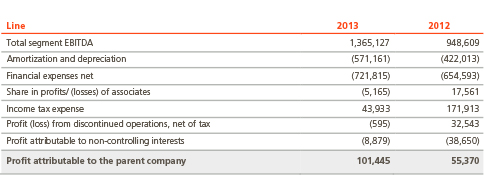
b) The long term assets and liabilities by Segment at the end of 2013 and 2012 are as follows:
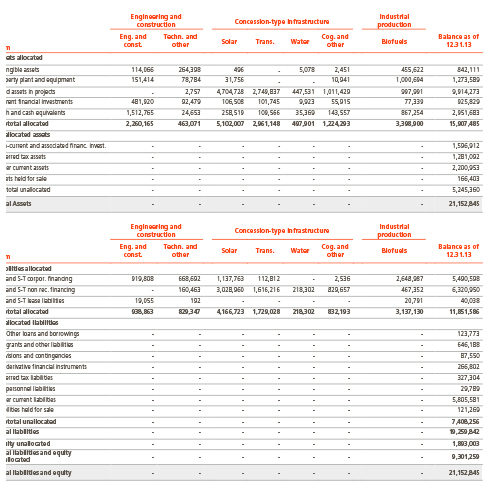
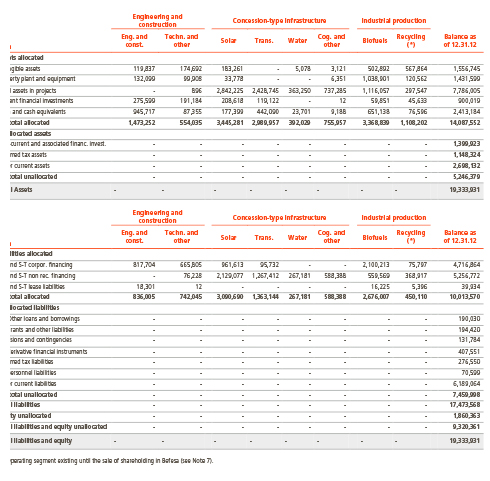
The criteria used to obtain the assets and liabilities per segment, are described as follows:
- With the only objective of presenting liabilities by segment, Corporate Financing signed by Abengoa, S.A. and Abengoa Finance, S.A.U. has been allocated by segments (see Note 20), since its main purpose is to finance investments in projects and in companies needed to expand businesses and lines of activity of the group.
c) Net Debt by segment as of December 31, 2013 and 2012 is as follows:
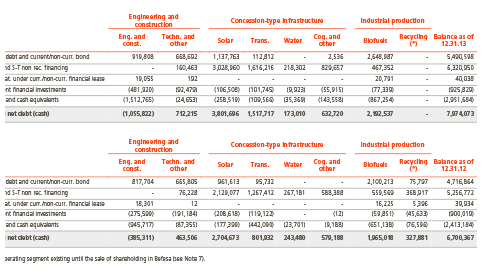
In order to obtain Net Debt, by segment:
- With the only objective of presenting liabilities by segment, Corporate Financing signed by Abengoa, S.A. and Abengoa Finance, S.A.U. has been allocated by operating segment (see Note 20), since its main purpose is to finance investments in projects and in companies needed to expand the businesses and lines of activity of the group.
- Short-term financial investments and Cash and cash equivalents are presented reducing debt, since both items are considered highly liquid, even though short-term financial investments do not fulfill all the conditions to be classified as cash and cash equivalents.
d) The Capex by segments for the years ended December 31, 2013 and 2012 is as follows:
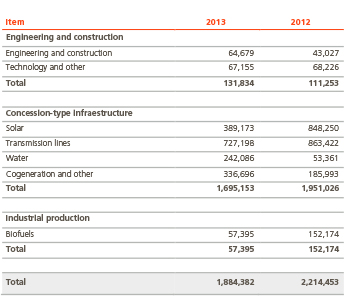
e) The distribution of depreciation, amortization and impairment charges by segments for the years 2013 and 2012 is as follows:
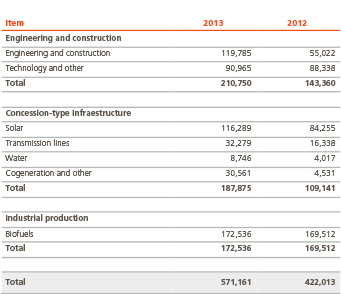
5.2. Information by geographic areas
a) The revenue distribution by geographical region for the years 2013 and 2012 is as follows:
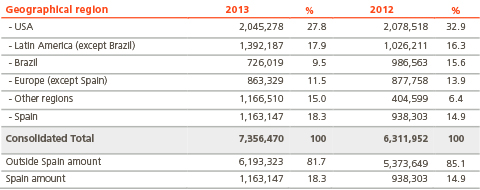
b) The net book value of Intangible assets and Property, plant and equipment by geographical region as of December 31, 2013 and 2012 is as follows:
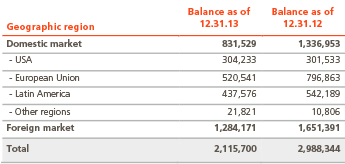
c) The net book value of Fixed assets in projects by geographic region as of December 31, 2013 and 2012 is as follows:
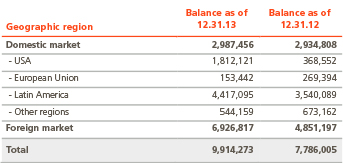
Note 6.- Changes in the composition of the group
6.1. Changes in the consolidation group
a) In 2013 a total of 56 subsidiaries (81 in 2012), 2 associates (3 in 2012) and 3 joint ventures (9 in 2012), were included in the consolidation group, which are identified in Appendices I, II, III, XII, XIII and XIV of these Consolidated Financial Statements.
These changes did not have a significant impact on the overall consolidated amounts in 2013 and 2012.
As described in Note 2.1.1 the Group has applied IFRS 10, 11, 12 and amendments to IAS 27 and 28 in 2013 (December 31, 2012 and January 1, 2012), recasting the information presented in 2012 according to the transition guidance of this standard. As a result 5 companies previously considered as subsidiaries and 33 companies previously considered as joint ventures are treated as associates recorded under the equity method in 2012. The effect of the de consolidation of the affected companies and their integration according to the equity method on the consolidated statements of financial position as of December 31, 2012 and January 1, 2012 and on the consolidated income statement for the year 2012 is shown in Note 2.1.1.
In addition, during 2013, 22 Temporary joint operations (UTE), (14 in 2012) 3 of them with partners which do not being to the Group, have commenced their activity or have started to undertake a significant level of activity and were included in the consolidation group.
On the other hand, the amounts set out below represent the Group's proportional interest in the assets, liabilities, revenues and profits of the UTE with partners non Group shareholding, which have been included in the Consolidated Financial Statements in 2013 and 2012:

b) In 2013 a total of 88 subsidiaries were no longer included in the consolidation group (46 in 2012), 4 associates (5 in 2012) and 9 joint ventures (7 in 2012), which are identified in Appendix IV, V and VI and which did not have any material impact in the Consolidated Income Statement, except for disposals mentioned in Note 6.2b).
During 2013, 17 UTE, (33 in 2013), which do not belong to the Group, were excluded from the consolidated group because they had ceased their activities or had become insignificant in relation to overall group activity levels. The proportional consolidated revenues of these UTE in 2013 were € 53 thousand (€271 thousand in 2012).
c) On October 13, 2013, Arizona Solar One, LLC which was recorded under the equity method during its construction phase entered into operation and started to be fully consolidated after we gained control over the entity (see Note 6.3).
During 2012, Rioglass group, which was consolidated proportionally until December 31, 2011, started to be fully consolidated due to the business combination conducted in this period (see Note 6.3).
6.2. Main acquisitions and disposals
a) Acquisitions
- There were no significant acquisitions during the year 2013 and 2012.
b) Disposals
- On May 2, 2013 the Company signed an agreement with Corning Incorporated to sell its Brazilian subsidiary, Bargoa S.A., a company which manufactures telecommunications components. The transaction price was set at 80 million US dollars. This sale brought Abengoa a cash inflow of 50 million US dollars and generated an after-tax profit of €29 million.
- On June 13, 2013 Abengoa signed a strategic agreement with the European private equity fund, Triton Partners (Triton), to sell 100% of Befesa Medio Ambiente, S.L.U. Note 7 on Discontinued operations and Non-current assets held for sale gives further details on this transaction.
- On March 16, 2012, the Company reached an agreement with Compañía Energética Minas Gerais (CEMIG) to sell the 50% stake that Abengoa S.A. still owned in four transmission line concessions in Brazil (STE, ATE, ATE II and ATE III). On July 2, we received €354 million of cash proceeds corresponding to the total price agreed for the shares. The gain from this sale has amounted to €4 million and is recorded in ‘Other operating income’ in the Consolidated Income Statements.
6.3. Business combinations
On October 13, 2013, Arizona Solar One, LLC, the Company that holds the assets in Solana thermo-solar plant in the United States, which was recorded under the equity method during its construction period, entered into operation and started to be fully consolidated once control over this company was gained.
As it is indicated in note 2.1.1.b), the Company reassesses whether or not it controls an investee when facts and circumstances indicate that there are changes to the elements that determine control (power over the investee, exposition to variable returns of the investee and ability to use its power to affect its returns). The Company concluded that during the construction phase of Solana plant all the relevant decisions were subject to the control and approval of the Administration. As a result, the Company did not have control over these assets during the construction period. IFRS 10 (B80) establishes that control requires a continuous assessment and that the Company shall reassess if it controls on investee if facts and circumstances indicate that there are changes to the elements of control. Once the project entered into operation, the decision making process changed, the investee was controlled and it started to be fully consolidated.
This business combination has been recorded in accordance with IFRS 3 ‘Business combinations’. Since during the construction period the assets were included under the scope of IFRIC 12, the book value of assets and liabilities consolidated is the same as its fair value.
The amount of assets and liabilities consolidated is shown in the following table:
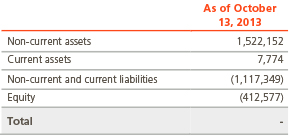
In 2012 the Group carried out the business combination of Rioglass Group. Rioglass Group was incorporated in 2006 as a joint venture between Abengoa and its former shareholders. The group manufactures and sells parabolic trough mirrors for thermo-solar plants.
Since the incorporation of Rioglass Group, thermo-solar energy has experienced a very high development worldwide, mainly in Spain and the United States. Recently, we can appreciate a significant international expansion in other geographies, with plants in construction in the Middle East, Africa and India and with ambitious plans to develop new thermo-solar plants in several countries such as South Africa, Australia, China, India, Saudi Arabia and Chile.
On January 16, 2012, Abengoa Solar, S.A. closed an agreement with Rioglass Laminar, S.L. to acquire an additional share of Rioglass Holding, S.A. With this acquisition and once the conditions for the closing were fulfilled, Abengoa Solar, S.A. became the majority shareholder of Rioglass Holding, S.L. and obtained control of the management of the group, a business which is key in its strategy of international expansion. As a result, Rioglass group, which was integrated proportionally, started to be fully consolidated.
Since the business combination was achieved in stages, according to IFRS 3, the Company has remeasured its previously held equity interest in the acquiree at its acquisition-date fair value, which has consisted basically in the value of committed sales from Rioglass Group for the use of technology and mirrors, linked to relations and contracts existing with clients in the construction of thermo-solar plants in Spain, the United States, South Africa, Mexico and India. This valuation has represented a gain of € 85,247 thousand.
The difference between the fair value of the stake acquired in Rioglass group and the fair value of the identifiable assets and liabilities acquired, amounting to € 38,919 thousand, was recorded as Goodwill.
Additionally, according to IFRS 3, the purchase price allocation, was as follows:

Note 7.- Discontinued operations and Non-current assets held for sale
7.1. Sale of shares in Befesa Medio Ambiente, S.L.U.
On June 13, 2013 the Company reached an exclusive agreement with certain investment funds managed by Triton Partners to wholly transfer Abengoa's shareholding in Befesa Medio Ambiente, S.L.U. The agreed sale price was €1,075 million (considering the net debt adjustments, total consideration to Abengoa amounts to €620 million).
The sale of this shareholding involved a cash deposit of €331 million. The balance of the agreed payment, to complete the aforementioned figure of €620 million, consists of:
- A deferred payment of €17 million (€15 million held as a deposit until ongoing litigations are resolved and two million Euros in long-term receivables from a client of Befesa Medioambiente).
- A credit note of €48 million to mature in five years, accruing annual interest of 2% in the first year, 4% in the second, 6% in the third, 8% in the fourth and 12% in the fifth year, and payable at the expiration of each period.
- A deferred payment of €225 million through a convertible loan with 15 years maturity and subject to two extension options of five years each at the discretion of the venture capital fund. The loan's principal shall be settled with a single repayment at maturity and accrues interest at the 6-month Euribor, plus a 6% spread, with an option for the fund to capitalize or pay interest at the end of each accrual period. Certain triggering events, which include Befesa's insolvency, a maximum net debt/EBITDA ratio of 8.0 throughout the life of the convertible loan, and failure to meet certain financial objectives in the last three years of the 15-year loan (minimum expected operating cash flow, minimum cash coverage ratio of 1.3) would result in the automatic conversion of the loan into 14.06% of Befesa's shares. Furthermore, under certain scenarios of sale of Befesa by the fund, and conversion of the convertible loan into the 14.06% of Befesa’s shares, the fund can require that Abengoa sells its 14.06% ownership together with the sale of the fund’s ownership and under the same conditions applicable to the fund. In any case, if Abengoa does not receive such requirement from the fund, Abengoa can sell its 14.06% ownership coming from the conversion together with the remaining ownership sold by the fund and in this case the sale will be valid only if the acquirer also bought the 14.06%.
The convertible loan is a hybrid instrument including a loan receivable and multiple embedded derivatives. According to IAS 39, derivatives which are not closely related with the host contract (the loan receivable) should be accounted for separately. In our case, the value of all the options which are not closely related with the host contract is mainly based in the performance of Befesa and in consequence they are considered as a single derivative instrument.
In accordance with the provisions of IAS 39, the hybrid financial instrument has been initially valued at fair value, amounting to €170 million, as the sum of the loan receivable and the derivatives as a whole. The fair value of the loan has been determined taking into account capitalization of accrued interest and a discount rate equal to the Spanish bond with a similar maturity plus a market spread of approximately 4.5%. The embedded derivative has been initially valued close to zero, because the occurrence of any of the events that would trigger the conversion is highly unlikely. In subsequent periods, the loan receivable is valued at amortized cost and the derivatives are valued at fair value, with changes in profit and loss. The probability of occurrence of conversion events will be periodically monitored to calculate the embedded derivatives fair value. As of December 31, 2013, the fair value of the embedded derivative has remained close to zero (see Note 3.1).
The convertible loan is included in ‘‘Other Receivable Accounts’’ in non-current assets and the derivative is included in non-current ‘Derivative liabilities’ in the Consolidated Statements of Financial Position.
The sale transaction generated a gain of €0.4 million in the ‘Results for the year from discontinued operations, net of taxes’ in the Consolidated Interim Income Statement for the year, 2013.
Taking into account the significance that the activities carried out by Befesa have for Abengoa, the sale of this shareholding is considered as a discontinued operation in accordance with the stipulations and requirements of IFRS 5, ‘Non-Current Assets Held for Sale and Discontinued Operations’.
In accordance with this standard, the results of Befesa until the closing of the sale and the result of this sale are included under a single heading in Abengoa’s Consolidated Financial Statements for the year ended December 31, 2013. Likewise, the Consolidated Income Statement for the year, 2012, which is included for comparison purposes in Abengoa’s Consolidated Financial Statements for the year ended December 31, 2013 also includes the results generated by Befesa under a single heading, for the activities which are now considered discontinued.
Below is the breakdown of the Consolidated Interim Income Statements related to Befesa up to the date of sale (January 13, 2013) and for the year 2012:

Additionally, below is the composition of the heading ‘Profit (loss) from discontinued operations, net of tax’ included in the Consolidated Interim Income Statements for year 2013:

7.2. Assets held for sale -shares in BCTA Qingdao, S.L.
As of December 31, 2013, the Company has started a process of negotiations to sell its 92.6% interest in Qingdao BCTA Desalination Co., Ltd., (‘Qingdao’) a desalination plant in China. Given that as of that date the subsidiary was available for inmediate sale and the sale is highly probable, the Company has classified the assets and liabilities of Qingdao as held for sale in the Consolidated Statement of Financial Position as of December 31, 2013. Until closing of the sale transaction, the assets will be reported as held for sale in accordance with the stipulations and requirements of IFRS 5, Non-Current Assets Held for Sale and Discontinued Operations.
As of December 31, 2013, the breakdown of the assets and liabilities classified as Held for Sale, are as follows:
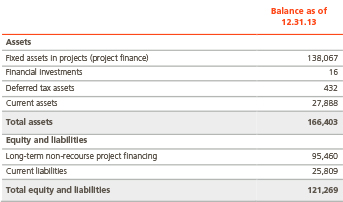
Note 8.- Intangible assets
8.1. The following table sets out the movement of intangible assets in 2013:

The decrease in goodwill is mainly due to the exclusion of Befesa from the consolidation scope (see Note 7) and due to the negative effect of the depreciation of the Brazilian real with respect to the Euro.
The cost of intangible assets has increased principally due to the investment effort in research and development projects (see Note 8.3) offset by the reclassification of the fixed assets related to the Solaben 1 and 6 thermosolar plants as Fixed assets in projects, once the non-recourse financing for these projects has been obtained (see Note 10.1).
During 2013 no significant losses from impairment of PP&E were recorded.
8.2. The following table sets out the movement of intangible assets in 2012:
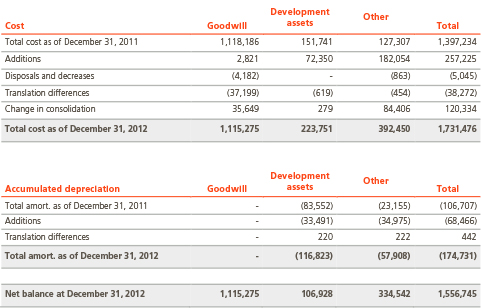
Goodwill remained stable: the increase arising from the business combination of the Rioglass group, by €38,919 thousand, was offset by the negative effect of translation differences, arising mainly from the depreciation of the Brazilian real with respect to the Euro. Additionally, the business combination of Rioglass caused that intangible assets identified in the purchase price allocation were recorded at fair value and fully consolidated, in accordance with IFRS 3, which explained the increase in the rest of the intangible assets (see Note 6.3), together with the progress in the construction of several thermo-solar plants in Spain (€172 million) and investment effort in research and development projects (see Note 8.3).
During 2012 no significant losses for impairment of intangible assets were recorded.
8.3. Development assets
During 2013, Abengoa made significant Research, Development and Innovation (R&D&i) investment efforts, investing a total of €426,358 thousand (€91,260 thousand in 2012) through the development of new technologies in different areas of business (solar technology, biotechnology, desalination, water treatment and reuse, hydrogen, energy storage and new renewable energies).
The following table summarizes the total investments made in R&D&i in 2013 and 2012:

Last year, 2013, demonstrated Abengoa’s strategic commitment to technology as a vector for growth and a source of competitive advantage in its energy and environment sectors. In order to strengthen its R&D model, Abengoa Research (AR), the company that heads Abengoa’s technological development, has been structured into five scientific-technological areas aligned with the businesses in which the company applies its technology, consisting of biotechnology, bioenergy, waste; processes, water and hydrogen; and electrical systems and power electronics. Through these areas, Abengoa develops and strengthens the company’s existing and future technologies.
The main development assets come from technologies that enable progress to be made in Abengoa’s strategic R&D areas; technologies for high-performance thermo-electric solar plants, bio-refineries, treating municipal solid waste for energy production, and water treatment plants.
To increase its technological capacity, Abengoa has added two research laboratories to its existing assets. The Soland laboratory specializes in solar technology, while the Abengoa Research laboratory is equipped with experimental facilities and covers the majority of the company’s scientific areas. Furthermore, this year the Technology Surveillance and Patents Office, which was created in 2012 and manages all the intellectual property activities, has consolidated its position. To date, Abengoa has filed 261 patent applications, of which 106 have been granted, with the number of patent applications rising by more than 20% compared to 2012.
In solar-thermal technology it is worth noting the start of construction of Khi Solar One, the world’s first commercial plant using tower technology and superheated steam, in South Africa. The 50 MW plant is expected to come into operation at the end of 2014.
In the area of biofuels, Abengoa has continued to construct the commercial bio-refinery plant in Hugoton, which will come into operation in the second quarter of 2014. The technology used in this plant has been developed and proven by Abengoa over the last ten years at the second generation (2G) demonstration plant in Salamanca, Spain. A waste to biofuels (W2B) demonstration plant has also been operated at the same complex, which is capable of obtaining second-generation biofuels from recovered municipal solid waste (MSW). In addition to this progress, Abengoa continues to develop various processes to obtain high value-added bio-products from biomass, such as a catalyst that has been patented that enables biobutanol to be produced from ethanol using a catalytic process. This technology offers an additional advantage since it can be applied at the company’s existing conventional biofuels facilities.
Taking into account the investment in Khi Solar One, Hugoton and the waste to biofuels demonstration plant and the rest of our activities expensed or capitalized, total investment in R&D during the year has amounted to € 426,358 thousand (€91,260 thousand in 2012).
Progress also continues in developing and optimizing various technologies related to desalination, treating drinking water and other water treatments and reuse, all based on improvements in the operating conditions of ultra-filtration membranes, which are fundamental for achieving high levels of water purity and quality.
8.4. Goodwill
The table below shows the breakdown of Goodwill as of December 31, 2013 and 2012:
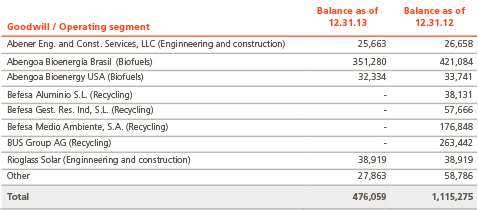
In 2013, the decrease is due to the exclusion of Befesa from the consolidation scope (see Note 7), as well as the negative effect of the translation differences mainly due to the depreciation of the Brazilian real with respect to the Euro.
Based on the values in use calculated in accordance with the assumptions and hypothesis described in Notes 2.8 and 3, in 2013 and 2012 the recoverable amount of the cash generating units to which goodwill was assigned is higher than their carrying amount.
For each goodwill, sensitivity analysis have been performed, especially in relation to discount rates, terminal values and changes in the main business key variables, to ensure that potential changes in valuation do not make cash generating units fair value lower than its book value.
8.5. There are no intangible assets with indefinite useful life other than goodwill. There are no intangible assets with restricted ownerships or that may be under pledge as liabilities guarantee.
Note 9.- Property, plant and equipment
9.1. The table below shows the movement on the different categories of Property, plant and equipment (PP&E) for 2013:
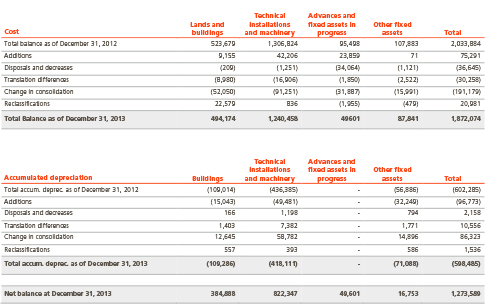
In 2013, the decrease in Property, plant and equipment was mainly due to the exclusion of Befesa Medio Ambiente, S.L.U. (see Note 7) and Bargoa, S.A. (see Note 6.2.b) from the consolidation scope following the sales of their shareholdings (-€105 million). However, there was an increase due to construction of a new metal structures manufacturing plant in India; the construction and equipping of a research laboratory in Spain; and the acquisition of machinery for projects in Peru.
During 2013 no significant losses from impairment of PP&E were recorded.
9.2. The table below shows the movement on the different categories of Property, plant and equipment (PP&E) for 2012:

Property, plant and equipment cost decreased in December 31, 2012 when compared to December 31, 2011 due to the dismantling of Rontealde (Vizcaya) desulfuration plant and to the reclassification from ‘PP&E’ to ‘Intangible assets in projects’ of the fixed assets related with the Mojave solar plant in the United States, once the construction of the plant started after obtaining the project financing. This effect was partially offset by the recognition of the Rioglass Group’s business combination described in Note 6.3, which resulted in the consolidation of 100% of the identifiable fixed assets of the group and its valuation at fair value in compliance with IFRS 3.
During 2012, no significant losses from impairment of PP&E were recorded.
9.3. Property, plant and equipment not assigned to operating activities at the year-end is not significant.
9.4. The companies’ policy is to contract all insurance policies deemed necessary to ensure that all Property, plant and equipment is covered against possible risks that might affect it.
9.5. The amount of capitalized interest costs included in PP&E at December 31, 2013 was €1,846 thousand (€2,051 thousand in 2012).
9.6. At the end of 2013 and 2012, Property, Plant and Equipment include the following amounts where the group is a lessee under a finance lease:

9.7. The cost of lands included in the lands and building subcategory amounted to €82,205 thousand at December 31, 2013 (€94,907 thousand in 2012).
9.8. The table below sets out the information related to those assets constructed by the Group during 2013 and 2012 classified under the heading Property, plant and equipment of the Consolidated Statement of Financial Position):

Note 10.- Fixed assets in projects (project finance)
As indicated in Note 2.5 included in the Group are several companies which engage in the development of projects including the design, construction, financing, operation and maintenance of owned assets or assets under concession-type agreements which are financed through non-recourse financing.
This note provides a breakdown of fixed assets within such companies. Non-recourse financing details related to such companies are disclosed in Note 19 of these Notes to the Consolidated Financial Statements.
10.1. Concession assets in projects.
a) The following table shows the movements of ‘Concession assets in projects’ for 2013:
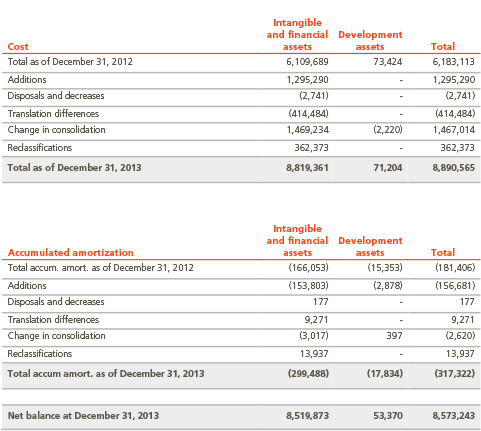
The increase in the cost of concession assets is primarily due to progress in developing infrastructure concessions projects, mainly various transmission lines in Brazil and Peru (€727 million); projects in México (€381 million); the Palmatir and Cadonal wind farms in Uruguay (€114 million) and the desalination plants in Ghana and Algeria (€83 million).
Additionally, the increase is caused by the reclassification due to transfer of the fixed assets related to the Solaben 1 and 6 thermosolar plants in Spain from PP&E (see Note 8.1); and the change in the consolidation scope following the entry into operation and control of the company Arizona Solar One, LLC (see Note 6.3), partially offset by the reclassification of the assets of the Quingdao desalination plant under Assets Held for Sale (-€142 million), see Note 7.2, and the depreciation of the Brazilian real and the US dollar with respect to the Euro.
No significant losses from impairment of ‘Concession assets in projects’ were recorded during 2013.
b) The following table shows the movements of intangible assets included in the heading ‘Concession assets in projects’ for 2012:
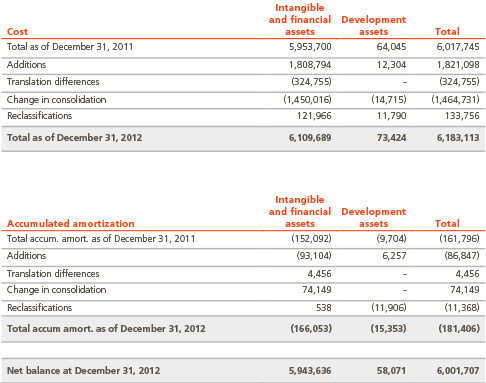
During 2012 concession assets increased due to Concession projects in process, mainly solar-thermal power plants in Spain (€511 million), as well as the cogeneration plant in Mexico (€97 million) and transmission lines in Brazil and Peru (€860 million). This increase was partially offset by the implementation of new standards IFRS 10 and IFRS11 (€-1,373 million) retroactively applied until January 1, 2012 (see Note 2.1.1.), and by the net negative effect of translation differences.
No significant losses from impairment of ‘Concession assets in projects’ were recorded during 2012.
- Capitalized interest cost for the year ended December 31, 2013 amounts to €115,113 thousand (€172,854 thousand in 2012).
- There are no intangible assets with indefinite useful lives. There are no intangible assets restricted for use or pledged as security for liabilities.
- As of December 31, 2013, concessional financial assets amount to €729,611 thousand.
- Appendix VII to these Consolidated Financial Statements includes certain information on project companies included within the scope of IFRIC 12.
10.2. Other assets in projects
a) The table below shows the movement in ‘Other assets in projects’ for 2013:

The decrease in Other assets in projects is primarily due to changes in the consolidation scope caused by the sale of the shareholding in Befesa Medio Ambiente, S.L.U. (-€290 million), see Note 7, as well as the negative effect of the depreciation of the Brazilian real with respect to the Euro.
No significant losses from impairment of ‘Other assets in projects’ were recorded during 2013.
b) The table below shows the movement in ‘Other assets in projects’ for 2012 :
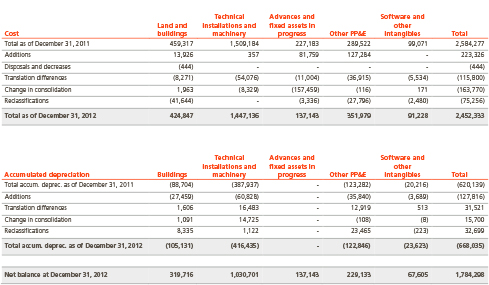
During 2012, the decrease of fixed assets in projects was mainly due to the implementation of the changes in IFRS 10 and IFRS 11 (€ -132 million), retroactively applied until January 1, 2012 (see Note 2.1.1) and the negative effect of the depreciation of the Brazilian Real with respect to the Euro. This decrease was partially offset by the increased biological assets in the bioenergy business in Brazil.
During 2012, no significant losses from impairment of ‘Other assets in projects’ were recorded.
c) Borrowing costs capitalized for the years ended December 31, 2013 and 2012 amounted to €1,635 thousand, €19,484 thousand.
d) The fixed assets in projects have no mortgage warranty additional to the ones assigned to its non-recourse financing (see Note 19).
e) It is the policy of the Group to enter into a number of insurance policies to cover risks relating to property, plant and equipment.
f) In cases of property plant and equipment over third party land, the company has estimated the dismantling costs of affected items, as well as the rehabilitation costs of the place where they are settled. See Note 22.1.
10.3. Assets constructed by group
The table below sets out the information related to those assets constructed by the Group during 2013 and 2012 classified under the heading fixed assets in projects of the Consolidated Statement of Financial Position (concessions and other assets in projects):

Note 11.- Investments in associates
11.1. The table below shows the breakdown and the movement of the investments held in associates for 2013 and 2012:

The increase in 2012 was mainly due to the initial application of IFRS 10 and 11 from January 1, 2012 (€855.6 million), see Note 2.1.1.
11.2. The tables below shows a breakdown of assets, revenues and operating profit as well as other information of interest for the years 2013 and 2012 of the associated companies:
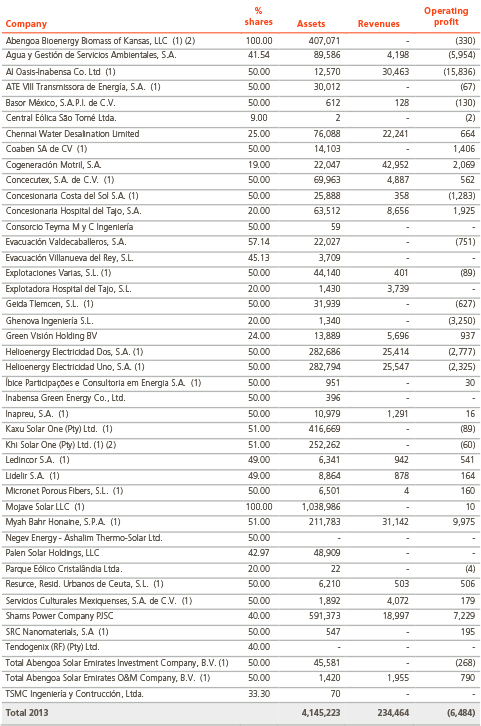
(1) Project companies recorded under the equity method after application of IFRS 10 and 11 effective from January 1, 2013 and retroactively applied from January 1, 2012.
(2) The assets heading includes assets under development related to the ethanol production plant in Kansas (USA), which uses biomass and second-generation technology, totaling €369,882 thousand (€145,801 thousand in 2012), and the solar-thermal power plant that uses tower technology and concentrated solar power in South Africa, totaling €104,357 thousand (€9,500 thousand in 2012) applying the shareholding that the Company holds. See Note 8.3 for more details of assets under development.
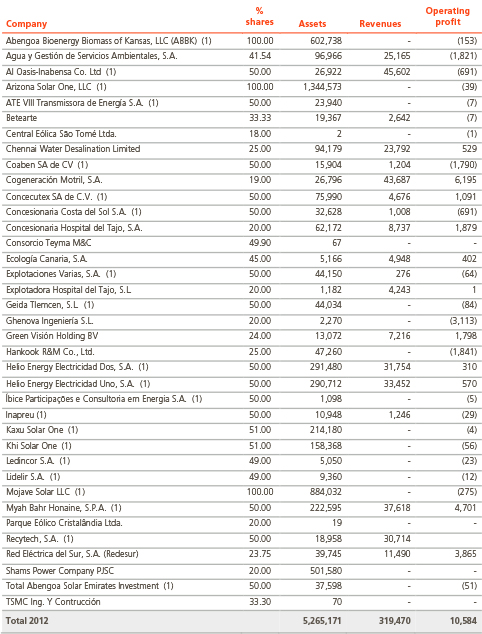
Note 12.- Financial instruments by category
The Group’s financial instruments are primarily deposits, clients and other receivables, derivatives and loans. Financial instruments by category (current and non-current), reconciled with the Statement of Financial Position, are as follows:

The information on the financial instruments measured at fair value, is presented in accordance with the following level classification:
- Level 1: Quoted prices in active markets for identical assets or liabilities.
- Level 2: Measured on inputs other than quoted prices included within Level 1 that are observable for the asset or liability, either directly (i.e. as prices) or indirectly (i.e. derived from prices).
- Level 3: Measured on inputs for the asset or liability that are not based on observable market data (unobservable inputs).
The following is a breakdown of the Group’s assets and liabilities measured at fair value at December 31, 2013 and 2012 (except assets and liabilities with a carrying amount close to their fair value, non-quoted equity instruments measured at cost and contracts with components that cannot be measured reliably):

The financial instruments at fair value, determined from prices published in active markets (Level 1), consist of shares.
The majority of Abengoa's portfolio comprises financial derivatives designated as cash flow hedges, is classified as level 2 and corresponds mainly to the interest rate swaps (see Note 14).
The caption Non-hedging derivatives accounting includes the fair value of the derivatives embedded in the convertible notes, the fair value of the call options over Abengoa’s own shares, as well as those derivatives purchased with the purpose of hedging a market risk (interest rate, foreign exchange or commodities) that do not fulfil all the requirements, according to IAS 39 to be recorded as hedges from an accounting point of view.
Level 3 corresponds mainly to the 3% interest held by Abengoa, S.A. in Yoigo, S.A., a Spanish telecom operator, recorded at fair value of €32,997 thousand and held through the ownership of Siema Investments, S.L. (a holding company owned 100% by Abengoa, S.A.).
The valuation method used to calculate the fair value was discounting cash flows based on its business plan, using as discount rate a weighted average cost of capital (WACC) of market, 10%. It also has been made a sensitivity analysis considering different discount rates and deviations of the business plan in order to ensure that potential valuation changes do not worsen in any case the fair value.
Additionally, the embedded derivative of the convertible loan received as part of the consideration for the sale of Befesa (See Note 7.1), is classified within Level 3. As of December 31, 2013, the embedded derivative has a negative fair value of €36 thousands.
If the equity value of Befesa had increased by 10%, assuming that the average horizon of permanence of the financial fund before the sale of Befesa did not change compared with respect to the hypotheses considered in assessing, the fair value of the embedded derivative would have increased €20 thousand.
The following table shows the changes in the fair value of level 3 assets for the years ended December 31, 2013 and 2012:
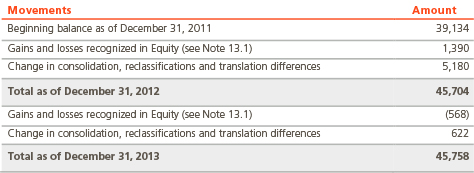
During the periods ended December 31, 2013 and 2012, there have not been any reclassifications amongst the three levels presented above.
Note 13.- Available-for-sale financial assets
13.1. The following table shows the detail and the movement on available-for-sale financial assets during 2013 and 2012:
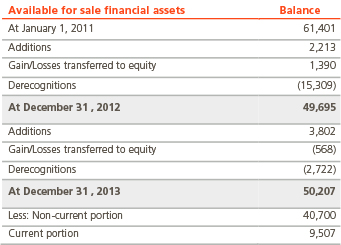
13.2. The following table shows those entities which, in accordance with the then current legislation, were not consolidated in the years 2013 and 2012 and in which the parent company’s direct and indirect shareholding is higher than 5% and lower than 20%. The net carrying amount of these holdings is €8,159 thousand at December 31, 2013 (€8,626 thousand in 2012).
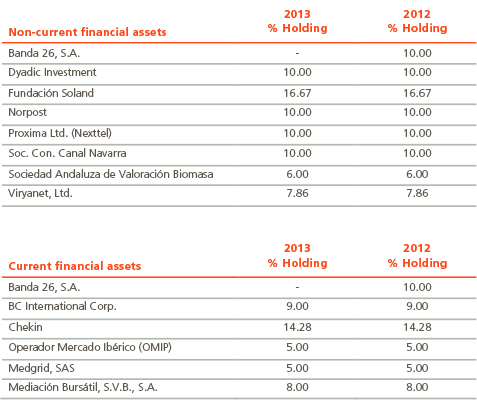
13.3. All necessary notifications have been made to the companies in which the Group holds an interest of over 10%, as required under Article 155 of Spanish Corporate Law (Ley de Sociedades de Capital).
13.4. There are no circumstances which have a material impact on the financial assets on the Group’s portfolio, such as litigations, pledges, etc.
13.5. There are no firm agreements in place regarding the sale or purchase of these investments which could be considered material in relation to the Group’s Financial Statements.
13.6. The amount of interest accrued but not yet collected is not material.
13.7. There are no fixed-yield securities in arrears. The average rate of return on fixed-yield securities is in line with the market.
13.8. As of December 31, 2013 and 2012, Abengoa, S.A. held a 3% interest in Yoigo, S.A, a Spanish telecom operator, recorded at fair value of €32,997 thousand and held in the Group through the ownership of Siema Investments, S.L. (a holding company owned 100% by Abengoa, S.A.). Additionally the shareholders of Yoigo have granted this company several ‘participative’ loans in accordance with a pre-established plan, which involved a total disbursement of €21,030 thousand (as of December 31, 2013 and 2012), equivalent to 3% of the total loan made to the company by its shareholders in said years.
To value this holding, as in prior periods, once Yoigo’s activities had commenced, the principal reference point taken is the company’s future cash-flow generation on the basis of its current Business Plan, discounted at a rate appropriate to the sector in which this company operates (See Note 12).
As a result of the purchase of its holding in Yoigo, Siema Investment, S.L. became responsible, for furnishing guarantees to the Spanish Administration as security for compliance with the commitments relating to investment, commercialization, employment and network development acquired by Yoigo, together with other guarantees relating to the Radioelectronic Spectrum Rate, which the Group is required to counter-guarantee, for a total amount of €3,387 thousand (€12,085 thousand in 2012).
13.9. The Group applies IAS 39 to determine whether the carrying amount of an available-for-sale financial asset has been impaired. This process requires significant judgment. To make this judgment, the Group assesses, among other factors, for how long and to what extent the fair value of an investment will be below its cost, considering the financial health and short-term prospects of the company issuing the securities, including factors such as the industry and sector return, changes in the technology and cash flows from operating and financing activities.
Note 14.- Derivative financial instruments
14.1. The fair value of derivative financial instruments (see Note 12) as of December 31, 2013 and 2012 is as follows:

Information about the valuation techniques of derivative financial instruments is described in Notes 2.11 and 12.
Derivatives classified as non-hedge accounting are those derivative financial instruments which, although obtained for the purpose of hedging certain market risks (interest rates, exchange rates and commodity prices), do not meet the specific requirements established by IAS 39 to be designated as hedging instruments from an accounting point of view (since, at the inception of the hedge, there was no designation or formal documentation relating to the hedge or the risk management strategy that it was intended to implement) or, having complied with all of the requirements to be designated a hedging instrument, the underlying has been sold or the hedging designation has been interrupted.
Fair value of derivative assets increased during 2013 due to new interest rate derivatives contracted, which was partially offset by the decrease in fair value of call options on Abengoa’s own shares that were signed to hedge the convertible notes, mainly due to a decrease in the stock price of the shares of Abengoa, which is a principal factor in the fair value of the embedded derivatives and the options.
The fair value of derivative liabilities decreased during 2013 mainly due to the favorable evolution of hedging interest rate derivatives, measured according to IFRS 13. Additionally there has been an increase due to the recognition of the embedded derivative component of convertible notes issued in January 2013 (see Note 20.3), partially offset by the decrease in the fair value of the derivative liabilities embedded in convertible notes issued in 2009 and 2010 and by the partial cancellation of the embedded derivative component of convertible notes due 2014 once the repurchase process has been completed on January 17, 2013.
The fair value amount recognized in the Consolidated Income Statement of the 2013 and 2012 fiscal year for the financial instruments derivatives designated as hedging instruments is a loss of €88,924 thousand (loss of €96,172 thousand in 2012).
Included in the following sections are detailed fair value presentations of each of the categories of derivative financial instruments presented in the table above. The net position of assets and liabilities for each line item of the summary table above reconciles with the net amount of the fair values of collections and payments for exchange rate derivatives, the net amount of the fair values of caps and swaps for interest rates hedges and the net amount of the fair values of commodity price derivatives, respectively.
14.2. Exchange rate hedges
The terms ‘Collection hedges’ and ‘Payment hedges’ refer to foreign currency derivatives designated as hedging instruments of future cash inflows and outflows associated to highly probable forecasted sales and purchase, respectively, denominated in a foreign currency.
The following table shows a breakdown of the notional amounts of the financial instruments relating to amounts receivable and payable in foreign currencies as of December 31, 2013 and 2012.
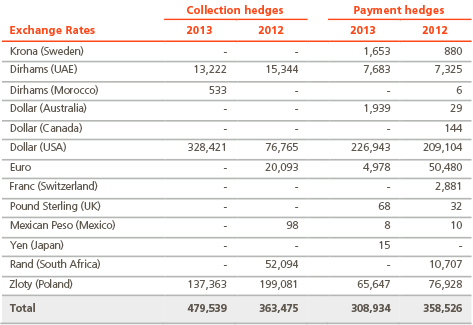
The following table shows a breakdown of the fair values of exchange rate derivatives relating to amounts receivable and payable in foreign currencies as of December 31, 2013 and 2012:

a) Cash flow hedges
The table below shows a breakdown of the maturities of notional amounts of exchange rate derivatives designated as cash flow hedges at the end of 2013 and 2012:

The table below shows a breakdown of the maturities of fair value amounts of exchange rate derivatives designated as cash flow hedges at the end of 2013 and 2012 year end:

The net amount of the fair value of exchange rate derivatives designated as cash flow hedges transferred to the Consolidated Income Statement in 2013 and 2012 has been of €-5,211 thousand and €1,033 thousand, respectively (see Note 18.3).
The ineffective amount recognized in the Consolidated Income Statement for the years 2013 and 2012 with respect to exchange rate derivatives designated as cash flow hedges amounts to €1,040 thousand and €-17,193 thousand, respectively.
The after-tax gains/losses accumulated in equity in connection with exchange rate derivatives designated as cash flow hedges at December 31, 2013 amounted to €-4,362 thousand (€-17,395 thousand in 2012). See note 18.3.
b) Fair value hedges
The group does not have any exchange rate derivatives designated as fair value hedges at the end of 2013 and 2012.
c) Non-hedge accounting derivatives
At the end of 2013 and 2012 the Group does not hold any exchange rate non-hedge accounting derivatives instruments.
The net amount of the fair value of exchange rate derivatives charged directly to the Consolidated Income Statement as a result of not meeting all the requirements of IAS 39 to be designated as hedges represented an impact of €283 thousand (€-19,947 thousand in 2012) (see Note 30.2).
14.3. Interest rate hedges
As stated in Note 4 to these Consolidated Financial Statements, the general hedging policy for interest rates is to purchase call options in exchange of a premium to fix the maximum interest rate cost. Additionally, under certain circumstances, the company also uses floating to fixed interest rate swaps.
As a result, the notional amounts hedged, strikes contracted and maturities, depending on the characteristics of the debt on which the interest rate risk is being hedged, can be diverse:
- Corporate Financing: we hedge between 78% and 100% of the notional amount, with maturities up to 2022 and average guaranteed interest rates of between 0.70% and 4.75% for loans referenced to the 1-month, 3-months and 6 months Euribor rates.
- Non-recourse financing:
- Non-recourse financing in Euros: we hedge between 80% and 100% of the notional amount, maturities until 2032 and average guaranteed interest rates of between 0.75 % and 4.87%.
- Non-recourse financing in US Dollars: we hedge between 75% and 100% of the notional amount, including maturities until 2028 and average guaranteed interest rates of between 0.70% and 3.787%.
a) Cash flow hedges
The table below shows a breakdown of the maturities of notional amounts of interest rate derivatives designated as cash flow hedges at the 2013 and 2012 year end:

The table below shows a breakdown of the maturity of the fair values of interest rate derivatives designated as cash flow hedges at the 2013 and 2012 year end:

The net amount of the fair value of interest rate derivatives designated as cash flow hedges transferred to the Consolidated Income Statement in 2013 and 2012 has been of €-94,226 thousand and €-75,664 thousand, respectively (see Note 18.3).
The after-tax gains/losses accumulated in equity in connection with derivatives designated as cash flow hedges at the end of 2013 and 2012 amount to € -151,733 thousand and €-273,966 thousand, respectively (see Note 18.3).
The net amount of the time value component of the cash flow derivatives fair value recognized in the Consolidated Income Statement for the years 2013 and 2012 has been € 21,734 thousand and €-24,221 thousand, respectively.
b)Fair value hedges
The Group does not have any interest rate derivatives designated as fair value hedges at the end of 2013 and 2012.
c) Non-hedges accounting derivatives
The table below shows a detail of the maturities of notional amounts of interest rate derivatives that not meet the requirements to be designed as hedging instruments at the end of 2013 and 2012:

The table below shows a detail of the maturities of fair values of non-hedge accounting interest rate derivatives at the end of 2013 and 2012:

At the end of 2013 and 2012, the net amount of the fair value of interest rate derivatives charged directly to the Consolidated Income Statement as a result of not meeting all the requirements of IAS 39 to be designated as hedges represented an impact of €534 thousand and €-4,305 thousand, respectively (see Note 30.1).
Additionally, a series of interest rate swaps and caps were settled in 2008, generating a positive cash flow upon liquidation. These contracts had been designated as cash flow hedge as a result of the respective effectiveness tests performed. Therefore, applying IAS 39, when the hedging instrument no longer exists and the hedged transaction continues to be probable, the cumulative gain or loss on the hedging instrument that remains recognized in equity from the period when the hedge was effective should remain in equity until the forecasted transaction occurs. This amount will be reclassified to profit or loss in the same period or periods in which the hedged forecasted transaction affects profit or loss. In the present case, it will be reclassified to profit or loss as the finance expense originated by the loan hedged is recognized in the Consolidated Income Statement. As a result, Abengoa will reclassify the profit recognized in equity to the Consolidated Income Statement following the swaplet method, where each interest rate calculation period of the swap is called a swaplet.
The balance calculated for each swaplet is recognized in the Consolidated Income Statement in the period of each swaplet. The amounts transferred from equity to the Consolidated Income Statement in 2013 and 2012 were a gain of €1,032 thousand and €7,695 thousand, respectively, with an amount of €0 thousand (€1,032 thousand in 2012) yet to be transferred to the Consolidated Income Statement in the following years.
14.4. Commodity price hedges
In relation to hedges of commodity prices, as stated in Note 2.10 of the Consolidated Financial Statements of Abengoa for the year ended on December 31, 2013, the different activities carried on by Abengoa through its different segments (Biofuels, Recycling (until the sale of shareholding in Befesa) and Engineering and construction) expose the group to risks derived from the fair value of certain commodity prices (zinc, aluminum, grain, ethanol and gas).
To hedge these risks, Abengoa uses derivative contracts and OTC derivatives for commodity prices.
a) Cash flow hedges
The table below shows a breakdown of the maturities of notional amounts for the commodity price derivatives designated as cash flow hedges at the 2013 and 2012 year end:

The table below shows a breakdown of the maturities of the fair value of commodity price derivatives designated as cash flow hedges at the 2013 and 2012 year end:
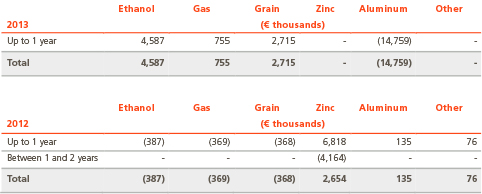
The net amount of the fair value of commodity price derivatives designated as cash flow hedges transferred to the Income statement in 2013 and 2012 has been of €10,513 thousand and €-21,541thousand, respectively (see Note 18.3).
The after-tax gains/losses accumulated in equity in connection with derivatives designated as cash flow hedges at December 31, 2013 amounted to €-7,674 thousand (€8,761 thousand in 2012), see Note 18.3.
b) Non-hedge accounting derivatives
At the end of 2013 and 2012, the Group does not hold non-hedge accounting derivative financial instruments of commodity prices.
The net amount of the fair value of commodity prices derivatives charged directly to the Consolidated Income Statement as a result of not meeting all the requirements of IAS 39 to be designed as hedges represented losses of €9,837 thousand (losses of €20,428 thousand in 2012) (see Note 30.3).
Note 15.- Clients and other receivable accounts
15.1. The breakdown of Clients and Other Receivable Accounts as of December 31, 2013 and 2012 is as follows:

As a general rule, ‘Unbilled revenues’ are billed within the three months following completion of the work being performed on the project. Nevertheless, given the highly-tailored characteristics of some construction contracts, some projects may take longer to be billed due to specific billing milestones in the contracts. The total outstanding balances as of December 31, 2013 and 2012 are supported by contracts signed with such customers and do not include any receivables relating to customer claims.
At the end of 2013 and the 2012 there were no balances with related parties (see Note 33.2).
15.2. The fair value of Clients and other receivable accounts does not differ significantly from its carrying value.
15.3. The list of Clients and Other Accounts Receivable according to foreign currency as at December 31, 2013 and 2012 are as follows:
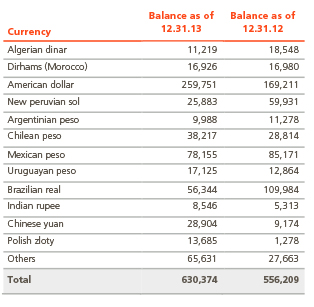
15.4. The following table shows the maturity detail of trade receivables as of December 31, 2013 and 2012:

15.5. The credit quality of outstanding Trade receivables, that are neither past due nor impaired, may be assessed under the following categories:

15.6. The movement in the bad debt provision for 2013 and 2012 is the following:

The most significant variations in 2013 are primarily due to recognition of doubtful trade loans with debtor balances that mostly correspond to public clients in Spain and abroad, against whom the corresponding claims have been made for the amounts owing from various construction projects, supported by the company’s formal procedures, depending on each case. Given the uncertainty in relation to the future recoverability of these loans, due to various factors but most of which are beyond the company’s control, it has been decided to make the corresponding provision. Once the process has been definitively resolved, and in the event that it is favorable for the company, the corresponding provision will be reversed against the “Reversal of unused amounts” heading.
The most significant variations for the year 2012 are due to the recognition of doubtful trade receivables mainly related to water infrastructure projects as well as other minor engineering and construction projects.
15.7. The Company maintains a number of non-recourse factoring lines of credit. The Company enters into these factoring agreements with certain financial institution by selling the Company’s credit rights in certain commercial contracts. The factoring agreements are entered into on a non-recourse basis, meaning that the financial institutions undertake the credit risk associated with the Company’s customers. The Company is responsible for the existence and legitimacy of the credit rights being sold to the financial institutions. Credit rights from recurring customers or with terms of up to one year are supported by annual revolving factoring lines of credit. Credit rights from non-recurring customers or with terms longer than a year are supported with global transfer agreements commencing on the date when the underlying commercial contract comes into force and expiring when the contracted works are completed.
At the end of the 2013 financial year, approximately €285 million (€360 million in 2012) were factored and derecognized pursuant to the provisions of IAS39.
The finance cost in the 2013 fiscal year derived from factoring operations amounted to €17 million (€24 million in 2012).
15.8. Furthermore, as of December 31, 2013 collections amounted to €298 million (€196 million in 2012), related to a construction contract for a combined cycle plant in Mexico with a transfer agreement of the non-recourse collection rights signed with a financial institution under the ‘Pidiregas’ deferred financing scheme, in which a financial institution provides the funds required to construct the project until the provisional handover of the plant, when the amount of the contract is paid directly by the client to the financial institution. Consequently, Abengoa is being paid as the construction milestones are completed. The financial expense associated with this scheme in 2013 amounted to €12 million (€20 million in 2012).
15.9. The breakdown of Tax receivables as of December 31, 2013 and 2012 is as follows:

15.10. The following table shows a breakdown of financial accounts receivable as of December 31, 2013 and 2012:
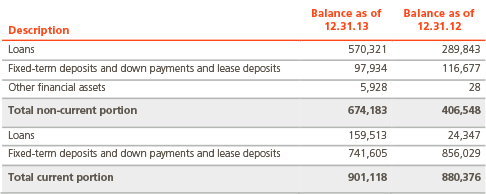
This heading includes the loans and other accounts receivable considered as non-derivative financial assets not listed in an active market, with a maturity period of less than twelve months (current assets) or exceeding that period (non-current assets).
The market value of these assets does not differ significantly from their carrying amount.
Current and non-current loans for an amount of €730 million in 2013 (€314 million in 2012), mainly includes the convertible loan and credit note received in the sale of Befesa (see Note 7.1) amounting €225 million, an account receivable of €141.8 million resulting from a favorable resolution from the Court of Arbitration of the International Chamber of Commerce in relation with the arbitration against Adriano Gianetti Dedini Ometto and Adriano Ometto Agrícola Ltda. (see Note 15.11), loans with associates amounting to €168 million, as well as credits with local administrations.
Current and non-current fixed-term and deposits for an amount of €840 million (€973 million in 2012) includes primarily restricted investments in fixed-income securities and bank deposits.
Other financial assets include other receivable amounts considered as non-derivative financial assets not listed in an active market, which are not classified in any of the other categories.
15.11. In November 2011, two related arbitration proceedings were concluded in our favor in the International Court of Arbitration of the International Chamber of Commerce with seat in New York, United States. Our subsidiary ASA Bioenergy Holding A.G. (‘ASA’) was awarded favorably in relation to demands for certain breaches of contract by Adriano Gianetti Dedini Ometto and Adriano Ometto Agrícola Ltda. (the ‘Adriano‘ Defendants). In each of the procedings, Adriano filed various counterclaims which were appropriately answered by us. Both arbitration proceedings were decided in ASA’s favor, in October 2012, when we received confirmation from the International Chamber of Arbitration in the approximate total amount of USD 118.3 million plus accrued interest. Adriano Defendants presented motions to vacate such arbitral awards in the ordinary courts of New York City, which was in turn decided in our favor, with full confirmation on the validity of the two awards in first instance. As a result, the Defendants appealed in the Second Circuit Court in New York. The appeal hearing took place in New York in December 2013. On January, 2014 the Second Circuit Court has decided again in favor of ASA. The last action that Adriano can take is to appeal to the Supreme Tribunal, which has remote chances of success, in the Directors opinion. In addition, the Company has started the actions to recognition of the awards in Brazil.
The resolution of the Second Circuit Court provides additional evidence of the existence of an account receivable as of December 31, 2013. As a result, an income and an account receivable have been recorded as of that date for an amount of € 142 million.
Note 16.- Inventories
16.1. Inventories as of December 31, 2013 and 2012 were as follows:
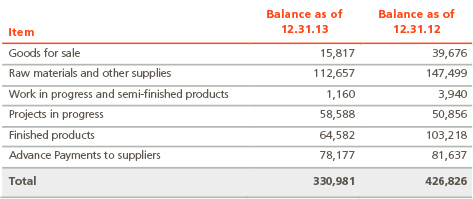
Inventories for entities located outside Spain were €219,447 thousand (€249,233 thousand in 2012).
16.2. There are no restrictions on the availability of inventories, with the exception of guarantees provided for construction projects in the normal course of business, which are released as the contractual milestones of the project are achieved.
Note 17.- Cash and cash equivalents
The following table sets out the detail of Cash and cash equivalents at December 31, 2013 and 2012:

The following breakdown shows the main currencies in which cash and cash equivalent balances are denominated:
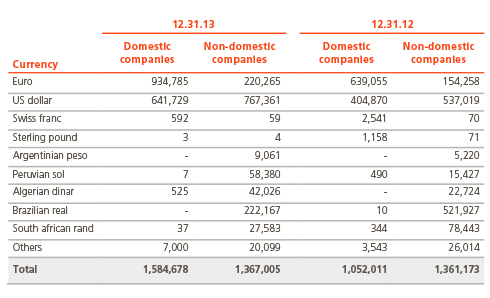
Note 18.- Shareholders’ equity
18.1. Share capital
As of December 31, 2013 the share capital amounts to €91,856,888.71 represented by two distinct classes of 825,562,690 shares completely subscribed and disbursed:
- 84,445,719 class A shares with a nominal value of 1 Euro each, all in the same class and series, each of which grants the holder a total of 100 voting rights (‘Class A Shares’).
- 741,116,971 class B shares with a nominal value of 0.01 Euros each, all in the same class and series, each of which grants One (1) voting right and which afford its holder economic rights identical to the economic rights of Class A shares as stated in article 8 of the Company’s by laws (‘Class B Shares’ and, together with class A shares, ‘Shares with Voting Rights’).
On October 17, 2013, we carried out a capital increase of 250,000,000 Class B shares and on October 29, 2013 we issued, as a result of the exercise of the option to purchase additional shares to cover over-allotment by the underwriters of the capital increase, 37,500,000 additional Class B shares (‘greenshoe’ option). The shares were offered at a price of €1.80 per share, for total gross proceeds, including shares sold pursuant to the greenshoe option, of €517.5 million.
With the net proceeds of the capital increase, the Company has repair in 2013 and intends to repay some of its corporate debt with maturities in 2014, totaling approximately €347 million including: (a) the first installment due under the Official Credit Institute Loan (€50 million); (b) the entirety of the EIB R&D&i 2007 Credit Facility and the EIB 2007 Credit Facility (€109 million); (c) installments due under the Swedish Export Buyer Credit Agreement and the Second Swedish Credit Agreement (€127 million); (d) and certain corporate loans of some of our subsidiaries (€37 million). The remaining part of the issue will be held for additional financial flexibility. The capital increase will strengthen the company’s balance sheet, reinforcing and optimizing its capital structure, as well as diversifying its sources of financing by providing access to the US capital markets.
Moreover, the controlling shareholder, Inversión Corporativa IC, S.A., has subscribed 35,000,000 shares with an investment of €63 million, so that following the capital increase the Inversión Corporativa group holds a 57.79% shareholding. As part of the capital increase, the company and Inversión Corporativa IC, S.A. agreed a lock-up clause for a period of 180 days under the standard terms for these types of transactions.
Class A and B shares are listed on the Madrid and Barcelona Stock Exchange and on the Spanish Stock Exchange Electronic Trading System (Electronic Market). Class A shares have been listed since November 29, 1996 and class B shares since October 25, 2012. The Company presents mandatory financial information on a quarterly and semiannual basis.
The new class B shares issued in the capital increased in 2013, are also listed on the NASDAQ Global Select Market in the form of American Depositary Shares (with five Class B shares exchangeable for one American Depositary Share).
In accordance with notifications received by the company and in compliance with reporting requirements to communicate shareholding percentages and the information received from relevant parties, shareholders with a significant holding as of December 31, 2013 are as follows:

On September 30, 2012, the Extraordinary General Shareholders’ Meeting approved a capital increase of 430,450,152 class B shares with a nominal value of €0.01per share, charged to our freely available reserves, which have been distributed for no consideration to all existing shareholders on the basis of four class B shares for each class A share or class B share which they hold (‘the Capital increase’). Consequently, this capital increase did not cause any dilution or concentration with respect to the shareholders previous ownership.
The General Shareholders’ Meeting approved a right of voluntary conversion for the class A shareholders to convert their class A shares with a nominal value of 1 Euro into class B shares with a nominal value of 0.01 Euros during pre-set windows until December 31, 2017. Following the exercise of this right, after each conversion window, a capital reduction has taken place and will take place, by reducing the par value of a number of converted class A shares to by 0.99 euros per share, with a credit to restricted reserves.
In the context of the Capital increase, Inversión Corporativa IC, S.A. (‘Inversión’) has agreed to (i) limit its voting rights to the 56% of the total voting rights of Class A shares and to guarantee (ii) that the percentage of voting shares held by Inversión Corporativa (whether they are class A shares or class B ordinary shares) over the total shares of the Company shall at no time be lower than one fourth of the percentage of voting rights that those shares provide to Inversión Corporativa, with respect to its total voting rights in the Company, meaning that its voting rights may not exceed four times its economic rights. Should that threshold be exceeded, Inversión Corporativa will transfer class A ordinary shares, or convert class A shares into class B shares, in such number as may be necessary to maintain such proportion.
During 2013 four capital conversions took place, through wich 1,173,788 Class A shares were converted into class B shares, which has resulted in a reduction of capital of €1,162 thousand.
Since the approval by the General Shareholder’s Meeting (September 30, 2012) of the afore-mentioned voluntary conversion light conversion right of class A shares into class B shares, eight capital conversions have taken place after eight conversion windows periods; the last one has finalized on January 15, 2014.
After such capital conversions the share capital as of January 27, 2014 after the end of the eighth conversion period amounts to €91,223,623.33 represented by two distinct classes of 825,562,690 shares completely subscribed and disbursed: 83,806,057 class A shares and 741,756,633 class B shares.
The General Shareholders’ meeting held on April 7, 2013 approved a dividend of €0.072 per share, which totals €38,741 thousand, compared to €37,664 thousand in the previous year. On April 9, 2013 the dividend was paid.
18.2. Parent company reserves
The following table shows the amounts and movements of the Parent Company Reserves in 2013 and 2012:

The amount corresponding to ‘Other movements’ for 2013 and 2012 is mainly part of operations carried out with treasury shares.
The Legal Reserve is created in accordance with Article 274 the Spanish Corporate Law (Ley de Sociedades de Capital), which states that in all cases an amount of at least 10% of the earnings for the period will be allocated to this reserve until at least 20% of the share capital is achieved and maintained. The Legal Reserve may not be distributed and, if used to compensate losses in the event that there are no other reserves available to do so, it should be replenished from future profits.
On November 19, 2007, the company entered into a liquidity agreement on class A shares with Santander Investment Bolsa, S.V. Replacing this liquidity agreement, on January 8, 2013, the company entered into a liquidity agreement on class A shares with Santander Investment Bolsa, S.V. in compliance with the conditions set forth in CNMV Circular 3/2007 of December 19. On November 8, 2012, the company entered into a liquidity agreement on class B shares with Santander Investment Bolsa, S.V. in compliance with the conditions set forth in CNMV Circular 3/2007 of December 19.
As of December 31, 2013 treasury stock amounted to 40,009,307 shares (14,681,667 shares in 2012), which 5,382,896 are class A shares and 34,626,411 are class B shares.
Regarding the operations carried out during the year, the number of treasury stock purchased amounted to 8,125,581 class A shares and 62,025,632 class B shares and treasury stock transferred amounted to 5,681,820 class A shares and 39,141,753 class B shares, with a net result of €-89,612 thousand recognized in equity (€-961 thousand in 2012).
The proposed distribution of 2013 profits of the Parent Company:
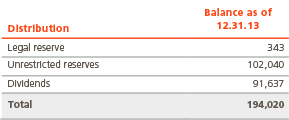
The proposed distribution of 2013 profits involves the payment of €0.111 per share in 2014. The Company paid a dividend of €0.072 per share in 2013.
18.3. Other reserves
Other reserves include the impact of the valuation of derivative instruments and available for sale investments at the end of the year.
The following table shows the balances and movements of Other reserves by item for 2013 and 2012:
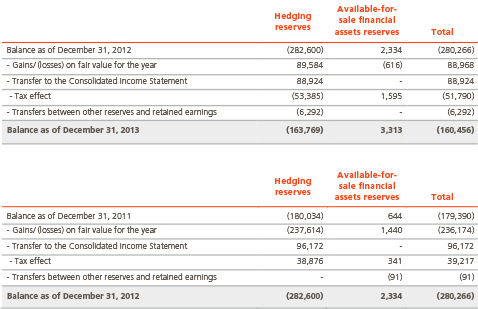
For further information on hedging activities, see Note 14.
18.4. Accumulated currency translation differences
The amount of accumulated currency translation differences for fully and proportionally consolidated companies and associates at the end of 2013 and 2012 is as follows:

The decrease in the accumulated currency translation differences is mainly due to the depreciation of the Brazilian Real against the Euro.
18.5. Retained earnings
The breakdown and movement of Retained earnings during the 2013 and 2012 fiscal years are as follows:

Amounts included under ‘Other movements’ mainly refer to the acquisition of various non-controlling interests, the effects of which is recorded in net equity as required by the revised IFRS 3.
The Reserves in full and proportionate consolidated entities and equity method investments are as follows:

Note 19.- Non-recourse financing (project financing)
As indicated in Note 2.2, there are certain entities within the Group for which, in general, the main commercial purpose is the long-term development of integrated products which are financed through non-recourse project finance. This note outlines the non-recourse financing linked to the assets included in Note 10 of these Consolidated Financial Statements.
Non-recourse financing is generally used for constructing and/or acquiring an asset, exclusively using as guarantee the assets and cash flows of the company or group of companies carrying out the activities financed. In most of the cases, the assets and/or contracts are set up as guarantee to ensure the repayment of the related financing.
Compared to corporate financing, non-recourse financing has certain key advantages, including a greater leverage period permitted and a clearly defined risk profile.
19.1. The balances and movements for 2013 and 2012 of non-recourse financing are set out in the table below:

The increase in 2013 was mainly due to the consolidation of Arizona Solar One (see Notes 2.1.1 and 6.3) by € 809 million and to new drawnings related to transmission lines projects (€ 605 million). In addition, the Company obtained new financing for the cogeneration plant in Tabasco, Mexico (€566 million). There were also new drawnings for thermosolar projects (€ 366 million), mainly Solaben 1 and 6 (€ 200 million).
Additionally, the Company has repaid € 377 million corresponding to the existing debt of the cogeneration plant in Tabasco, Mexico, which has been replaced by a new financing as referred to above. Furthermore, there have been repayments of debt related to thermosolar projects (- € 175 million) and transmission lines (- € 122 million). Non-recourse financing also decreased due to the sale of Befesa (- €369 million), to the classification of Qingdao as held for sale (- € 106 million) and to translation differences (- €348 million) mainly caused by the depreciation of brazilian real with respect to the euro.

During 2012 the increase in non-recourse financing was mainly due to drawings in relation to transmission lines amounting to €549 million. In addition, €217 million were drawn in relation with new solar projetcs and €48 million in relation to the co-generation project in Tabasco, Mexico. On the other hand, non-recourse financing decreased due to de-consolidation of companies resulting from the initial application of IFRS10 and 11 as of January 1, 2012 (€635 million) and due to translation differences (€-184 million decrease) mainly caused by the depreciation of Brazilian real with respect to the euro.
19.2. Within the assets on the Consolidated Statement of Financial Position and under the Cash and Cash equivalent and Financial Receivables (Current and non-current) headings, there are debt service reserve accounts in the amount of €156 million relating to project finance in 2013 (€192 million in 2012).
19.3. Appendix IX of this consolidated report details the Project companies as of the end of 2013 which are financed by Non-recourse project finance.
19.4. The repayment schedule for Non-recourse project financing, at the end of 2013 is as follows and is consistent the projected cash flows of the related projects.

Included within the amounts repayable there are balances relating to operations financed through non-recourse bridge loans (see Note 19.6) which will be repaid upon granting long-term non-recourse project financing.
19.5. Non-recourse financing projects entered into in 2013 and 2012 (in Millions of Euros) is as follows:
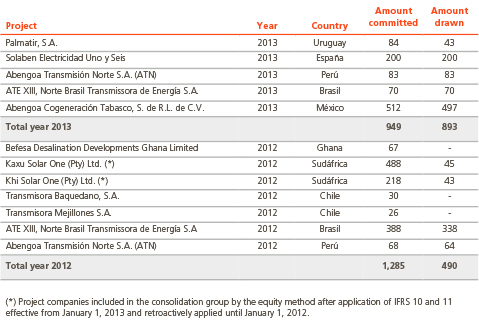
19.6. Non-recourse project finance applied to projects also includes Non-Recourse Finance in Process. This relates to certain operations which are financed in a similar manner to non-recourse projects, generally by financial entities, and which are earmarked to be future development projects which typically will eventually be financed through non-recourse project finance. Receiving finance in process is in effect similar to receiving traditional customer prepayments during various early phases of construction of a project; Non-recourse finance in process varies slightly from traditional prepayments, however, in that it is not received from customers but from a financial entity. Such funding typically relates to transitional financing phases of a project (typically periods of less than 2-3 years) during the launch and construction phase of goods/projects which once completed and ready for operation become financed under the non-recourse project finance model (See Note 2.5).
However, if during the transitory period there is a risk of non-compliance with the debt repayment schedule necessary for the formalization of Project Finance (or of construction, which will ultimately require financing), this would be reclassified to elsewhere on the Consolidated Statement of Financial Position, depending upon the nature of the arrangement, typically being Loans with financial entities.
The table below lists projects with non-recourse financing in progress as of December 31, 2013 (amount in thousands of euros):

19.7. Current and non-current loans with credit entities include amounts in foreign currencies for the total of €3,958,597 thousand (€2,722,189 thousand in 2012).
The equivalent in euros of the most significant foreign-currency-denominated debts held by the Group is as follows:

Note 20.- Corporate financing
20.1. The breakdown of the corporate financing as of December 31, 2013 and 2012 is as follows:

20.2. Credit facilities with financial entities
- a) The amount of current and non-current credit facilities with financial entities as of December 31, 2013 includes debts denominated in foreign currencies in the amount of €278,511 thousand (€259,242 thousand in 2012).
The most significant amounts of debt in foreign currencies with financial entities is as follows:
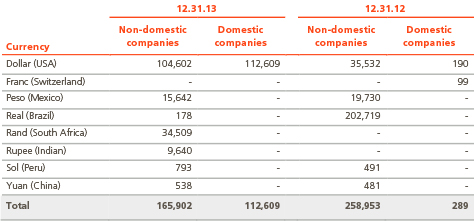
- b) The following table shows a list of credit facilities with financial entities:

With the aim of minimizing the volatility in interest rates of financial operations, specific contracts are signed to hedge the possible variations that may occur (See Note 14).
The long-term syndicated financing loan was signed for the purposes of financing investments and general financing requirements of Abengoa, S.A. and all the companies of the group without non-recourse financing.
On April 27, 2012, the Company signed the refinancing and syndication of €1,566,210 thousand of its long term corporate debt. The refinancing was led by a group of national and international entities, which acted as arrangers and bookrunners for the transaction. On May 22, 2012 and according to the option included in the contract, the principal amount was increased by €47,000 thousand and on July 11, 2012 it was additionally increased by €50,000 thousand, so the refinancing amounted to 1,663,210 thousand. The refinancing was supported by 37 international financial institutions.As of December 31, 2013, borrowings under the 2013 Forward Start Facility amounted to €1,416,710 thousand.
On December 23, 2013 there was a repayment of the Forward Start Facility 2012 against the maturity of July 2014 for an amount of €246,500 thousand.
Interest rate applicable is Euribor plus a margin of 3.75% until January 20, 2013, 4.00% until January 2015 and 4.25% until July 20, 2016.
In addition, the bilateral loans with the Official Credit Institute (ICO) and the European Investment Bank (EIB) are aimed at financing specific investment programs, more notably overseas programs, as well as R&D&i programs.
Furthermore, some subsidiaries of Abengoa S.A. undersigned long-term loans with various entities, including two financing agreements signed with a group of financing entities backed by an EKN (Swedish Export Credit Agency) guarantee to finance industrial machinery in various projects:
To ensure that the Company has sufficient funds to repay the debt with respect to its capacity to generate cash flow, Abengoa has to comply with a Corporate Net Debt/EBITDA financial ratio with the financial institutions.
According to the financing agreements, the maximum limit of this ratio is 3.0 for the years 2012, 2013 and until December 30, 2014 and 2.5 starting December 31, 2014. As of December 31, 2013 and 2012, Corporate Net Debt/EBITDA financial ratio was 1.69 and 1.80 respectively, according to the conditions of the financing agreements.
- c) As of December 31, 2013 the debt repayment calendar was as set out in the following table:

The exposure of the Group to movements in interest rates and the dates at which prices are revised is specified in Note 4 on the management of financial risks. Corporate financing is mainly based in variable interest rates, as such its fair value is close to its book value. The fair value is based on discounted cash flows, applying a discount rate being that of the third-party loan.
- d) The balance of interest payable is €39,664 thousand as of 2013 (€17,890 thousand in 2012) and is included under ‘Short-term borrowings’.
- e) Real estate pledged against mortgages corporate financing as of December 31, 2013 is not significant.
- f) The average interest rates associated with the debt facilities reflect normal levels in each of the regions and areas in which the facility was agreed upon.
- g) The average cost of total financing during 2013 was 7.1%.
20.3. Notes and bonds
The table below shows the maturities of the existing notes as of December 31, 2013:

(*) With possibility of renewal
Convertible notes 2014
On July 24, 2009, Abengoa, S.A. issued Convertible Notes, convertible into ordinary shares, to qualified investors and institutions in Europe for the amount of €200 million. On January 17, 2013, Abengoa, S.A. repurchased a nominal amount of €99.9 for a purchase price of €108.8 million. The terms and conditions of the issuance are currently as follows:
- a) The nominal amount of the notes is one hundred million and one hundred thousand Euros (€100.1 million) with maturity set at five (5) years.
- b) The Notes accrue a fixed annual interest of 6.875% payable semiannually.
- c) The 2014 Convertible Notes are convertible into fully paid class A shares or class B shares of Abengoa, subject to certain liquidity conditions, credited in the number determined by dividing the aggregate nominal amount of the Notes by the applicable conversion price. The conversion price was initially set at €21.12 per ordinary share of Abengoa and was adjusted to €20.84 per share in July 2012 following a dividend payment (€0.35 per share) in excess of the dividend threshold permitted without adjustment in the conversion price (€0.21 per share). In October 2012, the conversion price was adjusted to €4.17 per share of Abengoa due to the distribution of class B shares as approved by the Extraordinary General Shareholders’ Meeting held on September 30, 2012. Additionally, the conversion price has been adjusted to €3.81 per share of Abengoa as a result of the Capital Increase completed on October 29, 2013.
- d) Pursuant to the Terms and Conditions, in the event that investors decide to exercise their right of conversion, the Company may decide to settle the issuance entirely in shares, in cash or in a combination of shares and cash.
As described in Note 2.19.1 in Significant accounting policies, in accordance with IAS 32 and 39 and the Terms and Conditions of the issuance, since Abengoa has a contractual right to choose the type of settlement and one of these possibilities is paying through a variable number of shares and cash, the conversion option qualifies as an embedded derivative. Thus, the convertible bonds are considered a hybrid instrument, which includes a component of debt and an embedded derivative for the conversion option held by the bondholder. This happens with 2014, 2017 and 2019 convertible bonds.
The carrying value amount of the liability component of this note at December 31, 2013 amounted to 96,183 thousand (€178,720 thousand at December 31, 2012, corresponding to a nominal amount of €200 million).
At December 31, 2013, the fair value of the derivative liability embedded in the convertible bond is €984 thousand, while its fair value as of December 31, 2012 amounted to €21,313 thousand. The decrease in fair value has been recorded as an income amounting to €9,672 thousand in ‘Other net finance income/expense’ in the Consolidated Income Statement for the year ended December 31, 2013 (10,656 thousand in 2012), see Note 30.3.
Additionally, a net loss of €4,815 thousand was recorded due to the partial repayment of the convertible notes due 2013, the repayment resulted in an income of €7,212 thousand due to the fair value measurement of the cancelled embedded derivative component and a loss of €12,027 thousand due to the difference between the amount paid and the cancelled components of the liability.
The key data for the valuation model were the share price, the estimated profitability of the dividend, an envisaged option maturity life, an interest rate and underlying volatility as set out in the table below:

Furthermore, in order to partially hedge the derivatives embedded in the notes convertible, during the years 2011 and 2010 the Company purchased two call options over 7,000,000 Abengoa’s own shares with a strike price of €21.125 per share, maturing on July 24, 2014 (over 35,000,000 Abengoa’s shares with a strike price of €4.22 after the distribution of class B. shares approved by the Extraordinary General Meeting held on September 30, 2012).
These options hedge around 67% of the notes in the event of conversion.
The fair value of the options at December 31, 2012, calculated using the Black-Scholes model, was €4,714 thousand, while the fair value was €419 thousand at December 31, 2013. The decrease in fair value has been recorded as a finance expense amounting to €4,295 thousand recorded in ‘Other net finance income/expense’ in the Consolidated Income Statement (an expense of €15,320 thousand in 2012), see Note 30.3. As of December 31, 2013 the listed price of these bonds was 102.006%.
The key data for the valuation model included the share price, the estimated profitability of the dividend, the envisaged life of maturity, an interest rate and underlying volatility as set forth in the table below:

Convertible notes 2017
On February 3, 2010, Abengoa, S.A. issued Convertible Notes, convertible into ordinary shares, to qualified investors and institutions for the amount of €250 million. The terms and conditions of the issuance are currently as follows:
- a) The Notes were issued for two hundred million Euros (€250 million) with maturity set at seven (7) years.
- b) The Notes accrue a fixed annual interest of 4.5% payable semiannually.
- c) The 2017 Convertible Notes are convertible into fully paid class A shares or class B shares of Abengoa, subject to certain liquidity conditions, credited in the number determined by dividing the aggregate nominal amount of the Notes by the applicable conversion price. The conversion price was initially set at €30.27 per ordinary share of Abengoa and was adjusted to €29.87 per share in July 2012 following a dividend payment (€0.35 per share) in excess of the dividend threshold permitted without adjustment in the conversion price (€0.21 per share). In October 2012, the conversion price was adjusted to €5.97 per share of Abengoa due to the distribution of class B shares as approved by the Extraordinary General Shareholders’ Meeting held on September 30, 2012. Additionally, the conversion price has been adjusted to €5.45 per share of Abengoa as a result of the Capital Increase completed on October 29, 2013.
- d) Pursuant to the Terms and Conditions, in the event that investors decide to exercise their right of conversion, the Company may decide to settle the issuance entirely in shares, in cash or in a combination of shares and cash.
The carrying value amount of the liability component of this bond at December 31, 2013 amounted to 203,422 thousand (€191,516 thousand at December 31, 2012).
Additionally, at December 31, 2013, the fair value of the derivative liability embedded in the convertible bond is €2,887 thousand, while its fair value as of December 31, 2012 amounted to €39,306 thousand. The decrease in fair value has been recorded as an income amounting to €36,419 thousand in ‘Other net finance income/expense’ in the Consolidated Income Statement for the year ended December 31, 2012 (€16,885 thousand in 2012), see Note 30.3.
The key data for the valuation model included the share price, the estimated profitability of the dividend, an envisaged option maturity life, an interest rate and underlying volatility as set forth in the table below:

Furthermore, in order to partially hedge the derivatives embedded in the notes convertible, during the years 2011 and 2010 the Company purchased two call options over 7,100,000 Abengoa’s own shares with a strike price of €30.27 per share, maturing on February 3, 2017 (over 35,500,000 Abengoa’s own shares with a strike price of €6.05 after the distribution of class B shares approved by the Extraordinary General Meeting held on September 30, 2012).
These options hedge around 76% of the notes in the event of conversion.
The fair value of the options at December 31, 2012, calculated using the Black-Scholes model, was €4,065 thousand, while the fair value was €2,322 thousand at December 31, 2013. The decrease in fair value has been recorded as a finance expense amounting to €1,743 thousand recorded in ‘Other net finance income/expense’ in the Consolidated Income Statement (€17,139 thousand in 2012), see Note 30.3. As of December 31, 2013 the listed price of these bonds was 100.453%.
The key data for the valuation model included the share price, the estimated profitability of the dividend an envisaged option maturity life, an interest rate and underlying volatility as set forth in the table below:
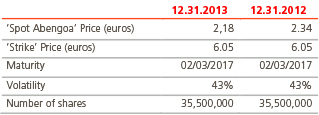
On February 3, 2015, holders of the 2017 Convertible Notes will have the right to require Abengoa to redeem the 2017 Convertible Notes at the principal amount together with accrued and unpaid interest to such date.
Convertible notes 2019
On January 17, 2013, Abengoa, S.A. issued €400 million aggregate principal amount among qualified and institutional investors of 6.25% convertible notes due 2019 (the ‘2019 Convertible Notes’). The notes are convertible into class B shares. In summary, the final terms and conditions of the issuance are as follows:
- a) The Notes were issued for four hundred million Euros (€400 million) with maturity set at six (6) years.
- b) The Notes accrue a fixed annual interest of 6.25% payable semiannually.
- c) The Notes are convertible, at the option of noteholders into fully paid class B shares.
- d) In the event that investors decide to exercise their right of conversion, the Company may decide to repay the notes in shares, cash or a combination of cash and shares.
- e) The 2019 Convertible Notes are convertible into class B shares of the Parent Guarantor credited in the number determined by dividing the aggregate nominal amount of the Notes by the applicable conversion price. The initial conversion price is three Euros and twenty-seven cents of a Euro (€3.27) for each class B share of the Company. The conversion price has been adjusted to €3.04 per share of Abengoa as a result of the Capital Increase completed on October 29, 2013.
The carrying value of the liability component of the notes at December 31, 2013 amounts to €309,249 thousand.
At December 31, 2013, the fair value of the derivative liability embedded in the convertible note is €62,894 thousand, while its initial valuation generated in the issuance of the convertible notes amounted to €91,244 thousand. The decrease in fair value has been recorded as income amounting to €28,350 thousand in ‘Other finance income’ in the Consolidated Income Statement for the year ended December 31, 2013. As of December 31, 2013 the listed price of these bonds was 101.509%.
The key data for the valuation model included the share price, the estimated profitability of the dividend an envisaged option maturity life, an interest rate and underlying volatility as set forth in the table below:
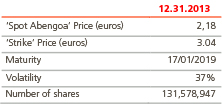
Ordinary notes Abengoa 2015
On December 1, 2009, Abengoa S.A. issued ordinary Notes for the amount of €300 million. In summary, the final terms and conditions of the issuance are as follows:
- a) The Notes were issued for three hundred million Euros (€300 million) with maturity set at five (5) years.
- b) These Notes will accrue a fixed annual interest of 9.625% payable semiannually.
- c) These Notes are jointly guaranteed by some subsidiaries of the group.
- d) As of December 31, 2013 the listed price of these bonds was 107.125%.
Ordinary notes Abengoa 2016
On March 31, 2010, Abengoa S.A. issued ordinary Notes to qualified investors and institutions in Europe for the amount of €500 million. In summary, the final terms and conditions of the issuance are as follows:
- a) The Notes were issued for five hundred million Euros (€500 million) with maturity set at six (6) years.
- b) The fixed annual payable twice-yearly interest on the Notes is 8.50% annually.
- c) The notes are guaranteed jointly by certain subsidiaries of the group.
- d) As of December 31, 2013 the listed price of these bonds was 108.375%.
Ordinary notes Abengoa 2017
On October 19, 2010, Abengoa Finance, S.A.U., a subsidiary of Abengoa, S.A., issued an ordinary bonds for USD 650 million among qualified and institutional investors in accordance with Rule 144A of the Securities Act of 1933 and subsequent amendments thereto. In summary, the terms and conditions of the issue that were established definitively are:
- a) The bond issue is for an amount of six hundred and fifty million United States dollars (USD 650 million) and matures at seven (7) years.
- b) The notes will accrue fixed annual interest of 8.875%, payable every six months.
- c) The notes are jointly and severally guaranteed by Abengoa, S.A. and certain group subsidiaries.
As of December 31, 2013 the listed price of these bonds was 107.938%.
Ordinary notes Abengoa 2018
On February 5, 2013, Abengoa Finance, S.A.U., a subsidiary of Abengoa, S.A., issued Ordinary Notes to qualified and institutional investors for €250 million. On October 3, 2013, Abengoa Finance, S.A.U. issued €250 million of additional and fungible notes, at a price of 100.25%, which is equivalent to a yield of 8.799%. Furthermore, on November 5, 2013, Abengoa Finance, S.A.U. issued €50 million of additional and fungible notes, at a price of 105.25%, which is equivalent to a yield of 7.408%. The terms and conditions of the issuance are as follows:
- a) The aggregate nominal amount of the Notes is five hundred and fifty million Euros (€550 million) with maturity set in February 5, 2018.
- b) The Notes accrue a fixed annual interest of 8.875% payable semiannually.
- c) The notes are guaranteed jointly by certain subsidiaries of the group.
- d) As of December 31, 2013 the listed price of these bonds was 108.125%.
Ordinary notes Abengoa 2020
On December 13, 2013, Abengoa Finance, S.A. Unipersonal, a subsidiary of Abengoa, S.A., issued an ordinary bond for USD 450 million among qualified and institutional investors. In summary, the terms and conditions of the issuance are:
- a) The bond was issued for an amount of USD 450 million and matures in 6 years.
- b) The notes accrue fixed annual interest of 7.75%, payable every six months.
- c) The notes are jointly and severally guaranteed by Abengoa, S.A. and certain group subsidiaries.
As of December 31, 2013 the listed price of these bonds was 103.520%.
Euro-Commercial Paper Programme
On January 29, 2013, Abengoa, S.A. carried out a Euro Commercial Paper (ECP) program for a maximum of 500 million euros, listed in the Irish Stock Exchange with one-year maturity. Through this program, the company was able to issue notes between one and twelve months maturity, diversifying its financing options in the capital markets.
On December 20, 2013, the program was renewed for one more year and for the same amount. At the end of 2013, the program had a balance of 104,912 thousand euros.
20.4. Finance lease liabilities
Finance lease creditors as of the end of 2013 and 2012 were:
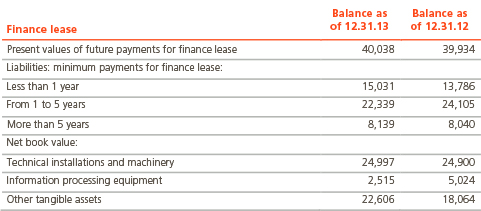
20.5. Other loans and borrowings
The following table sets out the movement of Other loans and borrowings at the 2013 and 2012 year end:

Note 21.- Grants and other liabilities
Grants and Other Liabilities as of December 31, 2013 and 2012 are shown in the following table:

The increase in Long-term trade payables was primarily due to the investment from Liberty Interactive Corporation (‘Liberty’) made on October 2, 2013 for an amount of USD 300 million. The investment was made in shares of class A shares of Arizona Solar Holding, the holding of Solana thermo-solar plant in the United States. Such investment was made in a tax equity partnership which permits the partners to have certain tax benefits such as accelerated depreciation and Investment Tax Credits (ITC).
According to the stipulations of IAS 32 and in spite of the fact that the investment of Liberty is in shares, it does not qualify as equity and has been classified as a Liability as of December 31, 2013, the non-current portion of the liability is recorded in Grants and other liabilities for an amount of €171 million and its current portion is recorded in other current liabilities for an amount of €47 million. This liability has been initially valued at fair value, calculated as the present value of expected cash-flows during the useful life of the concession, and will be measured at amortized cost according with the effective interest method.
The control and management of the thermo-solar plant is a responsibility of Abengoa and the plant is fully consolidated in these consolidated financial statements.
In addition, the increase in Grants was mainly due to grants arising from loans at rates below market rates. Loans with the Federal Financing Bank guaranteed by the Department of Energy related to the Solana thermosolar project bear interest at a rate below market rates for these types of project and term. The difference between proceeds received from these loans and its fair value is recorded as a grant.
Note 22.- Provisions and contingencies
22.1. Provisions for other liabilities and charge
The following table shows the movement of the non-current heading of ‘Provisions for other liabilities and charges’ for the years 2013 and 2012:
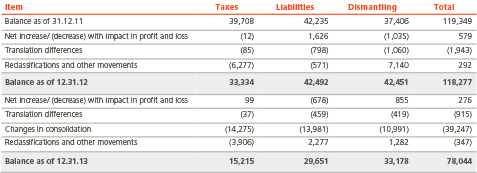
The decrease of total provisions in 2013 is mainly due to the exclusión of Befesa from the consolidation scope following the sale of its shareholding.
The decrease of total provisions in 2012 is mainly due to translation differences arising from the depreciation of the Algerian dinar with respect to the Euro.
Provision for tax and legal contingencies
This provision represents the Group’s best estimates in connection with risks relating to tax contingencies arising during the normal course of the Group's business, fundamentally in Latin America, when it is considered probable that there will be an outflow of resources in the medium or long term (which has been estimated being comprised in a period between 2 to 5 years or over 5 years), although the development of the contingencies and the new facts and circumstances that may arise overtime could change such estimated settlement period.
There are also provisions recorded by Group companies in relation with court rulings and unfavorable tax inspections that are under appeal but have not been resolved yet. For these tax disputes the Group considers that it is probable that there will be an outflow of resources in the medium term (between 2 and 5 years).
Provision for liabilities
This provision includes the Group’s best estimates of probable cash outflows in connection with litigation, arbitration and claims in progress in which the various group companies are defendants as a result of the activities they carry out. Management considers that these liabilities will likely be settled in the medium or long term (which has been estimated being comprised in a period between 2 to 5 years).
Dismantling provision
This provision is intended to cover future expenditures related to the dismantlement of the solar plants and it will be likely to be settled with an outflow of resources in the long term (over 5 years).
22.2. Contingent liabilities
As of December 31, 2013 Abengoa and its Group of companies are involved in certain claims and litigations both against and in their favor. Such matters arise during the Group’s normal course of business and represent the technical and economic claims that the contractual parties typically invoke.
We have briefly summarized below the most significant proceedings, which in the Management opinion are not expected to have a material adverse effect in the Consolidated Financial Statements, individually or as a whole, or for which the future outcome cannot be reliably estimated.
- In May 2000, Abengoa Puerto Rico S.E., a subsidiary of Abengoa S.A, brought a lawsuit against the Electricity Power Authority (Autoridad de Energía Eléctrica, ‘AEE’) of Puerto Rico and terminated the agreement that both parties had entered into in relation to an EPC project for the construction of an electricity power station in Puerto Rico, in which the AEE was the Principal Contractor. The referred lawsuit contained different claims such as, inter alia, withholding payments, defaulted invoices, loss of future profits damages and several other costs, which tentatively amounted to USD 40 million.
In response to the lawsuit brought by Abengoa Puerto Rico, S.E., the AEE brought a counterclaim premised upon unlawful termination and consequential damages relating to the agreement with Abengoa Puerto Rico, S.E. and, at the same time, brought an additional lawsuit for the same amount against Abengoa and its insurer, American International Insurance Co. of Puerto Rico. The amount claimed by the AEE is approximately USD 450 million. - On April 29, 2013, the European Commission decided to initiate an inspection on the Parent Guarantor, along with all the companies directly or indirectly under its control, including Abengoa Bioenergy Trading Europe B.V., regarding its possible participation in anticompetitive agreements or actions which were allegedly aimed at manipulating the results of Platt’s Market on Close (MOC) price assessment as well as denying the access of one or more companies to participation in the MOC price assessment process. According to such European Commission’s decision, the suspected anticompetitive conduct, agreements and/or mutually coordinated concrete actions have allegedly existed since 2002 and would likely involve various markets for which the Platts MOC process is used to report prices, including markets for biofuels.In the Directors opinion the investigation is still in a preliminary phase, and the European Commission has not initiated formal proceedings. Directors believe that it and the relevant companies within the Group (including Abengoa Bioenergy Trading Europe B.V.) have at all times complied with the applicable competition laws. We are actively cooperating with the European Commission in its investigation.
22.3. Contingent assets
As of December 31, 2013 Abengoa and its Group of companies do not have significant contingent assets.
Note 23.- Third-party guarantees and commitments
23.1. Third-party guarantees
At the close of 2013 the overall sum of Bank Bond and Surety Insurance directly deposited by the group companies and all that the parent company deposited to any company in the group as guarantee to third parties (clients, financial entities, Public Entities and other third parties) amounted to €1,323,267 thousand (€1,541,255 thousand in 2012) out of which € 2,229 thousand (€6,464 thousand in 2012) are attributed to operations of financial nature and € 1,321,038 thousand (€1,534,791 thousand in 2012) to those of technical nature.
In addition, the declarations of intent and commitments undertaken by the Group companies and what the parent company undertook to any company in the group as guarantee to third parties (clients, financial entities, Public Entities and other third parties) amounted to € 6,187,269 thousand (€4,428,780 thousand in 2012) out of which € 32,480 thousand (€148,508 thousand in 2012) are attributed to operations of financial nature and € 6,154,789 thousand (€4,280,272 thousand in 2012) to those of technical nature.
23.2. Contractual obligations
The following table shows the breakdown of the third-party commitments and contractual obligations as of December 31, 2013 and 2012 (in thousands of Euros):
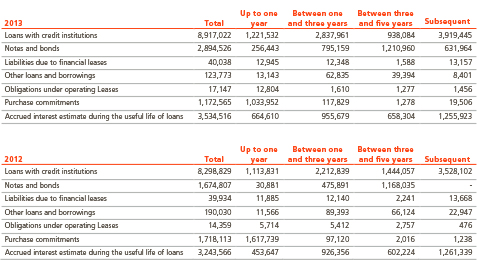
Note 24.- Tax situation
24.1. Application of rules and tax groups in 2013
Abengoa, S.A. and 242 and 256 consolidated subsidiaries in 2013 and 2012, respectively (see Appendixes XI and XVI of these Consolidated Financial Statements) have filed its 2013 income taxes following the rules for tax consolidation in Spain under the ‘Special Regime for Tax Consolidation’ Number 2/97.
All the other Spanish and foreign companies included in the Consolidation group file income taxes according to the tax regulations in force in each country on an individual basis or under consolidation tax regulations.
In order to calculate the taxable income of the consolidated tax Group and the consolidated entities individually, the accounting profit is adjusted for temporary and permanent differences, recording the corresponding deferred tax assets and liabilities. At each Consolidated Income Statement date, a current tax asset or liability is recorded, representing income taxes currently refundable or payable. Deferred income taxes reflect the net tax effects of temporary differences between the carrying amount of assets and liabilities for financial statement and income tax purposes, as determined under enacted tax laws and rates.
Income tax payable is the result of applying the applicable tax rate in force to each tax-paying entity, in accordance with the tax laws in force in the territory and/or country in which the entity is registered. Additionally, tax deductions and credits are available to certain entities, primarily relating to inter-company trades and tax treaties between various countries to prevent double taxation.
24.2. Deferred tax assets and liabilities
At the end of 2013 and 2012 the analysis of deferred tax assets and deferred tax liabilities is as follows:
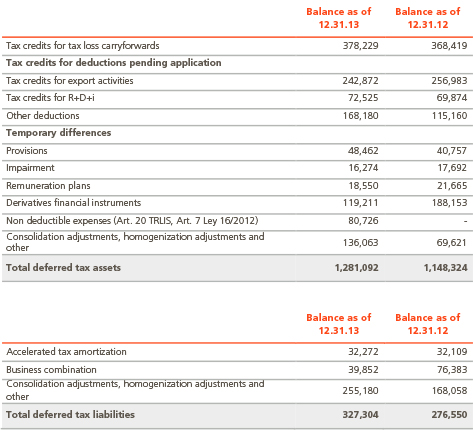
Most of the tax credits for net operating loss carryforwards correspond to Brazil (€169 million), the United States (€55 million), Spain (€66 million) and the Netherlands (€57 million).
Tax loss carryforwards in Brazil have been generated in years with poor meteorological conditions which have negatively affected sugarcane production. From 2011 to 2013 investments have been made to improve the quality of biological assets, to increase milling capacity and cogeneration plant capacity, with the ultimate purpose of increasing assets profitability. Tax loss carryforwards in the United States correspond mainly to projects in an initial stage of development or operation and to application of tax incentives. Tax loss carryforwards in Spain correspond mainly to the application of tax incentives.
Tax credits for deductions have been generated mainly in Spain. Among these tax credits the larger amount corresponds to deduction on export activities (DAEX), which is calculated as a percentage over investments effectively made for the acquisition of foreign companies or capital increases in foreign companies. This percentage, which was initially 25% was been gradually reduced since 2007 to reach 3% in 2010, disappearing the deduction on 2011. To benefit from this deduction, among other requirements, the acquisition or incorporation of companies should be directly related to the export of goods and services from Spain.
From the year 2012, the Company has not recorded any income in relation to this deduction, as it had been recorded entirely as of December 31, 2011.
In addition, efforts in research, development and innovation activities (R&D&i) that Abengoa has been carrying out during the last years have resulted in the generation of important tax deductions, some of which are recorded as deferred tax assets for an amount of €72 million as of December 31, 2013.
‘Other deductions’, which have been generated mainly in Spain, correspond primarily to deductions for double taxation (€12 million), environmental deductions (€85 million), deduction for reinvestment of extraordinary benefits (€ 51 million) and deductions for donations to non-profit organizations (€19 million).
In relation to tax loss carryforwards and deductions pending to be used recorded as deferred tax assets, the Company evaluates its recoverability projecting forecasted taxable income for the upcoming years and taking into account the Company tax planning strategy. Deferred tax liabilities reversals are also considered in these projections, as well as any limitation established by tax regulations in force in each tax jurisdiction.
On the other hand, the Company has certain tax credits as of December 31, 2013 which it has not capitalized, as it determined that recoverability of such assets is not probable. These tax credits consist mainly of tax loss carryforwards related to our US subsidiaries amounting to €35.1 million (€28.2 million in 2012), with expiration dates between 2029 and 2032; and R&D&i and environmental tax credits in Spain amounting to €74.7 million (€50.3 million in 2012), with expiration dates between 2022 and 2031.
The movements in deferred tax assets and liabilities during 2013 and 2012 were as follows:
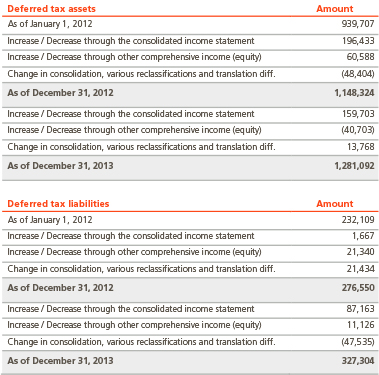
Note 25.- Trade payables and other current liabilities
25.1. Trade payable and other current liabilities as of the close of 2013 and 2012 are shown in the following table:
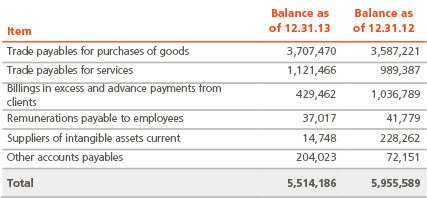
25.2. Nominal values of Trade payables and other current liabilities are considered to approximate fair values and the effect of discounting them is not significant.
25.3. The table above includes amounts payable to companies in the Group through “Confirming without recourse” for an amount of €469 million at December 31, 2013 (€648 million in 2012) relating to various agreements entered into with a number of financial entities in which the Group receives ‘confirming’ services in connection with cash advances from trade receivables. There are deposits and cash and cash equivalents of the Consolidated Statement of Financial Position linked to the payment of such ‘confirming without recourse’ for an amount of € 369 million (€459 million in 2012).
25.4. Details on supplier maturities are provided in the following table:
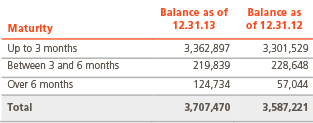
25.5. Pursuant to the Decision dated December 29, 2010, of the Instituto de Contabilidad y Auditoría de Cuentas (Spanish Accounting Board), on the information to incorporate into the Financial Statements report in relation to the delays in payments to suppliers in commercial transactions, companies located in Spain that issue individual and consolidated statements must expressly make public the information on payment term to suppliers in the notes to their Financial Statements.
The obligation to provide information affects commercial payment transactions. That is, to the trade creditors included under the heading of current liability of the balance sheets, therefore, the regulations excludes creditors or suppliers that do not meet such condition as suppliers of fixed assets or finance lease creditors.
The information in the consolidated financial statements refers to suppliers of the Group as a single reporting entity, after reciprocal credits and debits of subsidiaries and, if applicable, those of multi-group companies have been eliminated in accordance with the provisions of the applicable consolidation rules, together with those of suppliers related with the construction of own assets.
Thus, at the end of 2013, the outstanding balance with suppliers located in Spain with payment terms greater than the legal period, in accordance with the procedure established by said Decision, amounts to €82,269 thousand (€115,366 thousand in 2012).
According to the foregoing, and considering the fact that in general, the system of payment used by Abengoa is the financial figure of confirmed payment through financial institutions without recourse to supplier (PPB or confirming), under contracts signed with various financial entities, at the end of 2013 and 2012, the outstanding balances to suppliers did not accumulate a payment delay significantly longer than the legal payment term.
In addition, the payments to suppliers of companies within Spain during 2013 exceed the legal limit by 74 days (75 days in 2012) and amounts to €477 million, 30 % of the total of payments (€528 million, 30% of the total payments in 2012), although, considering that most of the payments are made to international suppliers under the framework of strategic agreements signed, it may be said that the total payments and days exceeded did not exceed the legal terms.
The Directors of the parent company do not expect that additional liabilities may arise as a result of balances of outstanding suppliers exceeding payment terms established in Law 15/2010 referred to in this note.
Note 26.- Construction contracts
Further to the information set out in Note 2.24.b) relating to the accounting treatment of construction contracts, the table below includes aggregated information on outstanding construction contracts to which IAS 11 was applied at the end of the years 2013 and 2012:
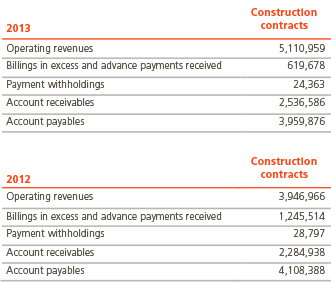
The amount of unbilled revenue by the end of the years 2013 and 2012 is €488,883 and €393,200 thousand, respectively.
The aggregated total amount of the costs incurred and the aggregated total profits (less the related losses) recognized since origin for all the ongoing contracts at December 31, 2013 amount to €11,869,900 thousand and €995,928 thousand respectively (€10,498,336 thousand and €829,611 thousand in 2012).
Note 27.- Revenues
The breakdown of Revenues for the years 2013 and 2012 is as follows:

Note 28.- Other operating income and expenses
The table below shows the detail of Other Operating Income and Expenses for the years 2013 and 2012:

Work performed by the entity and capitalized and other corresponds to income from capitalized costs, including mainly the capitalization of costs associated with the construction of our own assets (except for concession assets for which IFRIC 12 is applied). The corresponding costs are recognized in the individual expense line item in the accompanying income statements. The recognition of an income for the sum of such costs through the line item ‘work performed by the entity and capitalized costs and other’ results in these costs having no impact in net operating profit. The corresponding assets are capitalized and included in property, plant and equipment in the accompanying balance sheets.
Additionally, other income in 2013 primarily includes an income of €141.8 million corresponding to a favorable jury verdict in a litigation process against Adriano Gianetti Dedini Ometto and Adriano Ometto Agrícola, Ltda. (see Note 15.10) and other nminor income. In 2012 primary corresponds to the gain amounting to €85 million arising from the business combination of Rioglass Group, where we achieved control by increasing our ownership in stages well as an income of €26 million recorded by Abengoa Bioenergy U.S. Holding in the last quarter of 2012, corresponding to a collection from Chicago Title Insurance Company after a favorable jury verdict in a litigation process against that company. Finally, this heading includes income arising from the fair value adjustment of our biological assets in Brazil, to sales of property plant and equipment and to other minor income.
Grants include government grants related to R&D activities and to lonas at a rate below interest rates which are considered as subsidized loans (see Note 2.17).
Income from various services in 2013 primarily includes profits generated by the sale of the Brazilian subsidiary, Bargoa, S.A. amounting to €33.2 million and other income by minor services. In 2012 primarily includes profits generated by the sale of the second 50% of the shareholding of STE, ATE, ATE II and ATE III amounting to €4.5 million and other income by minor services.
‘Leases and fees’ mainly includes leases of buildings, offices, machinery and construction equipment required in the ordinary course of operating activities of companies.
Under ‘Other minor management expenses’ are mainly recorded trips and per diem expenses.
Note 29.- Employee benefit expenses
The breakdown of Employee Benefit Expense for 2013 and 2012 is as follows:

a) Share plan
On February 2, 2006, Abengoa granted a Share Acquisition Plan, or Plan, which was approved by the Board of Directors of Abengoa on January 23, 2006. The Plan was on the same terms to all participants, members of the senior management of Abengoa and its subsidiaries. Under the Plan, participants were entitled to purchase up to 3,200,000 shares of Abengoa. Subsequently, the number of shares was adjusted due to the increase in class B share capital charged to our freely available reserves, approved by the Extraordinary General Meeting held on September 30, 2012 (see Note 18). As described below, this plan was terminated on December 31, 2012.
The material terms of the Plan were as follows:
- Participants: 122 members of the senior management of the Abengoa Group (business group managers, business unit managers, technical and research and development officers and corporate services officers) from all its subsidiaries and business areas were eligible to participate in the Plan if they desire to do so. The Plan was not open to any member of Abengoa’s Board of Directors. At the end of 2012, besides the participants excluded from the Plan, there were 98 participants.
- Shares Available for Purchase: Up to 3,200,000 Abengoa shares (the ‘shares’). The shares purchased by Plan participants were already issued and in circulation and were purchased on the open market, at the then current market price, over a period that extended to December 31, 2006, in accordance with the Stock Exchange Act (Spain). A total of 3,166,000 were purchased under the Plan. As such, these shares were not dilutive instruments for earnings per share calculation purposes. At year ended 2012, the number of shares covered by the plan amounted to 12,251,425 shares, adjusted due to capital increase by distribution of class B shares mentioned above.
- Financing: As a feature of the Plan, each participant utilized the proceeds of an individual bank loan from Banco Sabadell, S.A. or Caja Madrid (collectively the ‘Bank’) to finance the purchase of shares of Abengoa under the Plan. The same standard loan terms applied to all participants. The interest rate on the loans was a variable rate equal to EURIBOR plus 0.75%. These were bullet and not amortizing loans. The loans must be repaid by the participants by August 7, 2011. Each loan was secured by a pledge of 100% of the participant’s shares and was guaranteed by the Company to the extent set forth under paragraph 8 below. Except for the pledge of the shares, the loan was not considered a non-recourse financing to the participant. The maximum amount of indebtedness related to all such loans was €87 million (including expenses, commissions and interests). As of December 31, 2012, the amounts drawn by total participants under these loans amounted to €61 million.
- Share Purchase: The acquisition cost for all participants has been the average acquisition price, plus associated commissions and other costs, for all of the shares purchased under the Plan for all participants.
- Term and Vesting Period: The duration and vesting period of the Plan was five complete financial years (2006-2010) plus six months (until June 30, 2011) (the requisite service period). The Plan required the annual accomplishment by the participant of annual management objectives, including specific financial targets and qualitative objectives, set by the management of the Abengoa Group company by which the participant was employed, as well as their continuation as a Group employee through June 30, 2011. If the annual objectives were not met by the participant, the Bank from which the participant borrowed the funds to purchase his/her shares may sell a percentage of the shares purchased for such participant as follows: 2006-30%, 2007-30%, 2008-15%, 2009-15%, 2010-10%.
- As of December 31, 2010, the participants had consolidated the annual objectives required by the Plan.
- Restrictions on Sales: A participant may not transfer, sell, borrow against or otherwise dispose of the shares purchased before July 1, 2011.
- Repurchase Option: Under the Plan, Abengoa had a repurchase option under which Abengoa could require a participant to sell the shares back to the Company on the occurrence of certain events, such as death, disability or retirement of the participant or termination of the employment of the participant with the Abengoa Group Company.
- Shortfall on Sale of Shares: At the end of the five years and six months term of the Plan, if the amount realized on a sale of the shares did not entirely cover the amount owed under the loan and costs and taxes on capital gains, Abengoa would compensate the participant with the necessary amount to repay the loan plus accrued and unpaid interest and pay such taxes.
- In 2011 agreements were closed with participating financial entities and the directors of said Plan for its extension for an additional period of two years, until December 31, 2012.
The above terms are incorporated in the form of agreement that each participant in the Plan enters into with Abengoa. In order to compensate the Plan participants under the terms of the share acquisition plan for the negative difference between the fair market value of the shares at the time of expiration of the Plan and the amounts owed by the participants under the bank loans initially received to finance their acquisition of the shares, on June 10, 2013 we repurchased from the participants 2,450,285 Class A shares and 9,801,140 Class B shares and cancelled on their behalf the obligations outstanding under the banks loans. Therefore, there is no share plan as of December 31, 2013.
Compensation expense was recognized over the requisite service period (the vesting period), and was determined by reference to the fair value of a hypothetical put option granted by the company to the participant, excluding the effect of vesting conditions that are not market conditions. For these purposes, the calculation took into account the number of shares that were expected to become exercisable (or vested), which was updated at each year end, recognizing the impact of the revision of the original estimates, if applicable, in the Consolidated Income Statement.
The fair value of the hypothetical options granted during the year 2012, calculated using the Black-Scholes model was €36,245 thousand, recording a loss during the year 2012 of €9,473 thousand. The key data required for the valuation model were share price, the estimated return per dividend, an expected option life of 5 years, an annual interest rate and share market volatility that are included in the table below:
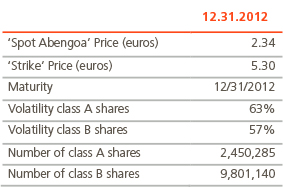
b) Bonus schemes
On July 24, 2006 and December 11, 2006, the Board of Directors approved an Extraordinary Variable Compensation Plan for Managers (Plan II) at the proposal of the Remuneration Committee. This plan initially included 190 beneficiaries and had a total cost of €51,630 thousand over a five-year period from 2007 to 2011, inclusive. It required that objectives set forth in the Strategic Plan be attained at an individual level as well as the individual’s continued ongoing service throughout the period in question.
In addition to the aforementioned, given that the acquisition of the company B.U.S. Group AB was completed only shortly after implementation of the Plan, on October 22, 2007 the Board of Directors approved the inclusion of the management team of such company, formed by 10 people, in the Plan under the same conditions as those established for the rest of the beneficiaries, for a total amount of €2,520 thousand. At the close of 2012 financial year, there were 155 participants, and the total cost of the plan was €35,237 thousand.
On October 24, 2011, the Board of Directors approved the extension of the Plan II for a period of one additional year. This Plan was liquidated in 2013
On January 24, 2011, the Board of Directors approved an Extraordinary Variable Compensation Plan for Managers (Plan III), proposed by the Remuneration Committee. The plan, which includes 104 beneficiaries (the participants), has a duration of five years (from 2011 to 2015) and is based on achieving the objectives defined in the Strategic Plan, at an individual level. The plan also requires the individual’s continued ongoing service for the entire period considered. The total amount available under the plan for the 104 participants is €56,500 thousand. The company recognizes the corresponding personnel expense in the Consolidated Income Statements for the amounts accrued based on the percentage of consolidation of the objectives. In December 2013 this plan was replaced by a new one (Plan IV), which cancelled and superseded the previous plan (Plan III). The new plan has a duration of five years (from 2013 to 2017), continuing the previously established conditions. At the end of 2013, there were 347 participants and the total amount of the plan was 84,991 thousand euros.
The cost recognized through the variable remuneration plans in 2013 was € 8,582 thousand, the accumulated cost being € 22,528 thousand. The cost of Plan corresponding to senior Management of the Company recognized in 2013 amounts to € 2,766 thousand.
Note 30.- Finance income and expenses
30.1. Finance income and expenses
The following table sets forth our Finance income and expenses for the years ended 2013 and 2012:
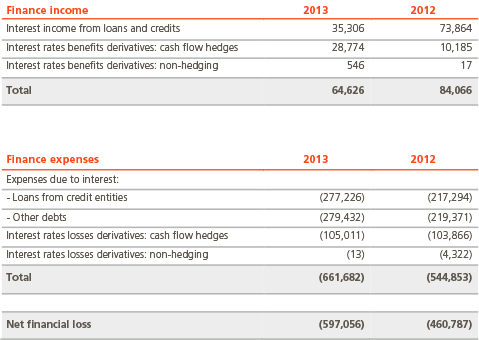
In 2013, finance income has decreased due to lower interest income from loans and credits in Brazil, partially offset by higher interest rates benefits derivatives as a result of income for the time value of interest rate options, that in the previous year was a loss classified in Finance expenses.
Interest expenses from loans with credit entities increased mainly due to the lower capitalization of interest expenses for financing projects under construction, thanks to various projects coming into operation. The interest accrued on other debt increased, mainly due to the new notes issued during 2013 (see Note 20.3).
In 2012 finance income decreased with respect to the same period of the previous year mainly due to lower interest income from loans and credits in Brazil.
Interest expenses from loans and credits have remained stable during 2012 compared to the previous year: amounts outstanding from non recourse financing have been higher during the year 2012 but capitalized interest have also been higher, as non recourse financing increased primarily to finance projects under construction and interest expenses is capitalized during the construction period. The increase in interest from other debts, mainly due to a larger volume in our non recourse factoring arrangements, has been practically offset by a decrease in losses from our interest rate derivatives.
The net financial expenses for non-recourse financing project companies is €-244,810 thousand (€-115,254 thousand in 2012).
30.2. Net exchange differences
The following table sets out the exchange rate differences for the years 2013 and 2012:

The most significant amounts in net exchange differences during 2013 correspond to the negative impact of the accumulated translation differences transferred to the Consolidated Income Statement and to different hedges in several subsidiaries that have not been offset perfectly with the differences generated by de hedged item.
The most significant amounts in net exchange differences during 2012 correspond to a loss from exchange rate derivatives recognized as a result of the interruption of the hedging relationship, when the transaction hedge is no longer expected to occur, to the negative impact of the accumulated translation differences transferred to the Consolidated Income Statement, to the termination of foreign exchange derivatives signed to hedge certain Brazilian transmission line concessions sold (see Note 6.2) and to different hedges in several subsidiaries that have not been offset perfectly with the differences generated by the hedged item.
Net exchange rate differences in 2013 for entities with non-recourse financing amounts to €-4,672 thousand (€-27,327 thousand in 2012).
30.3. Other net finance income and expenses
The following table sets out ‘Other net finance income and expenses’ in 2013 and 2012:
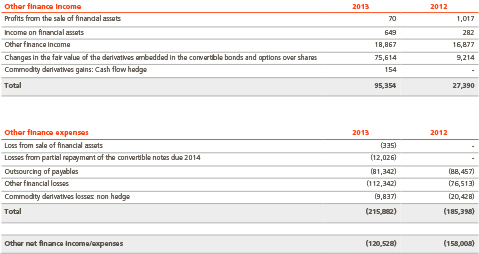
For the year ended December 31, 2013 the heading ‘Other finance income’ has increased when compared to the previous year, mainly due to the change in fair value of embedded derivatives of the convertible bonds, net of change in fair value of the call options over Abengoa’s own share, which hedge the embedded derivatives partially, amounting to a net gain of €75,614 thousand, see Note 20.3 (€9,214 thousand for the year ended December 31, 2012).
The heading ‘Other finance expenses’ has increased for the year ended December 31, 2013 compared to the previous year mainly due to losses from partial repayment of the convertible notes due in 2014 (see Note 20.3), the increase in other financial losses due to a higher volume of uncollectible financial accounts with related parties, according to the current situation of negotiations with them in developing projects in Latin America; and the impairment of financial investments associated with thermosolar projects in the USA, partially offset by lower costs of outsourcing supplier payments and lower commodity derivatives losses corresponding to the interruption of the hedging relationship, when the transaction hedged is no longer expected to occur. Additionally, ‘Other finance losses’ include finance expenses mainly related to financial guarantees and letters of credit, to wire transfers and other bank fees, losses on available for sale financial assets and other minor finance expenses.
In the year ended December 31, 2012 the heading ‘Other finance income’ mainly includes the change in fair value of embedded derivatives of the convertible bonds, net of change in fair value of the call options over Abengoa’s own share, which hedge the embedded derivatives partially, amounting to a net gain of €9,214 thousand (see Note 20.3). The remaining balance of ‘Other finance income’ corresponds mainly to interests from deposits and cash and cash equivalents related to our outsourcing of trade payables (see Note 25.3), which have remained stable period over period.
In the year ended December 31, 2012 in the heading ‘Other finance expenses’, expenses related to outsourcing of payables have increased with respect to a larger volume of payables outsourced during the period the prior year. Commodity derivatives losses correspond to the interruption of the hedging relationship, when the transaction hedged is no longer expected to occur. Additionally, ‘Other finance losses’ include finance expenses mainly related to financial guarantees and letters of credit, to wire transfers and other bank fees, losses on available for sale financial assets and other minor finance expenses.
The net of ‘Other incomes and financial expenses’ for Non-recourse financing project companies is €-47,671 thousand (€-33,607 thousand in 2012).
30.4. Non-monetary items of derivative financial instruments
The table below provides a breakdown of the line item ‘Fair value gains on derivative financial instruments’ included in the Consolidated Cash Flow Statement for the years 2013 and 2012:

Note 31.- Income tax
Details regarding income tax for the years 2013 and 2012 are as follows:

The reconciliation between the theoretical income tax resulting from applying statutory tax rate in Spain to income before income tax and the actual income tax expense recognized in the Consolidated Income Statement for the years 2013 and 2012 is as follows:
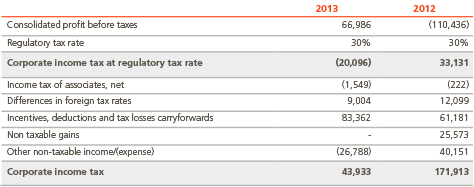
Differences between theoretical tax and actual tax expense arise mainly from:
- Companies based in jurisdictions with statutory tax rates different from Spanish statutory tax rate.
- Application in Spain of tax incentive for the transfer of use of intangible assets under Article 23 of the Revised Text of the Spanish Income Tax Act and application also in Spain of the tax incentive which exempts any profits generated abroad for international projects involving the export of goods and services from Spain. Generation of tax deductions, mainly in Spain, among which we can outline R&D&I deductions, double taxation deductions, deductions on training expenses and deductions on donation expenses. In addition, the Company recorded deferred tax assets for tax loss carryforwards generated in past years in other tax jurisdictions.
- In 2012, the Company has recorded no taxable gains corresponding to the gain obtained in the business combination achieved in stages over Rioglass Group.
- The heading ‘Other non-taxable income/ (expense)’ includes, among others, the regularizationn of the tax expense of the previous year as well as certain permanents differences arised in other jurisdictions as a consecuence of the adjustments in the valuation of assets and liabilities.
Note 32.- Earnings per share
As explained in Note 18, on September 30, 2012, the General Shareholders’ Meeting approved a capital increase in class B shares, charged to our freely available reserves, which were distributed for no consideration to all existing shareholders on the basis of four (4) class B shares for each class A share or class B share which they hold. Therefore, no dilution or further concentration with respect to our share capital occurred.
According to IAS 33, when ordinary shares are issued to existing shareholders for no additional consideration, the transaction is equivalent to a share split. In this case, the number of ordinary shares outstanding before the event is adjusted for the proportionate change in the number of ordinary shares outstanding as if the event had occurred at the beginning of the earliest period presented.
In addition, the average number of shares outstanding in 2013 has been calculated taking into account the capital increase carried out in October 2013 (see Note 18).
32.1. Basic earnings per share
Basic earnings per share are calculated by dividing the profit attributable to equity holders of the company by the weighted average number of ordinary shares outstanding during the period.

32.2. Diluted earnings per share
To calculate the diluted earnings per share, the average weighted number of ordinary shares issued and outstanding is adjusted to reflect the conversion of all the potential diluting ordinary shares.
The potential diluting ordinary shares held by the group correspond to the warrants on Class B shares issued in November 2011. The assumption is that all warrants will be exercised and a calculation is made to determine the number of shares that may have been acquired at fair value based on the monetary value of the subscription rights of the warrants still to be exercised. The difference between the number of shares issued assuming the exercise of the warrants, and the number of shares calculated based on the above, is included in the calculation of the income per diluted share.
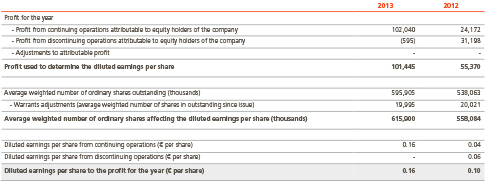
Note 33.- Other information
33.1. Average number of employees
The average number of employees classified by category during 2013 and 2012 was:
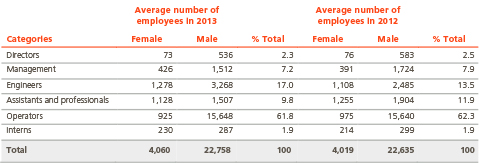
The average number of employees is 27% in Spain (29% in 2012) and 73 % abroad (71% in 2012).
The average number of employees during the year with disabilities above or equal to 33% is 107 (115 in 2012).
The total number of people employed at the end of 2013 was 24,748 (26,402 in 2012).
33.2. Related parties
The account held by Abengoa with Inversión Corporativa I.C., S.A., as of year-end 2013 and 2012 has a nil balance.
Dividends distributed to related parties during 2013 amounted to €17,182 thousand (€17,212 thousand in 2012).
During 2013 the only transactions associated with related parties were the following:
- Share lending agreement signed by Abengoa with Inversión Corporativa IC, S.A. for a total of 11,047,468 Class B shares in order to improve the liquidity in lending these shares to investors of the convertible bonds maturing in 2019. This loan was repaid in July 2013 with a consideration of €670 thousand.
- Service provision agreement signed between Centro Tecnológico Palmas Altas, S.A. and Ms. Blanca de Porres Guardiola, which involved a consideration of €72 thousand.
As indicated in Note 18.1, Inversión Corporativa is Abengoa’s main shareholder, and issues its own separate Consolidated Financial Statements.
These operations were subject to verification by the Abengoa Audit Committee and the consideration paid for the different transactions has been determined by third parties.
33.3. Employee remuneration and other benefits
Directors are remunerated as established in article 39 of the Bylaws. The remuneration of Directors is made up of a fixed amount as agreed upon at the General Shareholders’ Meeting, and is not necessarily equal for all directors. Additionally, they may participate in profit sharing programs, for a percentage between 5% and 10% (maximum) of the net income of the Company after the declaration of the dividends for the year. Travel expenses related to work undertaken by the board are reimbursed to Directors.
Salary (both fixed and variable) and allowances paid to the members of the Board of Abengoa S.A. in 2013 were € 15,421 thousand (€13,887 thousand in 2012).
Detail on individual salaries and benefits in 2013 paid to the Board of Directors are as follows (in thousands of Euros):
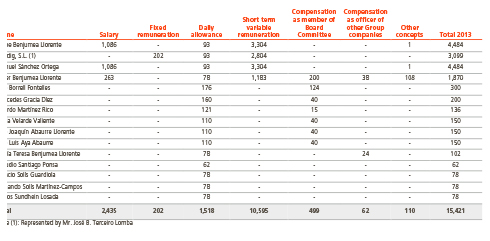
Detail on individual salaries and benefits in 2012 paid to the Board of Directors is as follows (in thousand of Euros):
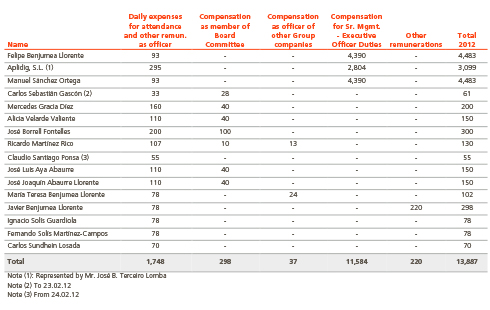
Additionally, in 2013 overall remuneration for key management of the Company (Senior Management which are not executive directors), including both fixed and variable components, amounted to €14,656 thousand (€13,574 thousand in 2012).
No advanced payments or credits are granted to members of the Board, nor are any guarantees or obligations granted in their favor.
As of December 31, 2013 there existed € 29,789 thousand in non-current personnel compensation obligations (€70,599 thousand in 2012).
33.4. On May 3, 2012 Mrs. Mercedes Gracia Díez was appointed as president of the Audit Committee.
33.5. In compliance with Royal Decree 1/2010 of July 2, that approves the Capital Corporations Law, the Company informs that no member of the Board of Directors of Abengoa, S.A. and, to its knowledge, none of the individuals related parties as referred to by article 231 in the Capital Corporations Law Act maintains any direct to indirect share in the capital of companies with the same, analogous or complementary kind of activity that the parent company’s corporate purpose, nor has any position in any company with the same, analogous or complementary kind of activity that the parent company’s corporate purpose. In addition, no member of the Board of Directors has accomplished any activity with the same, analogous or complementary kind of activity that the parent company’s corporate purpose.
As of December 31, 2013, members of the Board of Directors who are in turn directors or management in other subsidiaries included in the consolidation group are:

In accordance with the record of significant holding in the Company, and as required by the ‘Internal Rules and Regulations for Conduct involving Stock Exchange Matters’, the shares and the holding percentages of the Company Directors as of December 31, 2013 are:
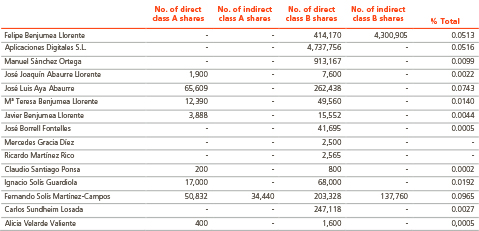
Throughout out 2013 and 2012 there was no evidence of any direct or indirect conflict of interest situation, in accordance with what is envisaged in Article 229 of the Capital Corporation Law.
33.6. Audit fees
The fees and costs obtained by Deloitte, S.L. and other auditors are the following:
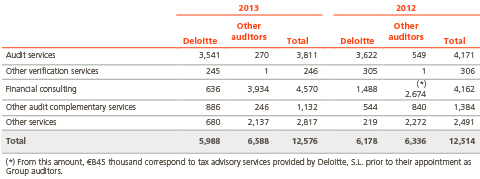
33.7. Environmental information
The principles of the environmental policies of Abengoa are based on compliance with the current legal regulations applicable, preventing or minimizing damaging or negative environmental consequences, reducing the consumption of energy and natural resources, and achieving ongoing improvement in environmental conduct.
In response to this commitment to the sustainable use of energy and natural resources, Abengoa, in its Management Rules and Guidelines for the entire Group, explicitly establishes the obligation to implement and certify environmental management systems in accordance with the ISO 14001 International Standard.
Consequently, by year-end 2013, the percentage of Companies with Environment Management Systems certified according to the ISO 14001 Standard per sales volume is 92.92% (91.98% in 2012).
The table below lists the percentage of distribution of the Companies with Certified Environmental Management Systems, broken down by business unit:

33.8. Subsequent events
After the end of the year 2013 and following the so-called “regulatory reform of the electric sector”, the Ministry of Industry, Energy and Tourism submitted to the National Competition and Markets Commission a proposal of Ministerial Order establishing a set of compensation parameters regarding energy-generation facilities from renewable sources, cogeneration and waste. Among other parameters, there are those related to benchmarks of investment and operation of thermosolar facilities (both solar power tower and parabolic-cylinder technology), photovoltaic and cogeneration plants of the Group. This new regulatory development, since it represents an additional evidence regarding some conditions that existed prior to the closing date of the financial year and, in particular, allows us to estimate future cash flows from the abovementioned facilities, has been taken into account when preparing these Financial Statements.
Since December 31, 2013, apart from what is detailed above, no other events have occurred that might significantly influence the information reflected in the Consolidated Financial Statements, nor has there been any event of significance to the Group as a whole.
© 2013 Abengoa. All rights reserved